SKILLS AND EMPLOYMENT IN STEEL
PLUS CIVMEC TAKES ON 2,000 TONNE SHIPLOADER AT HAY POINT COAL TERMINAL
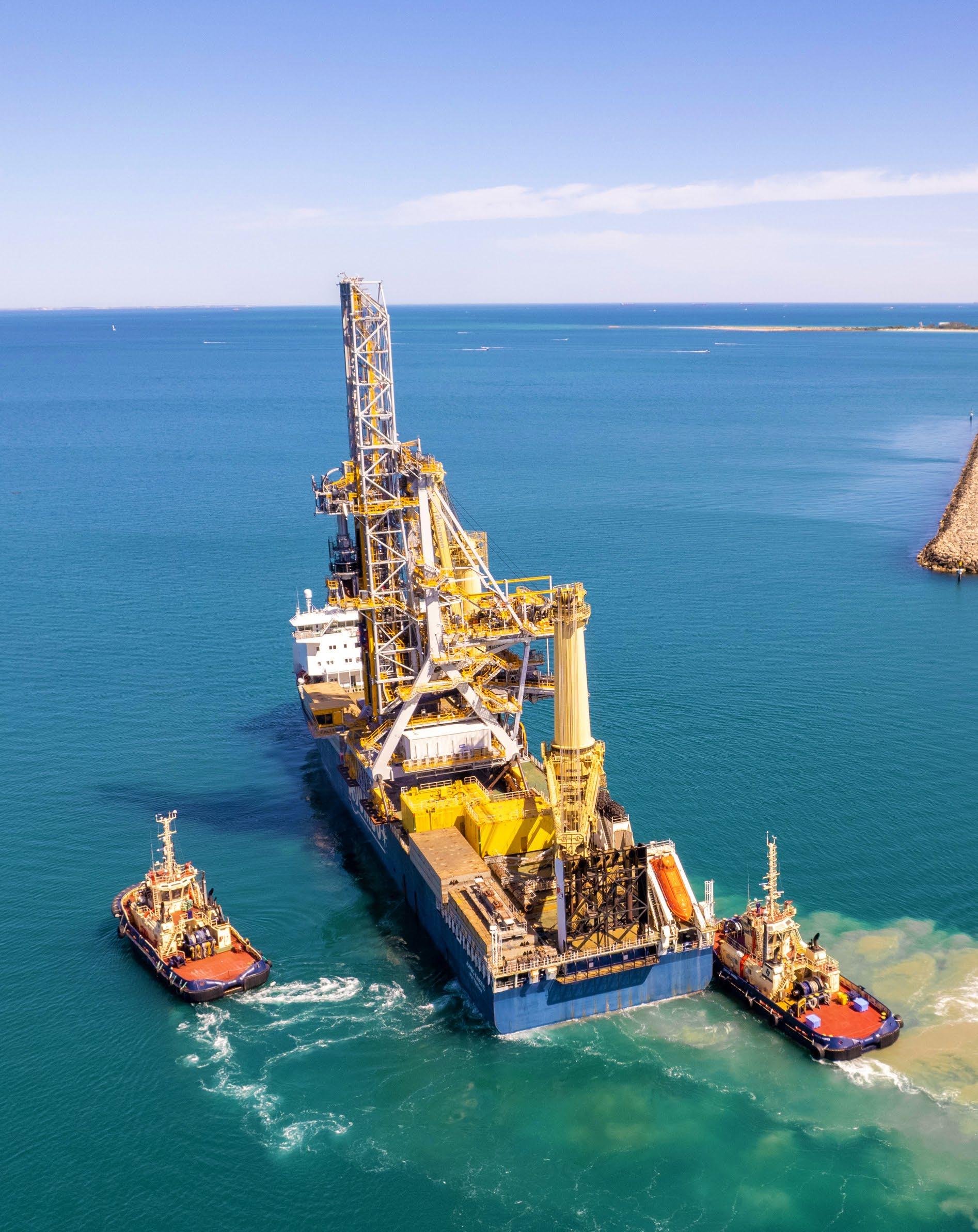
THE WESTERN PORT STORY: 50 YEARS OF PEOPLE AND STEEL PROCESSING
SOREL AWARDS: GALVANIZING EXCELLENCE
Autumn 2023 Vol. 36 | No. 1 ISSN 2208-7486 (online) ISSN 1447-5359 (print)
How AustralianSuper invests for members
opportunities from across the world and across different types of assets including:
Listed Shares
Owning listed shares means owning part of companies that are listed on a public exchange, like the Australian Stock Exchange (ASX). AustralianSuper invests in Australian and international companies.
Listed shares generally make money in two ways –through an increase in the share price and when companies pay dividends.
Private equity
Private equity involves investing in companies that are not listed on a public exchange like the ASX. AustralianSuper co-invests in private equity along with specialised private equity managers.
Unlisted infrastructure
Infrastructure investments are assets that provide essential public services.These include bridges, roads, airports and power plants. AustralianSuper’s portfolio includes large-scale infrastructure investments in Australia and international markets
Credit
Credit investments involve providing finance for an agreed period in exchange for a return.
AustralianSuper has a specialised team that invests in private credit opportunities directly in the property and infrastructuresectors.
Fixed Interest
Fixed interest investments provide income from interest payments. Fixed interest investments include bonds and debt issued by governments and companies.
Cash
Cash investments are short-term money market instruments. These are issued by banks, like the CBA, NAB and Westpac, governments and companies
Global diversification
AustralianSuper has investments throughout the world. This helps support Australia’s economy while members benefit from growth in local and international markets. Importantly, this global approach can help reduce investment risk through diversification.

For a comprehensive look at understanding where AustralianSuper invests, visit How we invest.
1. Thinking Ahead Institute, Global top 300 pension funds, September 2022.
Investment returns are not guaranteed. Past performance is not a reliable indicator of future returns. This information may be general financial advice which doesn’t take into account your personal objectives, financial situation or needs. Before making a decision about AustralianSuper, you should think about your financial requirements and refer to the relevant Product Disclosure Statement available at australiansupe r.com/pds or by calling 1300 300 273. A
australiansuper.com/tmd .
Market Determination (TMD) is a document that outlines the target market a product has been designed for. Find the TMDs
at
Sponsored
Pty Ltd, ABN 94 006 457 987, AFSL
Trustee of AustralianSuper ABN 65 714 394 898.
Target
by AustralianSuper
233788,
steel Australia
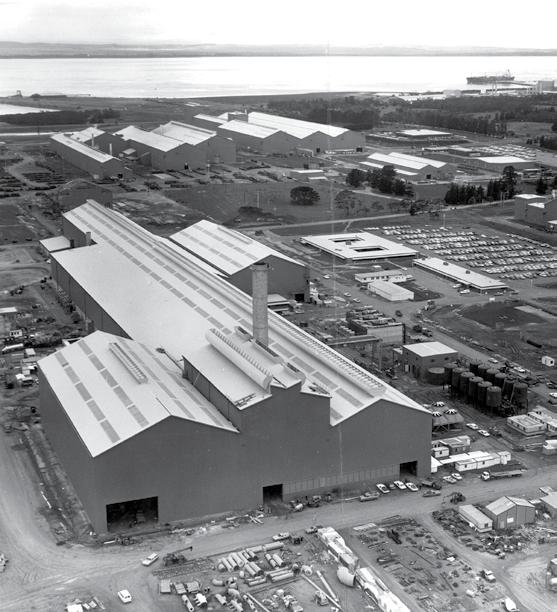

Vol. 36 No. 1 | Autumn 2023
ASI HEAD OFFICE
Suite G1, Ground Floor
25 Ryde Road
Pymble, NSW 2073
T: (02) 8748 0180
E: enquiries@steel.org.au
W: https://www.steel.org.au
ASI STATE OFFICES
New South Wales and ACT
David Varcoe on 0419 136 720
Victoria, Tasmania and South Australia
Sulfianda Soeleiman on 0437 594 571
Western Australia
James England on 0423 614 860
Queensland and Northern Territory
John Gardner on 0418 788 870
ShedSafe
Neil Creek on 0407 107 415
STEEL AUSTRALIA CONTACTS


Managing editor

Steve Andrew on 0473 480 964 or stevena@steel.org.au
Editor Sally Wood on sally@wordly.com.au
Advertising
NK Media, Nicole Prioste on 0410 618 331 or nicole@nkmedia.com.au
DISCLAIMER
While every effort has been made and all reasonable care taken to ensure the accuracy of the material contained herein, the Publisher does not assume any responsibility or liability for any loss or damage which may result from any inaccuracy or omission in this publication, or from the use of the information contained herein, and the Publisher makes no warranties, express or implied, with respect to any of the material contained herein.
COPYRIGHT
Reproduction of the material is permitted only with the express permission of the Publisher and due acknowledgment of steel Australia.

ABOUT THE ASI
steel Australia is published by the Australian Steel Institute (ASI)—the peak national body of the steel industry. The ASI works to increase the awareness of the benefits of steel and promote Australian made steel as the material of choice. Increasing the competitiveness of the Australian steel industry and its member companies is central to that vision. The organisation conducts engineering seminars and disseminates relevant, timely and detailed information. Expert technical advice, a library and a resource centre are available to all members, along with a range of other member benefits. For information, visit: steel.org.au
| STEEL AUSTRALIA | AUTUMN 2023 3
CONTENTS INDUSTRY INSIGHTS Message from the chair 5 Message from the chief executive 6 Maximising productivity and safety through automation 8 Navigating super during bull and bear markets 9 Steel Sustainability Australia 10 How to avoid bad debts 13 On the beam 15 The Western Port story: 50 years of people and steel processing 16 Digital foundation essential to the success of manufacturers 21 Civmec takes on 2,000 tonne shiploader at Hay Point Coal Terminal 22 Asset and equipment finance for growth 27 Sorel Awards: galvanizing excellence 28 An update from the Steel Research Hub 37 FEATURE: SKILLS AND EMPLOYMENT IN STEEL 38 Diversity and inclusion in attraction and retention 40 Life at BlueScope 44 How the GFG Alliance is shoring up a pipeline of skilled talent 45 Industry training initiatives help combat welder shortages 46 Attracting and retaining top talent is all in the details at DBM Vircon 48 Business sponsorship visas and procedures 50 Australian Apprenticeships Incentive System 51 ASI's skills and employment resources 52 INSIDE THE ASI New ASI members 54 ASI book shop update 55 Upcoming ASI events 55 16 10 28 Cover image: Civmec takes on 2,000 tonne shiploader at Hay Point Coal Terminal. Story on page 22. CONTENTS 38 52


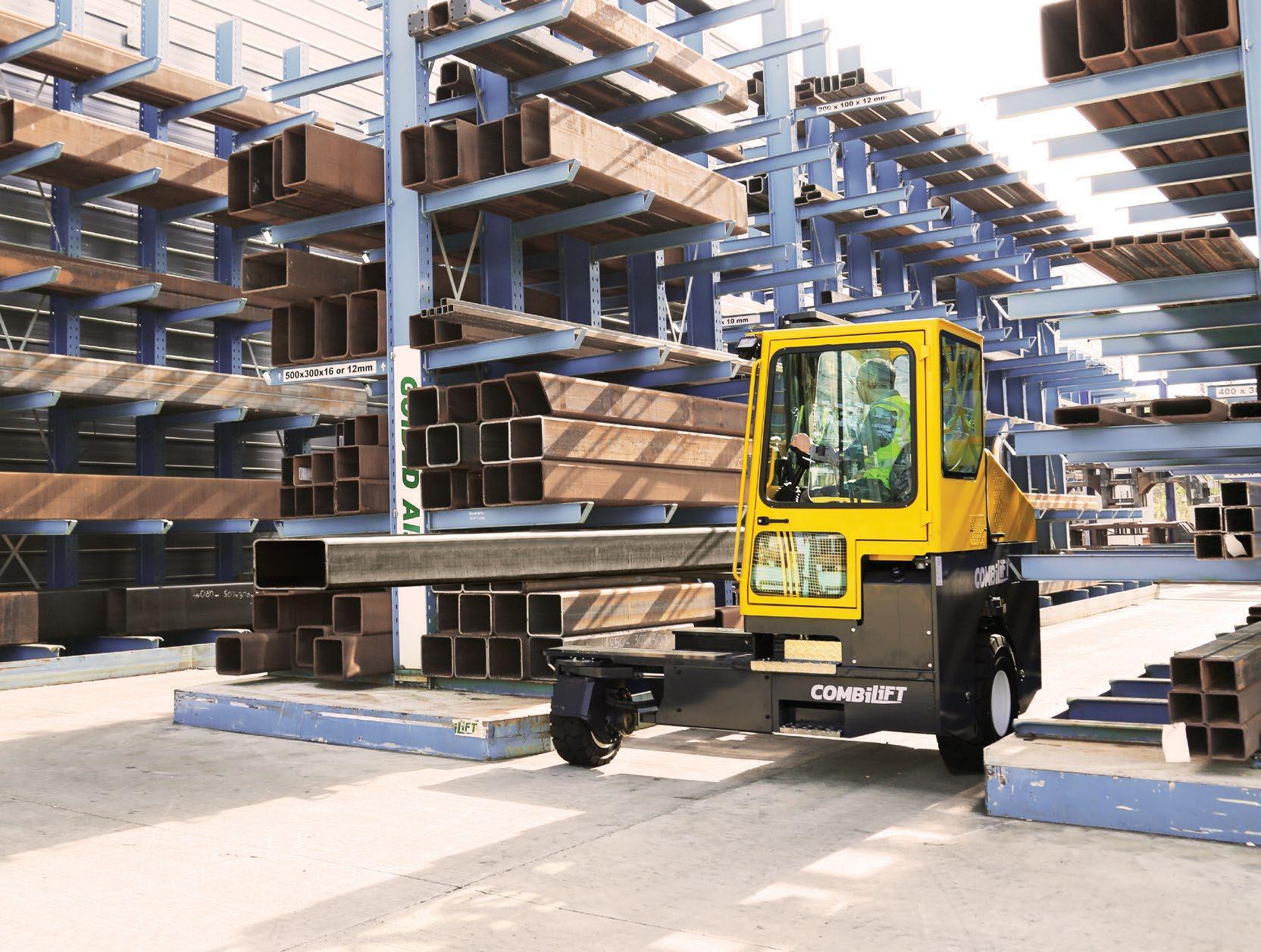

combilift.com Enhance the Safety, Capacity and Efficiency of Your Steel Facility Safety Storage Efficiency To find out how Combilift can help you unlock every inch of your storage space Contact Us Today Combilift is the perfect fit for the steel industry. Our multidirectional forklifts, straddle carriers and mobile gantry cranes are perfect for handling long product, allowing you to maximise your storage, efficiency and safety.
MESSAGE FROM THE ASI CHAIR

Welcome to the Autumn edition of steel Australia. The feature of this edition is Skills and employment in steel—a subject that I know much of the industry is concerned about.
The labour market is the tightest that many of us can recall. The number of occupations suffering from the skills shortage has almost doubled since 2021, with some roles having thousands of unfilled vacancies.
A recent McKinsey Global Institute study suggests that employers in developed economies worldwide are facing a shortfall of 45 million workers. Companies are unable to fill one in ten roles that they need, much less fill them with top talent.
Many businesses throughout the steel supply industry are operating at 90 per cent, 80 per cent or 70 per cent capacity due to the skilled labour constraints.
This skills shortage is unlikely to abate in the near term. This record high demand for skilled labour is being exacerbated by the flow-on effects of COVID-19, such as international border closures curtailing skilled immigration as well as an economic recovery that hinges on large-scale infrastructure projects.
The five-year pipeline of major federallyfunded infrastructure projects is valued at $237 billion. On top of this, countless skilled workers will be needed to build and install the wind and transmission towers, solar farms and other power generation assets needed to achieve the Federal Government’s 43 per cent emissions reductions target by 2030 and net zero by 2050.
There is a whole host of projects in defence, housing, agriculture, state government funded projects, and private developments—all of which depend upon skilled labour throughout the entire Australian steel supply chain. In addition, with initiatives such as the Modern Manufacturing Strategy, and an ever growing focus on technology and innovation in general, the need for skilled labour is expected to grow.
As an industry we must adapt to this situation and find innovative ways to attract and retain critical skills.
We must come together with imaginative programs to enthuse and motivate
those coming through high schools, our technical colleges, and our universities to aspire to careers across our industry.
We need to encourage young people to work in the steel industry. As an industry, we need to demonstrate that there are ample, wide-ranging opportunities for young people in steel—not only are there growth opportunities, but there is a high degree of job security, flexibility and a raft of other benefits.
We need to demonstrate that our industry embraces emerging technologies as a matter of course. This is because we are always seeking to enhance our competitiveness and our relevance to the needs of the communities that we serve. This continuous improvement mindset— that sees us all strive to be faster, stronger and better as an industry— creates a dynamic environment in which career options abound.
As an industry, we need to diversify our skills base, and seek to encourage better, more inclusive pathways into a career in steel for under-represented demographics such as women, First Nations people and people living with a disability.
Australia’s future economic prosperity depends on its development of a highly skilled workforce capable of building globally competitive industrial and commercial enterprises. We all have a role to play in strengthening the steel workforce of tomorrow.
| STEEL AUSTRALIA | AUTUMN 2023 5
INDUSTRY INSIGHTS
Tony Schreiber (Chair, Australian Steel Institute)
“ We need to encourage young people to work in the steel industry. As an industry, we need to demonstrate that there are ample, wideranging opportunities for young people in steel—not only are there growth opportunities, but there is a high degree of job security, flexibility and a raft of other benefits. "
MESSAGE FROM THE ASI CHIEF EXECUTIVE
SKILLS AND EMPLOYMENT IN STEEL
The feature of this edition of steel Australia magazine is Skills and employment in steel
Australian businesses—including those throughout the steel supply chain— are facing the tightest labour market since the 1970s. With skills shortages impacting everything from productivity, through to economic growth, businesses are implementing a raft of innovative recruitment, retention, upskilling and training programs. The ASI is looking at a range of initiatives to boost skills in the industry and encourage the next generation of workers to consider a career in steel.
As part of the South Australia Skills Strategy - Steel Industry Reference Group (facilitated by the Department of Education) initiatives, ASI is developing a set of promotional material for Careers in Steel, including presentations, videos and brochures which will be made available for ASI members to use.
In Tasmania, we will be collaborating with the Tasmanian Minerals, Manufacturing and Energy Council (TMEC) to jointly promote careers in trades across the steel and manufacturing industries.
In February, the ASI provided a letter of support to University of Wollongong (UOW) for a funding application under the Federal Government's Women in STEM and Entrepreneurship grants. The funding will support the LIFT program— an important step in addressing the barriers to participation and retention of women entering STEM industries within Australia. This funding application was successful, and the ASI is in discussion with UOW in regards to delivering the practical support committed.
The ASI has established a Diversity and Inclusiveness Group, which recently held its first meeting. Four people provided an overview of the strategies they have employed to create a more diverse and inclusive workplace, whilst others shared some brief experiences on the topic. The output from the meeting will be used to create resources for ASI members. For further details, see the article on page 40 In response to member feedback, we
are facilitating industry-led training and certification programs designed to develop much-needed skills and expertise in various aspects of steel manufacturing, assembly and installation. Just some of these training initiatives include courses for roll forming, steel detailers, shed builders and an introduction to steel. For further details, see the article on page 52.
With Australia’s borders now re-opened, businesses can take advantage of various business sponsorship visas. ASI has also developed a resource pack to help members. For further details, see the article on page 50
AUSTRALIAN STEEL CONVENTION
Steel as the preferred building material and why you should Choose Steel as a career will be key themes at this year’s Australian Steel Convention at Sofitel Melbourne from 10 to12 September 2023. The 2023 Convention will present the ASI Choose Steel campaign – an exciting promotional campaign putting steel at the forefront of the public eye as Australia’s preferred building material -
and how you can get involved with your steel solutions.
A young achievers panel will share their career stories - and help shape a new ASI ‘careers-in-steel’ strategy. Plus, project case studies will be back by popular demand, showcasing the innovative solutions across a myriad of project applications and steel product groups. For further information, click on the link included below.
ADVOCACY WORK
The ASI continues to advocate on behalf of the Australian steel supply chain on key issues. Energy pricing and security of supply are critical issues for a tradeexposed industry such as Australia’s domestic steel value chain. We continue to work with all levels of government to address these issue.
In the wake of the announcement of the Energy Price Relief Plan, which includes temporarily capping the price of gas and coal, ASI sought feedback from several members. As a result, we provided feedback to Warren Tegg
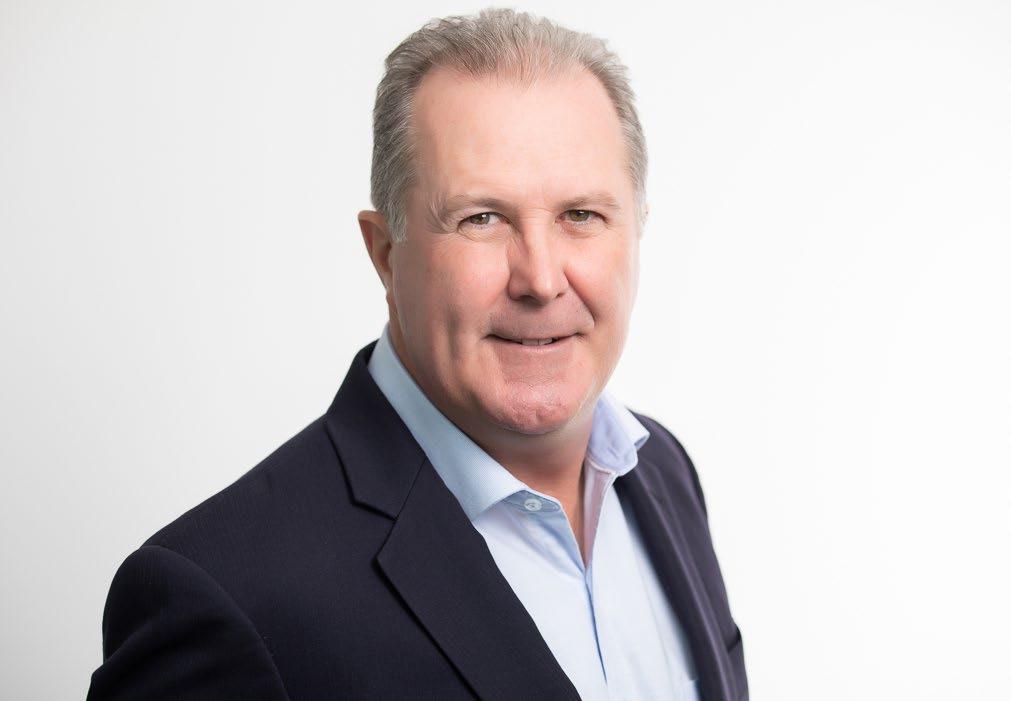 Mark Cain Chief Executive Australian Steel Institute
Mark Cain Chief Executive Australian Steel Institute
CLICK HERE FOR MORE INFORMATION ON THE 2023 AUSTRALIAN STEEL CONVENTION >>>
(advisor to Minister for Industry and Science, Ed Husic) and David Crawford (Heavy Industry Team, Department of Industry, Science and Resources), indicating manufacturing industry support for these measures.

We also met with the Anti-Dumping Commissioner, Dr Brad Armstrong and senior staff from the commission to discuss steel industry matters and the investigations process.
ASI facilitated a meeting with Infrastructure South Australia on the Northern Water Project. The purpose of the meeting was to highlight that the steel requirements for the project can be fulfilled locally using Australian steel. The project will include 127,500 tonnes of steel pipe (480km) of various diameters and thicknesses over a three year timeframe. Construction is expected to commence mid-2024.
We also presented to the Star of the South offshore wind farm project forum in Traralgon. Once again, highlighting the capacity and capability of the local steel industry to undertake the project.
Work is in progress on the next edition of the Victorian Steel Directory which was first published in 2019. The directory will be expanded to encompass distributors, roll formers and reinforcing.
PROMOTING A SUSTAINABLE STEEL INDUSTRY


We recently attended the Federal Government's Department of Industry, Science and Resources consultation on the National Reconstruction Fund's (NRF) Value-add in resources group. The Federal Government has earmarked $1 billion for this priority area for development of technologies such as on shore processing of lithium, and recycling of ‘red mud’ residue from bauxite refining. ASI provided a submission on the NRF Corporation Bill 2022.
The key recommendations were that the Federal Government should: declare the Australian steel industry as being a priority area of the Australian economy; and make a direction that $3 billion will be available for investment in the Australian steel industry. This will enable the steel industry to play its part in delivering a net zero economy whilst ensuring the development of a sovereign and sustainable steel industry.
The ASI was invited to attend the Commonwealth Department of Climate Change, Energy, the Environment and Water Adaptation and New Industries Division roundtable meeting. The purpose of the roundtable was to discuss the design of the new $130 million Carbon Capture Technologies program.
STEEL SUSTAINABILITY AUSTRALIA
Steel Sustainability Australia (SSA) opened for applications at the end of January 2023. SSA offers a new certification program that provides a clear pathway for steel businesses to operate more responsibly and transparently while being part of an environmentally and socially sustainable future.
Several organisations have already applied for certification, with the audit process underway. The SSA team has been working with several steel distributors, manufacturers, roll formers and reinforcing steel suppliers on developing business cases and multisite certification.
The SSA program was developed by the Australian Steel Institute (ASI). Superseding ASI’s Environmental Sustainability Charter (ESC), the SSA program engages the entire steel value chain by certifying downstream steel businesses such as fabricators, roll formers, and reinforcing processors, and verifying upstream steel producers against best practice environmental, social and governance (ESG) indicators aligned to the principles supporting the Green Building Council of Australia’s (GBCA) Responsible Product Framework. For further information, please see the article on page 10
| STEEL AUSTRALIA | AUTUMN 2023 7 INDUSTRY INSIGHTS
MAXIMISING PRODUCTIVITY AND SAFETY THROUGH AUTOMATION
FICEP'S VALIANT AND KATANA SYSTEMS
A world leader in the production of automatic systems for the steel construction industry, FICEP has designed, manufactured and installed more than 150 fully automatic layouts in different configurations worldwide.
FICEP offers key technology for the steel industry. Their VALIANT drilling centre, for beams up to 1,200mm, guarantees top production performance in the processing of all profiles used in civil and industrial steel constructions. Similarly, FICEP's KATANA band saw can carry out extremely fast, high quality operations when processing profiles with up to 60° mitred cuts. When the VALIANT is combined with the KATANA sawing machine and integrated with advanced automatic handling systems (such as roller conveyors and cross transfer tables), productivity is dramatically increased, as is safety for operators.
Moreover, by shifting employees away from strenuous and dangerous work, automation helps to address another critical issue faced by the industry: the shortage of skilled personnel. By automating production processes, industry can alleviate some of the unpredictability associated with the employment market. In addition, the workforce can be redeployed into higher value-added tasks.
The automation of processes improves productivity and speed, and therefore time-to-market. It can also have a positive impact on the quality, precision, accuracy and repeatability of manufacturing processes.
The VALIANT drilling centre
VALIANT represents the latest evolution in Ficep's drill line range. VALIANT can position the beam and perform all programmed processes without the need for repositioning. The new extended sub-axis spindle positioning enables simultaneous drilling on all three surfaces even when the holes are not aligned. It can be equipped with three automatic 14-position tool changers, one for each spindle, which provide superior performance and a significant reduction in cycle times.
FICEP's revolutionary new Direct Drive spindles transmit 100 per cent of motor power to the tool. This offers maximum


processing performance, meeting even the most demanding requirements and heavy-duty cycles with great efficiency.
Multi-functionality and versatility are among the most appreciated aspects of VALIANT. For example, the four axis underside scribing device with sub-axis positioning enables simultaneous scribing of up to four sides. With other processes like tapping and countersinking readily available, VALIANT reduces man hours while increasing productivity.
VALIANT can be used for all the typical milling routines (such as slots and block copes). It can also undertake weld preparation, including the drilling of rat holes, greatly reducing or eliminating secondary processes at the ends of beams. This increases the precision of the beam joint, eliminating the subsequent manual finishing phase. VALIANT requires only one operator to carry out several operations yet is also flexible to allow manual intervention to be bypassed completely when required.
The KATANA band saw system
VALIANT automatic systems can be supplied 'stand-alone' or combined with the KATANA band saw system. KATANA has a closed loop feedback, making it one of the fastest in the market. KATANA can perform high quality cuts up to 60° mitred cuts in both directions. KATANA is integrated with an automatic unloading device with a magnet that allows the processed short pieces to be unloaded automatically. This is performed without the intervention of an operator. As such, workers no longer need to handle the steel members, which can be particularly dangerous given their size and weight.

Pegaso CNC

Both the VALIANT and KATANA can be controlled by a single numerical control developed in-house by FICEP: Pegaso. Pegaso guarantees better performance and a substantial reduction in cycle times. Pegaso is equipped with a powerful processor, expanded memory, up to 15 controlled axes and multiple communication protocols (Canbus, Profinet, Ethercat). It also comes with an innovative, easy-to-use Office technology central offline programming software.
Thisarticleispartofapaidadvertisingpackage.
NAVIGATING SUPER DURING BULL AND BEAR MARKETS
Not sure what terms like bull markets and bear markets mean? Understand what they are and how it can impact your super.
The finance industry and investment markets can be complicated, with the language used equally hard to understand. Let’s simplify some common terms and look at how different share market conditions may affect your super.
What is a bull market?
A bull market happens when investor confidence is strong, with share prices rising faster than average over a consistent period. Bull markets typically, but don’t always, occur alongside periods of strong economic growth, with investors attracted to the potential of higher returns.
The term ‘bull market’ takes its name from the upward shape of an attacking bull’s horns, representing a rising market. The bull symbol has also become famous thanks to the bronze bull sculpture located in New York’s Financial District.
What is a bear market?
A bear market happens when share market prices are falling and there’s a drop in investor confidence. It’s typically
driven by a poor economic outlook. Bear markets are often linked to major economic downturns, such as the Great Depression in the 1930s and the Global Financial Crisis in 2008-2009.
It's thought the term originated with American bearskin traders, who would gamble that the price they pay for skins would continue to fall. Another explanation is that it’s simply a reference to the way a bear attacks, with claws shaped in the downward direction of the share market.
Super in bull and bear markets
If your super is invested in an option that includes shares, your super balance can follow the ups and downs of the share market:
• During a bull market, where investor confidence is strong and the share market value is rising, your super may grow too.
• In a bear market, with share prices falling and investor confidence weak, your super may experience a fall in value.
In periods of heightened market volatility, remember, super is a longterm investment. While it can be tempting to switch options when markets become volatile, being invested in a diversified portfolio over the long run can help grow your super.
Need advice?
If you’re concerned about changes to your super balance and the impact on your retirement plan, consider speaking to an accredited financial adviser. Speaking to an adviser can help you review your retirement goals and consider your investment options1

Find a financial adviser at https://www.australiansuper.com/ tools-and-advice/your-advice-options
1 Personal financial product advice is provided under the Australian Financial Services Licence held by a third party and not by AustralianSuper Pty Ltd. Fees may apply.
This information may be general financial advice which doesn’t take into account your personal objectives, financial situation or needs. Before making a decision about AustralianSuper, you should think about your financial requirements and refer to the relevant Product Disclosure Statement available at australiansuper.com/pds or by calling 1300 300 273. A Target Market Determination (TMD) is a document that outlines the target market a product has been designed for. Find the TMDs at australiansuper.com/tmd.
Sponsored by AustralianSuper Pty Ltd, ABN 94 006 457 987, AFSL 233788, Trustee of AustralianSuper ABN 65 714 394 898. This article was supplied as part of a paid advertising package.
| STEEL AUSTRALIA | AUTUMN 2023 9
INDUSTRY INSIGHTS

environmental and social impact.
• Developed by sustainability leaders: the SSA certification program was developed with thinkstep-anz, one of the region’s leading sustainability consultancies.

• Green Star Points: SSA certified suppliers contribute varying Green Star Credit points* on a Green Star project.
• Responsibly sourced products: ensures the steel supply is responsibly sourced from manufacturers that are actively managing the environmental and social impacts of their steel manufacturing operations.
• Best practice for ESG performance: certifies compliance to ESG sustainability indicators across the entire steel value chain in one program, setting a best practice sustainability standard for steel suppliers and their products.
• Backed by ASI: backed by the Australian Steel Institute, the peak industry body representing the entire steel supply chain, who manage a range of other compliance solutions including SCA and ShedSafe.
• Independently audited: certification to the SSA program is assessed by independent auditors.
*RefertotheGBCAwebsiteforfurtherinformationontheGreenStarprogram
Levels of certification
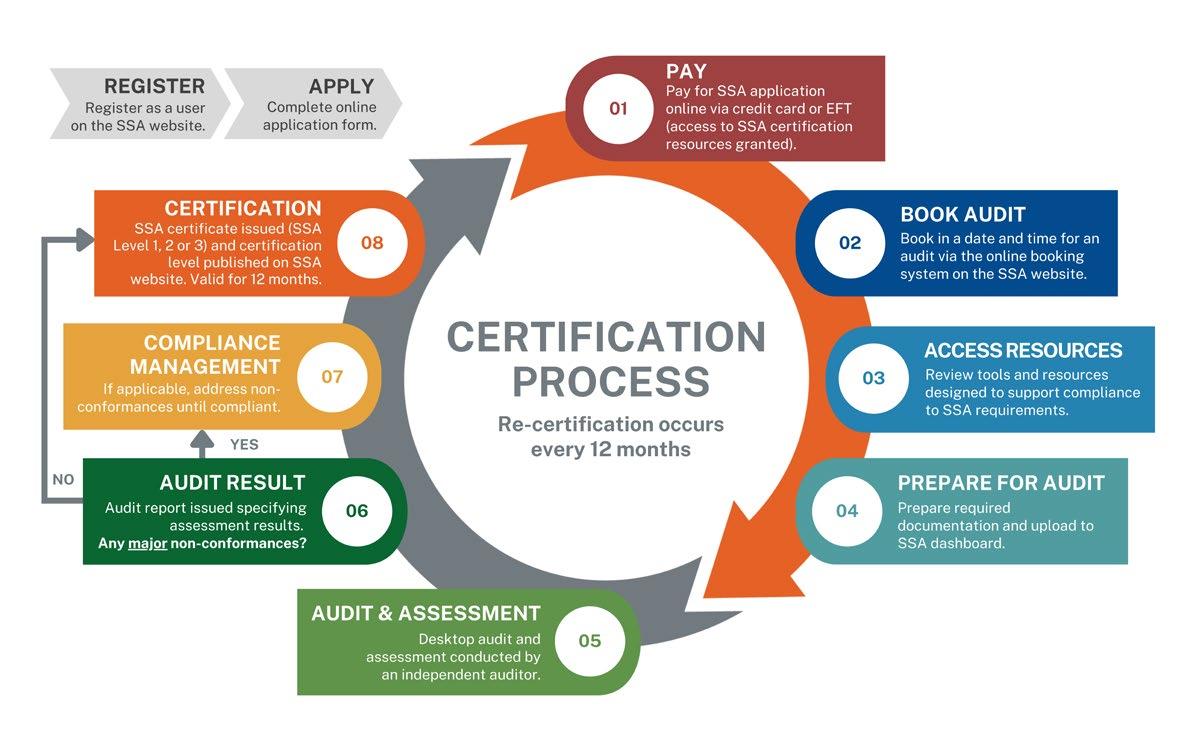
The SSA program is a recognised initiative under the GBCA Responsible Products Framework (RPF). The SSA certification program assesses compliance to a mix of environmental, social and governance (ESG) criteria and provides 4 pathways (L1, L2A, L2B, L3) to achieve certification. Certification to each SSA level has corresponding Responsible Product Values (RPVs) that meet the requirements of the 4 Green Star Responsible Products Credits under the ‘Responsible’ category in the Green Star Buildings rating tool.
Level 1: The entry level of SSA certification (4 RPV) can be combined with other valid certifications to achieve Green Star credits.
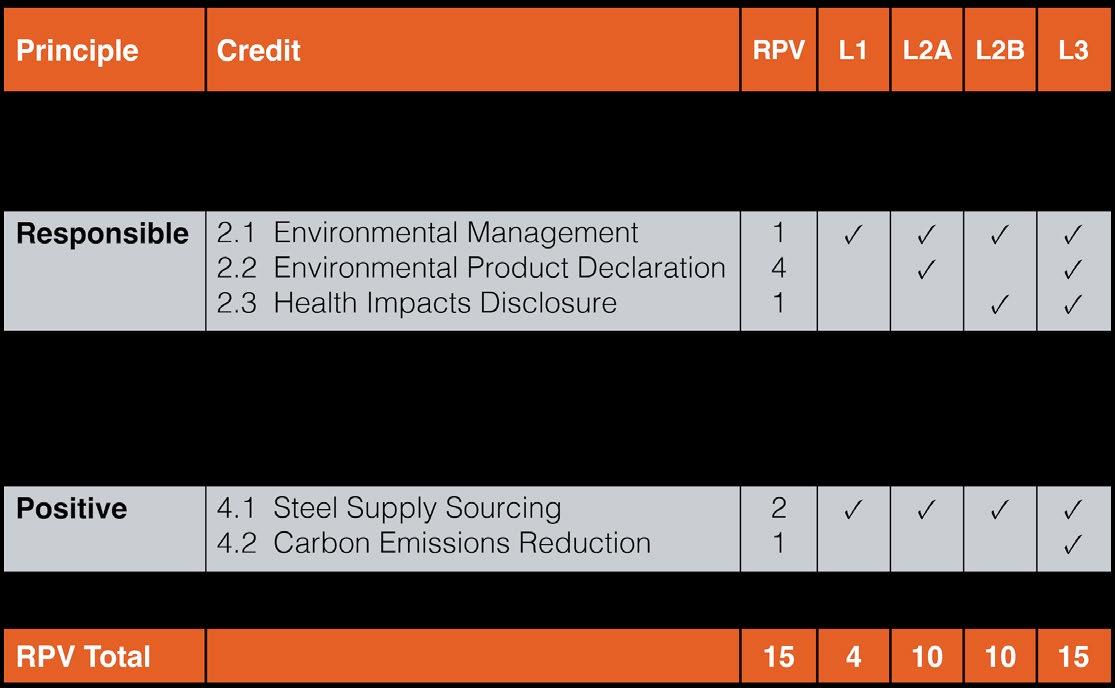
Level 2: Achieves ‘good practice’ recognition (10 RPV) and offers two pathways to comply; 2A certification, where a verified product-specific EPD can be provided and 2B certification, where a verified EPD cannot be provided.
Level 3: Aspirational level of certification assesses extended compliance requirements to achieve ‘best practice’ recognition (15 RPV) under GBCA’s Responsible Products Framework.
Application process
SSA applicants are subjected to an annual, site-based desktop audit conducted by an independent auditor to assess compliance to the requirements relevant to the chosen level of certification (SSA L1, 2A, 2B or 3). The audit assesses the management systems, and on-site operations and practices in manufacturing the finished steel product.
Recognition of ESC certification
As of January 2023, SSA has replaced ESC. For suppliers with current ESC certification, specifications calling for ESC may still be in place (and valid) for pre-existing projects until ESC certificate expiry (no later than 30 June 2023).
FOR FURTHER INFORMATION:
Contact Jerusha Beresford (ASI Sustainability Manager) on ssa@steel.org.au or 0419 253 016
| STEEL AUSTRALIA | AUTUMN 2023 11 INDUSTRY INSIGHTS
OR CLICK HERE TO VISIT THE SSA WEBSITE FOR FURTHER DETAILS >>>
The 5 star rated 300 George Street in Brisbane "A key factor in Multiplex’s selection of Beenleigh Steel Fabrications for the structural steel subcontract was the fact they are a Gold Member of the ASI’s Environmental Sustainability Charter." (Multiplex)
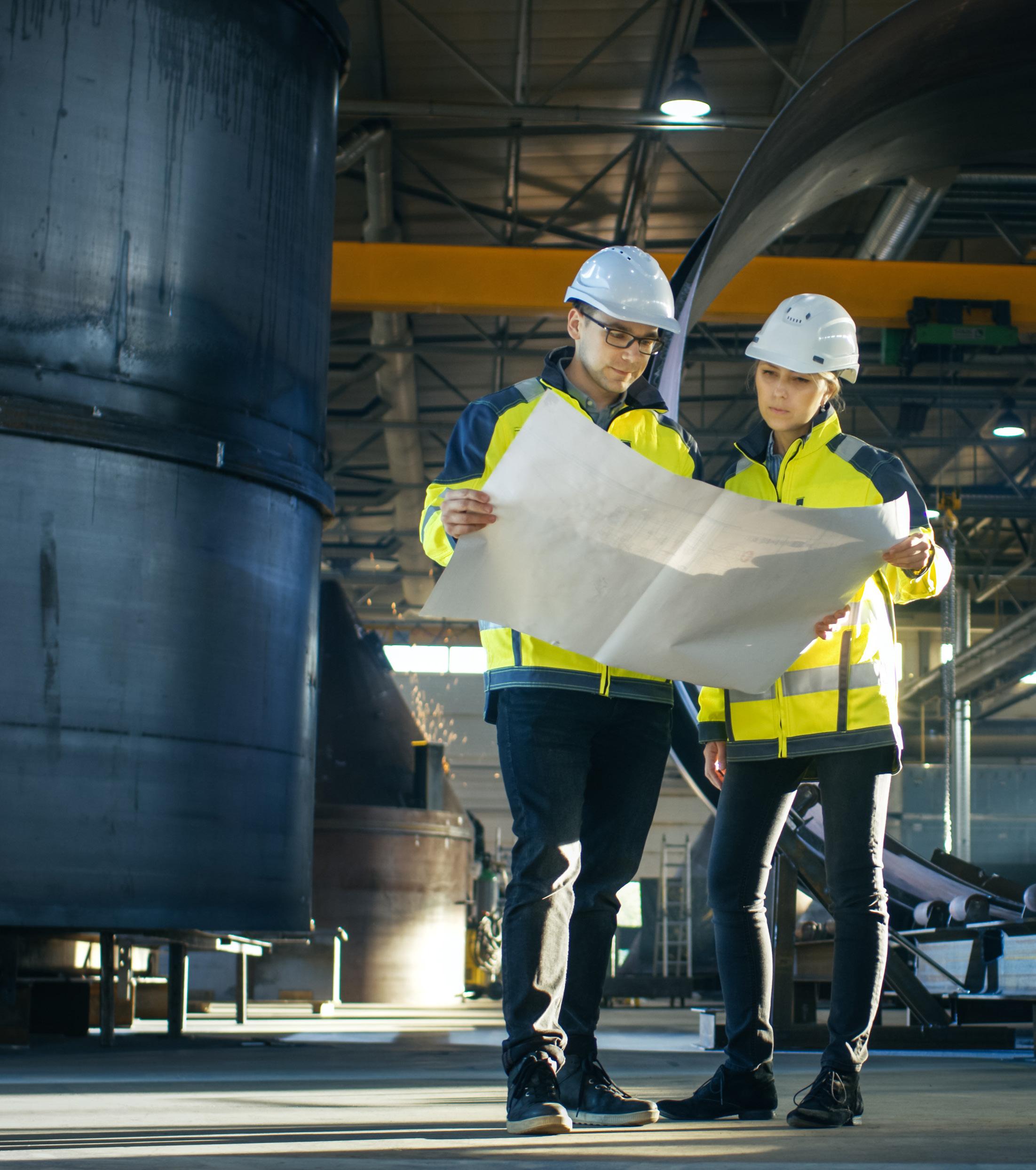
NCI supports $2Bn+ of trade credit sales in the steel industry. We specialise in all things trade credit related. We’re here to help your business grow and to protect you from potential bad debts. 35 years of experience Australia wide coverage ADELAIDE | BRISBANE | CANBERRA | MELBOURNE | PERTH | SYDNEY Want to talk? Contact us at 1800 882 820, info@nci.com.au or visit nci.com.au.
HOW TO AVOID BAD DEBTS
Getting paid on time is essential for managing cash flow and establishing a profitable business. And while staying on top of unpaid invoices helps, there may be times when a customer can’t or won’t pay. Tight credit control is your first line of defence in maintaining your company’s financial health.
Many businesses are shocked when they receive a letter from a liquidator advising one of their customers has become insolvent and they won’t be paid.
The trade receivables of a business can often be its largest asset. They are also the greatest generator of cashflow and ability to pay suppliers.
Therefore, why are some simple steps not taken to ensure you avoid those trade receivables turning bad?
These steps can be easily implemented, either in-house or using an external party, and will protect your business against the risk of a bad debt.
Steps to avoid receivables turning bad
Some simple steps that can help avoid receivables turning bad include:
1. New credit assessment: when establishing a new credit account,
ensure you have effective in-depth procedures to onboard a new customer.
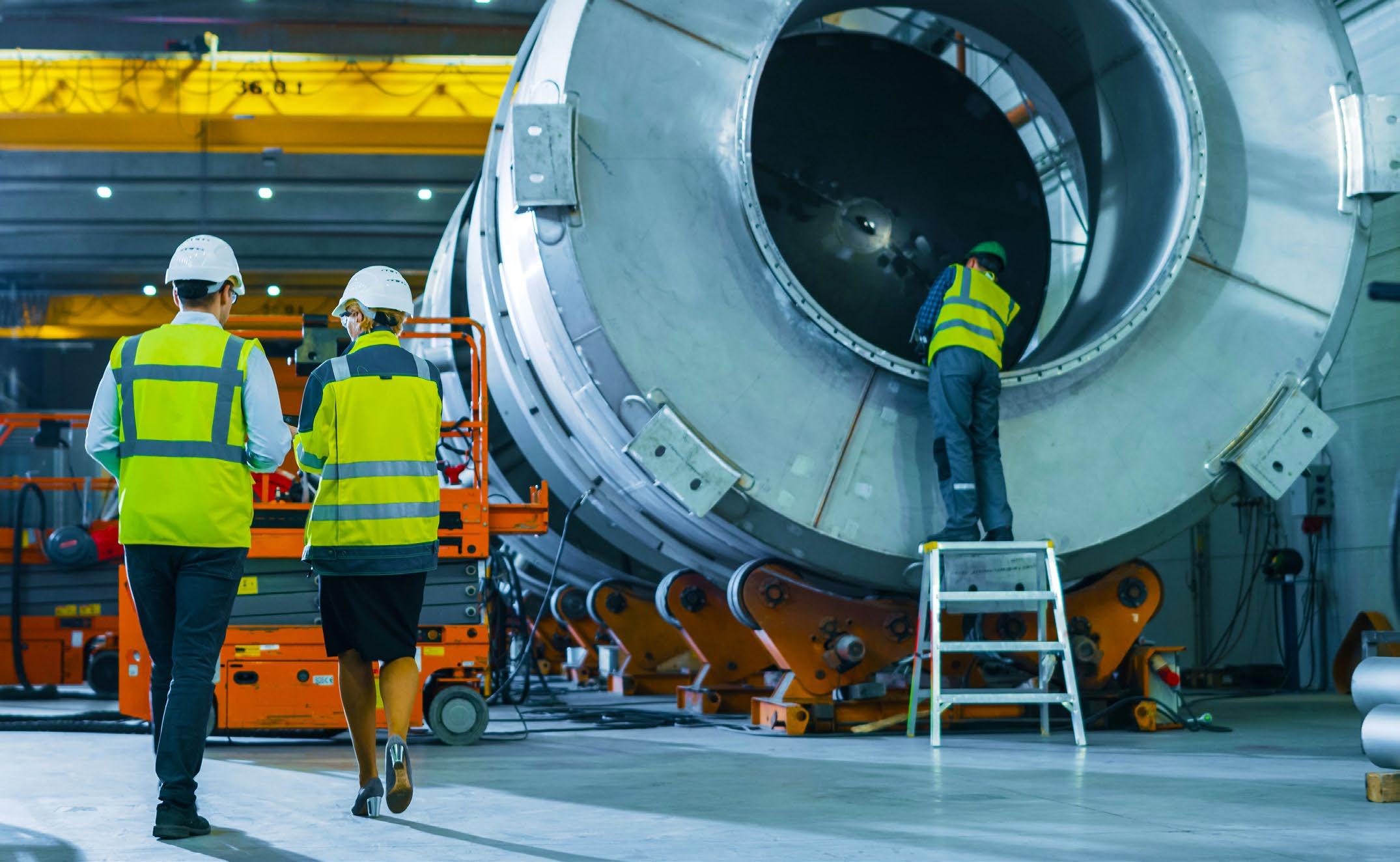
2. Terms and conditions of sale: make sure you have terms and conditions of sale that are up-to-date and allow you to recover your goods or outstanding monies, when invoices are not paid.
3. Overdue collections: when an account becomes overdue, make sure you have a robust process in place to initiate recovery action and follow it through.
4. Security: ensue you register your security rights over the goods you’re supplying on the Personal Property Securities Register (PPSR).
5. Trade Credit Insurance: for a very small outlay (typically between 0.1 per cent and 0.6 per cent - of your credit sales) credit insurance can return to you up to 90 per cent of the amount you are owed when a customer becomes insolvent.
These simple steps will reduce the likelihood of your business suffering from a bad debt or, in the event your customer becomes overdue, ensure you are best placed to take action or receive a payment through your credit insurance policy. No one goes into business to develop, market and sell goods and
services to not be paid. Make sure your business has the best processes to ensure you don’t lose out.
As a FREE offer for ASI members, NCI will wash your current customer list against our database and advise any current adverse information on your clients. We will also provide a snapshot report on your top five credit risks including the level of credit we would recommend.
NCI's trade credit services
NCI, with our full range of trade credit services, can support businesses in preparing and sleeping better at night, by removing the worry relating to predicting, and protecting yourself against, non-payment or insolvencies.
NCI’s unique database, and ‘secret intel’ can provide a business with early warning signs specific to your customer list. We alert you to those customers who may not be in a position to pay into the future and allow you to make early changes to avoid non-payment and bad debts into the future.
As a FREE offer for ASI members, NCI will wash your customer list against their database and advise any current adverse information on your clients. NCI will also provide a snapshot report on your top five credit risks including the level of credit they would recommend.
| STEEL AUSTRALIA | AUTUMN 2023 13
INDUSTRY INSIGHTS
CLICK HERE TO LEARN MORE ABOUT NCI'S TRADE CREDIT SERVICES >>> FREE OFFER FOR ASI MEMBERS
This article was supplied as part of a paid advertising package.
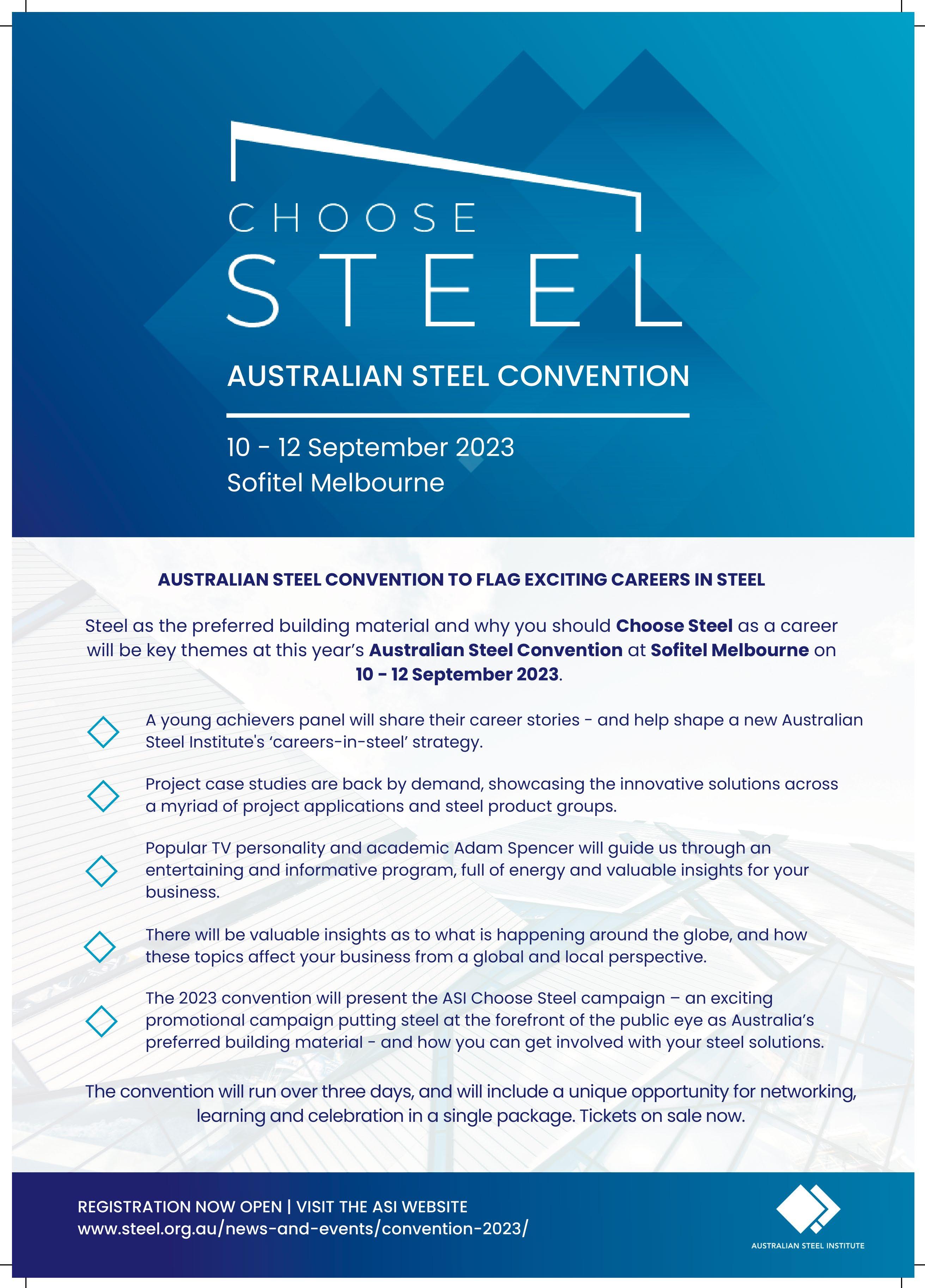
ON THE BEAM
Each quarter, the Australian Steel Institute (ASI) brings you news and views from around the steel industry in our regular column: On the Beam. From projects won and completed, through to new product launches and company announcements, you can find it all here.

Restating the role of nature in the built environment
Industry leaders across the building and construction sector are coming together to restate the role of nature and biodiversity in the built environment. The Green Building Council of Australia (GBCA) recently released Building with Nature 2.0, the first step toward developing a roadmap for building with nature that can be adopted by industry. Building with Nature 2.0 consolidates the latest science and global trends, research, policies, and views from industry, and will be used to inform the nature roadmap which will be released in 2024.
GBCA chief impact officer Jorge Chapa said the industry is at a critical turning point when it comes to protecting and enhancing nature and biodiversity. “Nature and biodiversity can no longer be an add-on to projects. When we incorporate it into our early planning for building projects we can enhance biodiversity, reduce emissions and create a healthier environment for people and our planet."
“While many in industry are already leading the way in this space, we don’t yet have a consistent global approach to measuring nature impacts so that we can accurately assess outcomes. We want to ensure that industry is supported in making good choices for nature management so that we can work together to restore and regenerate nature and biodiversity, and reduce our future impacts,” Chapa said.
BlueScope Distribution strengthens processing capability
BlueScope Distribution has announced the installation of a new CNC flatbed router at their Clayton South warehouse in Melbourne. Commissioned in February 2023, the addition of this new capability will complement its existing aluminium routing capability which already exists at BlueScope Distribution in Perth and Brisbane.
As one of the largest of its kind in Victoria, this new machine has the ability to profile complex custom shapes with precision, ease and accuracy, from large format aluminium plate and sheet up to 12.5m long, 3.2m wide and 150mm thick. The extra-large bed allows BlueScope Distribution to supply a single processed 12-metre sheet, creating efficiencies for its customers by reducing the need for welding multiple sheets in their own production lines. BlueScope Distribution has said its increased capabilities will better serve customers across a wide range of manufacturing industry segments, such as transport, marine, architectural façade, and leisure.
Steel Mains to manufacture extra large water mains in WA
Extra-large steel water pipes will be produced in Western Australia for the first time by Steel Mains under a $58 million Water Corporation contract, supporting local jobs and manufacturing in Kwinana.
Water pipes spanning 1,600mm in diameter will be manufactured in Kwinana instead of the Steel Mains’ plant in Victoria. This is set to eliminate previous supply chain risks and significant freight costs, while also eliminating the emissions that would be created by transporting the pipe across the country.
The first locally produced extralarge pipe will roll off the production floor in 2024 and be used during the construction of the new Alkimos Seawater Desalination Plant (ASDP) to convey water from the plant into the network.
Using 1,600mm diameter pipes at ASDP will reduce the amount of energy needed to pump water, lowering greenhouse gas emissions by 21 per cent compared to the use of smaller pipes.
Australian-owned Steel Mains has operated in Kwinana since the 1960s, and already supplies Water Corporation with high-quality, locally manufactured steel pipe in smaller sizes. The extended contract will allow the company to invest in tooling upgrades to its Kwinana factory, helping secure around 70 direct jobs.
The pipe will be produced using Australian steel with iron ore from the Pilbara and lined with cement from Cockburn Cement in Kwinana. Each 12m-long section of the 1,600mm pipe weighs around nine tonnes and has an expected lifespan of around 120 years.
In the 2021-2022 financial year, 83.5 per cent ($878 million) of Water Corporation’s procurement was with Western Australia-based businesses, supporting the state government’s Buy Local Policy and Western Australian Industry Participation Strategy.
Announced in June 2022, ASDP will have capacity to provide 100 billion litres of safe, secure drinking water to millions of Western Australians each year. The first 50 billion litre stage will be commissioned in 2028.
| STEEL AUSTRALIA | AUTUMN 2023 15 INDUSTRY INSIGHTS
THE WESTERN PORT STORY: 50 YEARS OF PEOPLE AND STEEL PROCESSING
Half a century of operations was celebrated on 3 November 2022 at the home of BlueScope’s Victorian COLORBOND ® steel manufacturing site at Hastings. The 50th anniversary of BlueScope's Western Port operations is a significant milestone for BlueScope and the Australian steel industry.


Western Port’s original company, Lysaght, took its name from the Irish born founder, John Lysaght, who established a galvanising works in Bristol, England in 1857. Lysaght was the pioneer of many modern steel coating technologies and had built-up a good business selling galvanised iron as a building material throughout Australia in the second half of the 19th century.
By 1913, Lysaght’s Galvanised Iron Pty Ltd was turning over 85,000 tons annually, which was around 70 per cent of the English company’s output. It was also coincidentally around 70 per cent of the Australian market for galvanised iron.
In 1918, John Lysaght (Australia) Pty Ltd was founded as a wholly owned subsidiary of John Lysaght Ltd of England. By 1921, Lysaght began rolling and galvanising sheet steel in their first Australian rolling mill and galvanising line, to serve the Australian building and construction industry in Newcastle. Feed material for Lysaght’s Newcastle works was from the adjacent BHP steelworks, establishing an enduring link that would ultimately see the two companies become one.
Barely six years after Lysaght commenced operations in 1921, by 1927 the Newcastle plant had doubled in size, and by the end of 1933 it had reached its maximum planned capacity. The expansion to Port Kembla followed, and with it, new technology to replace the original Newcastle plant, which closed completely in 1966.
At the same time, works were in the pipeline by the Hoskins family to operate a steelworks facility in Port Kembla, New South Wales. Led by Charles Hoskins, Australian Iron and Steel Limited (AIS) soon became one of the most profitable steel companies across the country. Meanwhile, the Broken Hill Proprietary Company Limited (BHP), which had been founded in 1885, had also shifted into steelmaking. By 1935, the Great Depression had impacted steelmakers and
Australian manufacturing. The tough economic environment was the catalyst for the merger between AIS and BHP. This led to BHP acquiring the Port Kembla facilities, and iron ore deposits in Yampi Sound, Western Australia. The company soon grew into the largest integrated steelworks in the former British Empire. In 1961 John Lysaght (Australia) became a public company by issuing three million shares (20 per cent) to the Australian public. In 1969 BHP acquired 24 per cent of John Lysaght (Australia).
Plans for expansion
By 1967, Australia had become the largest producer and consumer per capita of galvanised steel. By the end of the 1960s, Lysaght was supplying a wide range of products to meet the requirements of customers in many industries, and was also exporting to a sizeable market in the Pacific and South East Asia.
The vital decision was whether to build a new plant at Port Kembla, with its inherent advantages of location close to the existing infrastructure of the steel plant, or to search for a new site with added advantages, including potential opportunities to expand.
In 1968, a feasibility study was undertaken jointly between BHP, John Lysaght (Australia) and Guest, Keen and Nettlefolds, resulting in an agreement for the development of a comprehensive new sheet steel production and processing plant. The joint venture being accomplished through John Lysaght (Australia) Limited. It was decided that a new site for sheet and coil steel production would need to offer the opportunity for expanding into the manufacture of basic steel in the long term. The major location factors to be considered for an integrated steelworks included raw materials, markets and transportation. A site with deep-water frontage and availability of water, power, fuel and workforce access was also of vital importance.
Potential sites were identified in New South Wales, Victoria, and South Australia. John Lysaght, together with engineering director, Clive Shegog, had previously embarked in 1966 on exploring the suitability of each site. The site on Western Port Bay was chosen after much investigation.
IMAGES
Far left: Flinders MP Greg Hunt and the state Ports and Freight Minister Melissa Horne with BlueScope Steel CEO Mark Vassella cut the ribbon to open BlueScope Western Port’s new customer service centre last year.
Left: John Nowlan (BlueScope's chief executive Australian steel products) speaks at the celebrations in November 2022.
Planning for a fully integrated steelworks
The planning approval for the Western Port site included a fully integrated steelworks, with steel making and blast furnaces. Part of the original foreshore acquisition contract stated that the construction of the integrated steelworks had to be completed by 1980, or the government could require up to 50 per cent of the 963 acres of reclamation area at a cost of $750 per acre. This deadline was later extended to 1988.
Top secret: selecting a site for innovation
After the Western Port site was chosen, arrangements were put in place under great secrecy to obtain the large parcels of land required fronting Western Port Bay.
Approximately 1,700 acres were purchased at that time at an average price of $2,000 per acre ($3.4 million). It was considered essential that the real company name not be known to landholders, as amongst other things, land prices may rise dramatically if the reason for bulk land purchases was discovered.
To this end, John Lysaght used a dummy company by the name of Mallen Nominees to purchase the original land at Western Port, so there would be no speculation by the local community. By 1972, with speculation of further development in the area, equivalent land prices had risen to around $12,000 per acre.
The initial development of Western Port was intended to support the car industry, located in Victoria (Ford) and South Australia (Holden and Chrysler), and specialise in the many products that were required by the automotive industry. Most of these companies were closer to Western Port than Port Kembla, so lead times should therefore be shorter.
The basic assumption was that New South Wales and Queensland orders would be produced at Port Kembla, and Victorian, South Australian, Western Australian and Tasmanian orders at Western Port.
Legislative approvals
One of the attractions for the planners at John Lysaght (Australia) to the Western Port site was that it is Victoria’s only natural deep water port, and one of the few in Australia. However, prior to the early 1960s, there was minimal industrial development at Western Port. This was soon to change, and its development was controlled by various Victorian Government acts.
The Western Port (Steel Works) Act 1970, and the Western Port Steel Works (Development Control) Act 1970 provided for the ultimate establishment of an integrated iron and steel industry, along with the necessary wharfage by John Lysaght (Australia), with all dredging being provided by the State. Initial dredging in 1971–1972 removed around 700,000m3 of material to clear the approach channel and swinging circle. By 1981, the State had spent over $1.62 million on dredging for the Western Port steel site.
Three stages of construction
Construction of the Western Port development was planned in three main stages:
• Cold strip plant (1970-1973) with $92 million budgeted
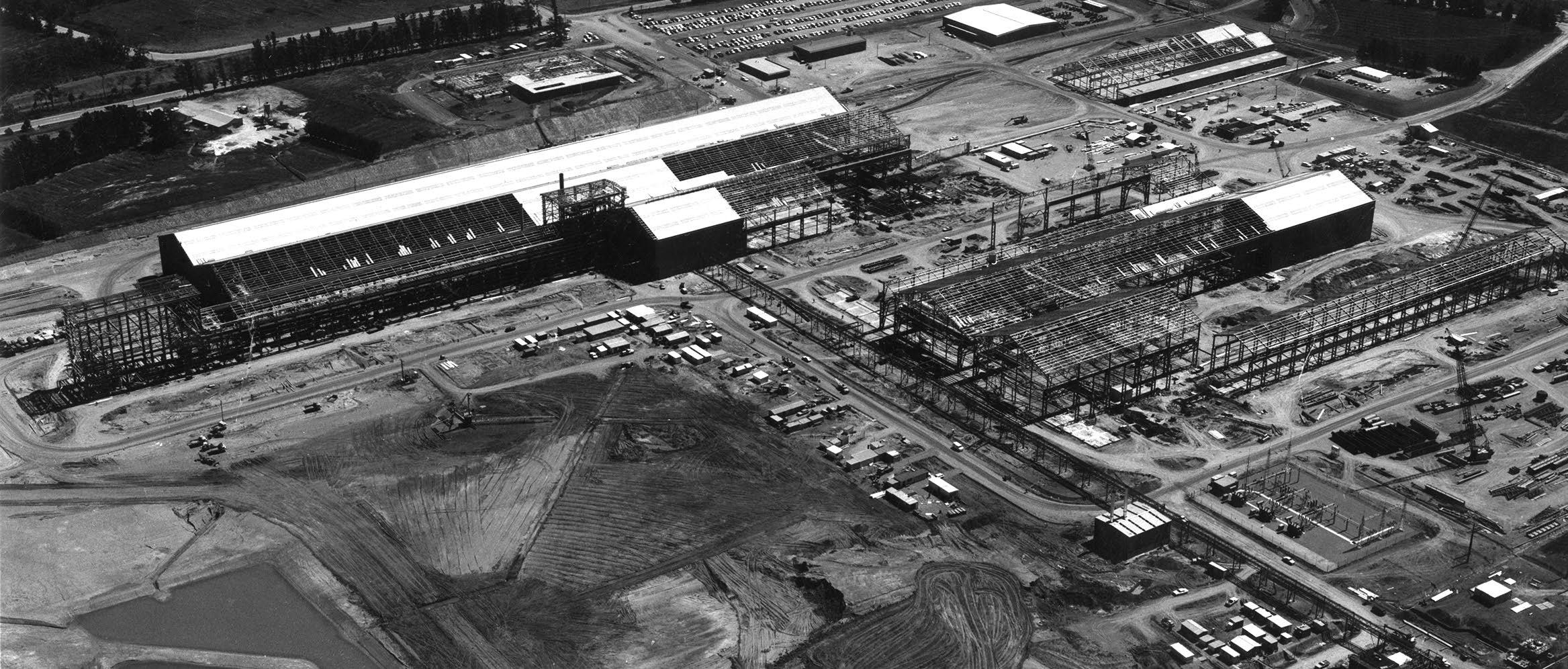
• Hot strip mill (1974-1978) with $160 million budgeted
• Blast strip furnace and steel production with $750 million estimated
Plans for the construction of the new steel plant were to be in two major stages. The cold strip plant to be the
Community consultation
As the site of the future steelworks was to be in a quiet and largely rural area, John Lysaght (Australia) went to a great deal of expense and effort to assure the local community that they were working to protect the local area. The company believed communication was the key to this and made every effort to ensure construction was as transparent as possible with the local community. Part of the company’s commitment to community engagement included the original Lysaght establishment in Hastings, the 'Lysaght Information Centre'. The Lysaght Information Centre was set up in the main street of Hastings, and opened in October 1970, during the early stages of construction. It aimed to keep any and all interested parties informed, which included conservationists, environmentalists, businesspeople, potential employees and school children from virtually every local school in the area. The Centre included scale models of various parts of the plant along with full site layouts and the wharf area. A public viewing area and platform were also created, so the general public could see from an elevated position the construction progressing.
| STEEL AUSTRALIA | AUTUMN 2023 17
INDUSTRY INSIGHTS Site aerial (September 1971)
first stage, and the hot strip mill the second stage. Notably, these plans were prepared even before the final site and layouts of the works had been determined.
To support the initial cold strip plant, it was anticipated 10,000 tonnes of hot roll coil feed would be required each week, which was equivalent to two ship loads.
Despite the hot strip mill being the preceding stage in the production process, construction of the Western Port hot strip mill was planned to be the second stage of the Western Port plant. The reason for this was because there was still sufficient surplus hot strip mill capacity in Port Kembla at that time. Thus, by delaying the construction of the Western Port hot strip mill until after the cold strip plant, the additional capital outlay could be deferred until Port Kembla hot strip mill capacity had been saturated.
Operating lines were to be planned to allow for continued expansion in outputs, and this is shown on original drawings. Multiple site layouts were proposed, which included a fully integrated steelwork plant, as a third and possible final expansion stage. Of note, there was no inclusion of any paint line in the initial Western Port site layout plans.
Cold strip plant
In April 1967, work commenced at Western Port with initial site sampling. Sampling revealed that there was clay and sand down to a depth of at least 73m, and thus no suitable bedrock at a reasonable depth to anchor foundations for the heavy machinery. This meant all foundations for both buildings and equipment had to be designed without any support piles. Luckily, the soil at the site had excellent bearing capacity. So, even without piles, the foundations could be designed in the concrete raft style, effectively 'floating' on the soil.
It was not until April 1970 that the first site levelling commenced, which took six months to complete. The foundations required approximately 70,000 cubic metres of concrete to be poured, which contained around 4,000 tonnes of reinforcing steel. During construction of the cold strip plant, over 900 personnel were employed from more than 30 different companies.
Throughout 1972, key personnel were transferred to Western Port from other Lysaght plants to assist with commissioning and training operating crews. Of the approximately 600
Cost effective, flexible long-term design
Where possible, the design of the hot strip mill aimed to reduce initial construction costs, while allowing for later upgrades. For example, finishing mill stands one to five were required for the initial phase of the hot strip mill, which was nominally rated at 1.5 million tonnes per annum. However, foundations were laid for two additional finishing mill stands (for a total of seven) in the 1970s. These two additional finishing mill stands (along with other upgrades) could have increased capacity to four million tonnes per annum. Other allowances for expansion included provision for up to four re-heat furnaces, two roughing mill stands and three down-coilers.
personnel employed at Western Port for the initial start up, around 80 were existing Lysaght personnel. The remainder of the personnel were mostly recruited locally and trained on the job.
By the end of 1972, the plant was rapidly nearing completion. In November 1972, metal coating line four was commissioned, and the first delivery of galvanised coil was made to customers. December 1972 saw production of the first cold reduced coil from the five stand mill. In February 1973, start-up of the pickle line commenced, with the cold strip plant commissioned in March. In April, the coil annealing and coil temper mill started up.
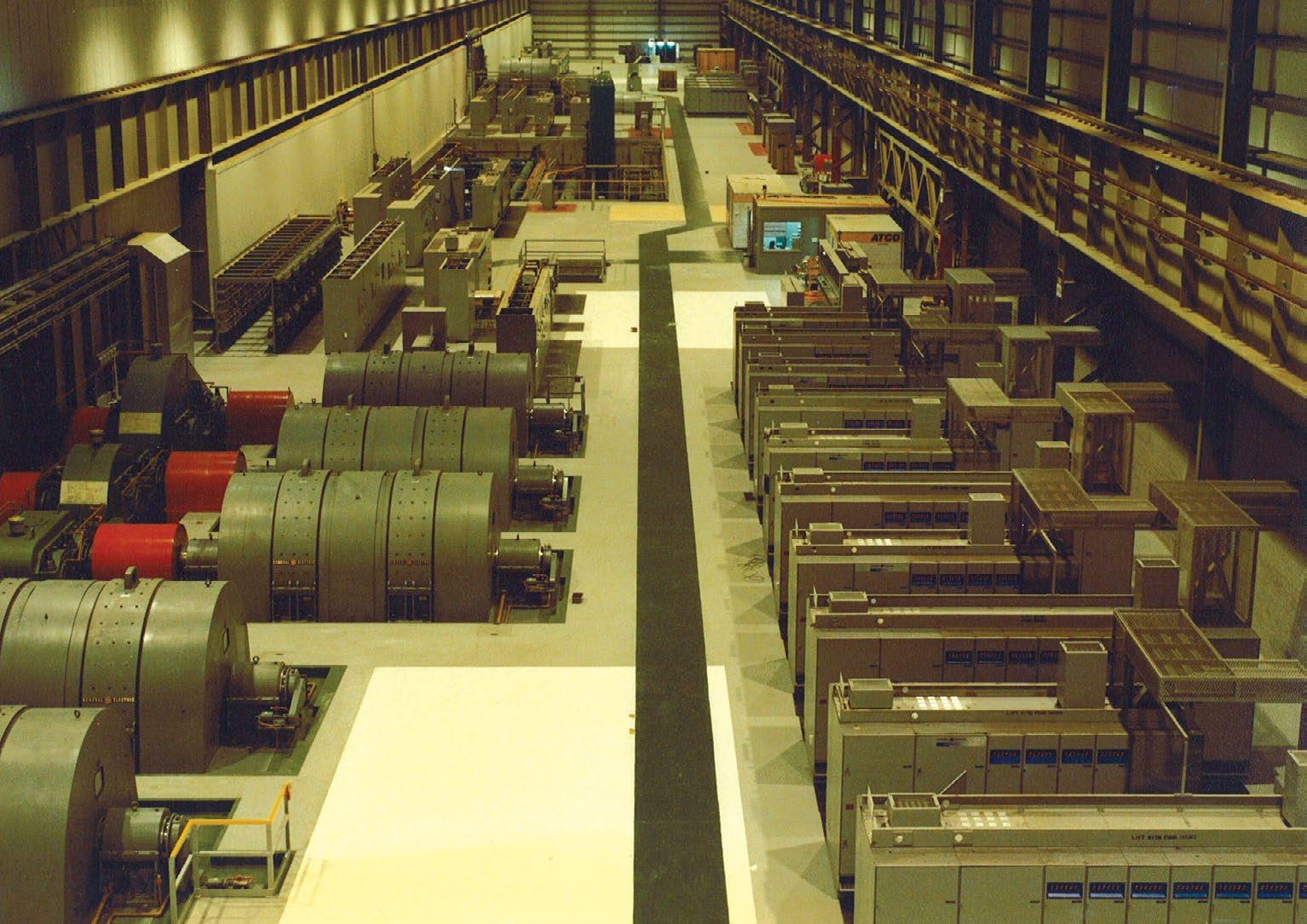
Although construction of coil paint line two started later than the rest of the cold strip plant, it commenced production in November 1973. This was driven by the huge demand for COLORBOND® steel, which the company was keen to capitalise on.
Hot strip mill
Following the successful implementation of the cold strip plant, work began on the construction of Victoria's first, and Australia's second, hot strip mill.
Earthworks commenced in April 1974, with construction plagued by several strikes and delays over various industry issues. By December 1974, most of the earthworks were completed, with roadways and pavement storage areas in progress. By July 1975, a new construction phase had commenced, with the first building columns erected for the southern wall of the roll shop.
The foundation contract involved pouring approximately 60,000 cubic metres of concrete. By the end of 1975, the building frame for the hot strip mill was 80 per cent complete, with erection of the secondary steelwork commenced. There were approximately 7,000 tonnes of steelwork required for the hot strip mill buildings. Construction of the basement slabs and building piers were also well-advanced, as were the foundations and footings. Sheeting had also commenced on the roll shop, and the crane for the roll shop had been erected; at 100 tonne capacity and with a span of 36m, this was one of the largest cranes on-site.
By mid-1976, the 60m high furnace stack was erected, and much of the wall and roof cladding was installed. The
Completed motor room in the Hot Strip Mill.
furnace walking beam support beam charging end plate was in place and foundations were complete. In early 1977, the mill housings began to arrive on-site and the first of the 133 tonne finishing mill housings was erected into its shoe plates. Another four followed quickly after. In February 1978, the hot strip mill underwent commissioning.
At 1:58am on 9 March 1978, the first successful prime coil to make it through the complete hot strip mill process was run (output coil number AA006). The five prior coils cobbled or had other issues.
ZINCALUME® and COLORBOND® demand on the rise
Following the introduction of ZINCALUME® steel into the market in 1976, Lysaght could not keep up with demand for COLORBOND® with their existing three paint lines. So, capital investment was approved to expand Lysaght's COLORBOND® steel capacity by 150,000 tonnes per annum to around 400,00 tonnes per annum.
Civil works for metal coating line five commenced in June 1978, with construction underway by mid-August. Construction continued on schedule, with all foundation work complete, housing and framework installed, line equipment installation underway and the zinc pot in position by May 1979. Metal coating line five was commissioned in December 1979 and officially opened on 13 May 1980.
Not long after, site works for coil paint line four commenced. The paint line drum storage area was expanded in late 1981 to cater for the increased paint supply required. By the end of March 1982, the coil paint line was in a ready-to-run state and was commissioned. The official start-up on 29 September 1981 was attended by over 180 guests.
The 1980s and 1990s witnessed several developments at Western Port. In 1990, the tension leveller roil line was commissioned, as was the electrolytic cleaning line. In 1992, metal coating line six was commissioned. The following year, metal coating line four was converted to ZINCALUME® steel.


A remarkable achievement
Today, BlueScope is the largest private employer on the Mornington Peninsula. More than one million tonnes of steel products such COLORBOND® steel, ZINCALUME® steel, and TRUECORE® steel are made at Western Port each year, destined for national and international markets.
Michael Hussey, the plant manager at BlueScope Western Port, said 50 years of operations on Victoria’s Mornington Peninsula is a remarkable achievement.
“BlueScope Western Port, which opened under the name John Lysaght Australia in 1972, currently employs around 800 people from the region, however, over the last 50 years, I’m proud to say we have employed around 10,000 people."
“I’m immensely proud to be the Western Port Manager and work with such great people, many of whom I call my friends. When I reflect on what we have achieved over 50 years and the strength we possess at Western Port today, I am very confident that we can deliver on all of this and more into the future."
“Challenges will be met and overcome, opportunities will be taken and leveraged further, our sustainable future is in our Western Port team’s hands (and the team members who will follow us) and is clearly achievable,” Hussey said.
Moving ahead: looking at new horizons
BlueScope has laid out the foundations for the next 50 years at the Western Port facility. In March 2022, a $34 million service centre was opened.
BlueScope’s managing director and chief executive officer, Mark Vassella, said the centre uses the latest technology, secures local jobs and strengthens Victoria’s manufacturing industry. “This new facility, with capacity in excess of 100,000 tonnes per annum, consolidates BlueScope’s steel processing capabilities in Victoria on one site, using the latest technology and with a clear focus on our customers, safety and the welfare of our people.”
It features an automated slitting head build robot, which is the first of its kind in Australia. It can construct a slitting cutting head to individual customer requirements without manual intervention from operators or other tradespeople.
“It also helps keep BlueScope people safe at work by eliminating manual handling and other safety risks,” Vassella said.
Source
Paul Reville, The Western Port Story: 50 Years of Our People and Steel Processing
| STEEL AUSTRALIA | AUTUMN 2023 19
INDUSTRY INSIGHTS
Completed Mill Water System.
Completed Finishing Mill.

DIGITAL FOUNDATION ESSENTIAL TO THE SUCCESS OF MANUFACTURERS
With disruption being a constant challenge facing the manufacturing industry, the ability to adapt and change is more important. As a recent IDC study found, manufacturers need the proper digital foundation in place to succeed in the challenging business environment.
Global market intelligence firm
IDC recently undertook a study of manufacturing companies that are using Epicor Kinetic solutions (Epicor for Manufacturing) to run their operations and businesses. These Epicor customers reported a range of improvements that enable them to succeed in the challenging business environment.
IDC calculated that these Epicor customers will realise benefits worth an annual average of US$866,800 (per 100 users). This is further supported by a 2.6 per cent increase in average gross margin, a 39 per cent manufacturing error reduction, and 12 per cent higher equipment utilisation.
Faster product delivery and customer satisfaction
Manufacturers need predictability and timeliness in completing manufacturing jobs to meet customer expectations. For interviewed companies, improved process efficiencies and better visibility into those processes achieved through the use of Epicor have resulted in significant gains in delivery timeliness, ensuring better customer experiences and satisfaction. Epicor has enabled interviewed companies to significantly improve their on-time delivery rate, allowing them to deliver in a timely fashion on 94 per cent of orders, which is an increase of 39 per cent. This improvement greatly increased customer satisfaction.
Higher manufacturing quality
Interviewed companies also reported achieving higher levels of manufacturing quality and continuity with Epicor. They reported that Epicor has positively affected manufacturing quality. By improving visibility and more robust integration across manufacturing operations, Epicor has significantly limited the frequency and impact of errors—39 per cent fewer manufacturing errors per week. Further, when errors did occur, study participants resolved them 19 per cent faster on average.
Improved manufacturing continuity
Finally, IDC analysed the impact on manufacturing continuity, a critical dependency for these companies. Put simply, when manufacturing floor operations experience disruptions or glitches, it diminishes overall productivity. With Epicor for Manufacturing, study participants face fewer outages and interruptions affecting the performance of manufacturing lines, which in turn reduces business risk and ensures more stable manufacturing operations.
Higher equipment use rate
There are many interesting lessons from the study, like the ability to better schedule and use equipment through having good data access. This in turn promotes better use of available capacity and helps optimise and manage equipment costs over time. The average use rate gain is 12 per cent across these manufacturing companies, which translates into a substantial equipment cost savings of over $100,000 annually.
Supply chain productivity gains
According to the IDC study, manufacturers also enjoyed improvements in scheduling. With access to data that enables more efficient use of team capacity, manufacturers are better able to leverage their staff resources.

As a result, their manufacturing teams experience less friction, with streamlined and well-integrated floor operations, and improved productivity.
Study participants also reported an average supply chain productivity gain of 26 per cent, as well as a host of inventory-related benefits, and improvements in the finance and accounts payable teams.
| STEEL AUSTRALIA | AUTUMN 2023 21 INDUSTRY INSIGHTS
CLICK HERE TO DOWNLOAD YOUR COPY OF THE FULL REPORT OR VISIT EPICOR.COM >>>
This article was supplied as part of a paid advertising package.
CIVMEC TAKES ON 2,000 TONNE SHIPLOADER AT HAY POINT COAL TERMINAL
In 2020, BHP Mitsubishi Alliance (BMA), a 50:50 joint venture between BHP and Mitsubishi Development, engaged Civmec to fabricate, modularise and commission a 2,000 tonne shiploader (SL2A) for the Shiploader and Berth Replacement (SABR) project at Hay Point Coal Terminal.

Located at the Port of Hay Point, 38km south of Mackay in Queensland, the Hay Point Coal Terminal is capable of handling more than 55 million tonnes of coal for export every year.
To improve cyclone immunity and ensure the long-term sustainability of Hay Point Coal Terminal, BMA initiated the Shiploader and Berth Replacement (SABR) project. The project scope includes the disassembly of the existing Berth 2 and Shiploader 2 and the fabrication and installation of new Berth 2A and Shiploader 2A structures at the Hay Point Coal Terminal.
Aurecon Engineering was responsible for the design of the new Shiploader
About the Hay Point Coal Terminal
The Hay Point Coal Terminal is a part of the BHP Mitsubishi Alliance (BMA), the 50:50 joint venture between BHP and Mitsubishi Development. Capable of handling more than 55 million tonnes of coal for export every year, the Hay Point Coal Terminal is located at the Port of Hay Point – 38km south of Mackay, in Queensland.
Established by a joint venture between Utah Development Company and Mitsubishi Development in 1969, Hay Point was originally built to service the Goonyella and Peak Downs mine sites. Hay Point saw their first coal loaded in 1971 – with just a single berth, shiploader and crawler mounted reclaimer and stacker.
A second berth was added in 1975. In 2006-2007, a two-phase, $256 million expansion project increased the capacity of the terminal.
A third expansion further increased the terminal’s capacity in 2015.The innovative design expanded the outloading bulk materials handling system, including a new berth and shiploader, replacement of the existing jetty, a 2km trestle with linking conveyors and surge bins, and high-capacity roadway. The most significant outcome of the third expansion was the increase in nameplate throughput capacity from 44 million to 55 million tonnes every year without adding to the existing stockpile footprint.
Now 50 years on, Hay Point has three berths and five stacker reclaimers and has processed more than 1.3 billion tonnes of coal.
handling equipment. Meanwhile, over 2,000m of handrail, service chutes and special tools were fabricated and surface treated at Civmec’s fabrication facility in Tomago, Newcastle, before being transported to Henderson.
The shiploader was fabricated undercover at Civmec's newly-built assembly hall at their Henderson manufacturing facility. Final assembly and commissioning were completed at Building 1 within the adjoining Australian Marine Complex Common User Facility. Once completed, the machine was delivered FAS (Free Along Side) to the Australian Marine Complex Wharf for loading onto a heavy lift ship.
"Civmec offered a full turnkey solution to the client. We did everything here –at our facilities in Henderson – so that when they land the shiploader on the wharf, all they have to do is plug it into a power source, and away they go," said Glen.
"We completed no-load commissioning here onsite as well. We ran all the wheels, drives, and every other component before it got to site. This way, any final adjustment could be carried out before it got it site."
“It is fantastic that Civmec was given the opportunity to fabricate and assemble the shiploader in Australia."
Safety considerations
Civmec's commitment to health and safety is built on robust processes and a strong culture. Their health and safety systems are certified to ISO 45001, the internationally recognised standard for health and safety management.
2A and new Berth 2A infrastructure, which focused on improving the severe weather rating of Berth 2A to be consistent with Berth 3 and associated infrastructure that was commissioned in 2015.
Fabrication by Civmec
The contract awarded to Civmec encompassed the procurement, fabrication, machining, surface treatment, SMP&E, assembly and noload commissioning of the shiploader.
According to Glen Kovacevic (Project Manager, Civmec), "The project included fabrication of structural platework – we ordered over 1,100
tonnes of plate from BlueScope. It included over 3,000 mechanical items like switch rooms, pulleys, winches, sheaves and pins. This world-class shiploader is one of the largest ever to be built globally and is the largest we have built here at Henderson to date. The boom alone weighed approximately 400 tonnes and was installed via dual crane lift.”
Adopting a national execution methodology, Civmec leveraged their multiple facilities to streamline the fabrication and assembly of the shiploader. Their main Henderson manufacturing facility, located in Western Australia, was used by the team to fabricate all the large material
In addition, Civmec's culture is built on the concept of Never Assume, designed to empower every person in the company to ensure their work practices are focused on ensuring no harm to anyone or anything involved in the project.
"The sheer size of the shiploader was incredible. The structure stands at over 52m in height and weighs approximately 2,000 tonnes. With this height, there are extra levels of safety that need to be adhered to, with people working in, around and above one another," said Glen.
"We spent a considerable amount of time on our methodology input, determining how to ensure that the project was safe for the team to work on, while remaining buildable."

| STEEL AUSTRALIA | AUTUMN 2023 23 INDUSTRY INSIGHTS
Image caption TBC
"The base of the shiploader is just 25m x 25m – a relatively small footprint, given all the components that needed to be installed within. When it came time to assemble the shiploader, we had electricians, piping and structural, mechanical installation and fabricators all needing to work on the machinery within the same, relatively small footprint. This required significant coordination from a safety point of view."
"The whole shiploader was modelled in Tekla. We used this CAD model to lay out the project before we started fabrication. We were able to see how the footprint would fit in our workshop and plan where and how our team members would work."
"We liaised closely with the engineering team and had all our welding supervisors and leading hands involved in the planning process to deliver the best possible project outcome. It's this type of teamwork that makes a major project like this one successful," said Glen.
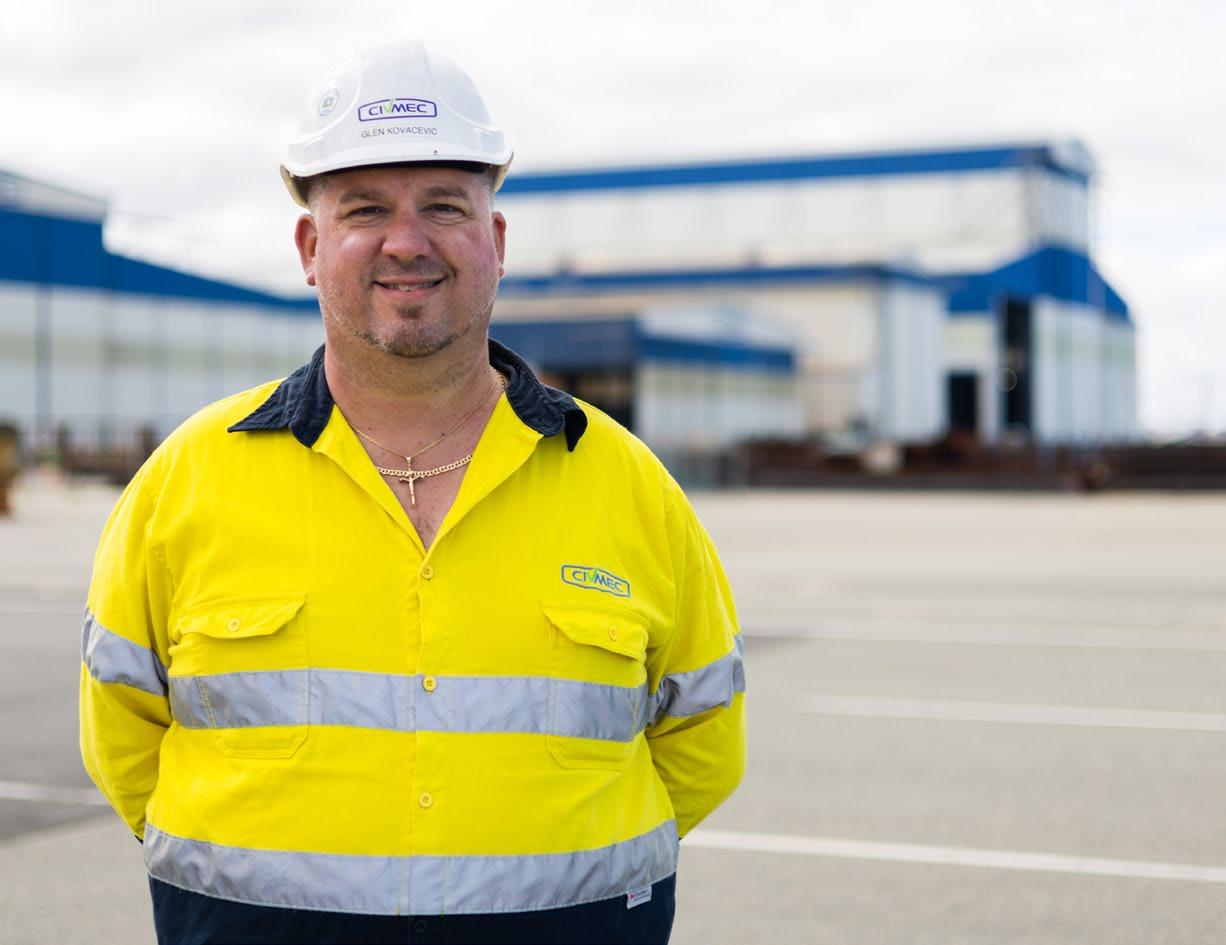
Innovative methodology
Providing quality products and project outcomes for clients continues to be a fundamental metric of success for Civmec. Their facilities in Perth and Newcastle hold CC3 certification to the requirements of AS/NZS 5131 Structural steelwork – Fabrication and erection. Civmec has also obtained certification to AS/NZS ISO 3834.2 Quality requirements for fusion welding of metallic materials
So, it's no surprise that Civmec's methodology for this project was highly innovative and firmly focused on safety and quality.
"The way we fabricated the shiploader was different to how it had been done in the past. We thought the process through and were not afraid to make changes to the traditional build method to be more innovative, and that paid off," said Glen.
"Our aim was to minimise working at heights. So, we did as much work on
the ground as possible. We painted the steel on the ground and left weld margins for areas like the mast. We assembled all the walkways on the ground to the mast before we lifted the mast into position. This ensured we had access to the top of the mast once it was lifted into position – this way, there was no need for massive cranes on-site to lift the walkways into place."
"However, with fabricating on the ground, the usual process is to machine after all the welding is complete. That would have meant machining 50m up in the air due to the height of the shiploader."
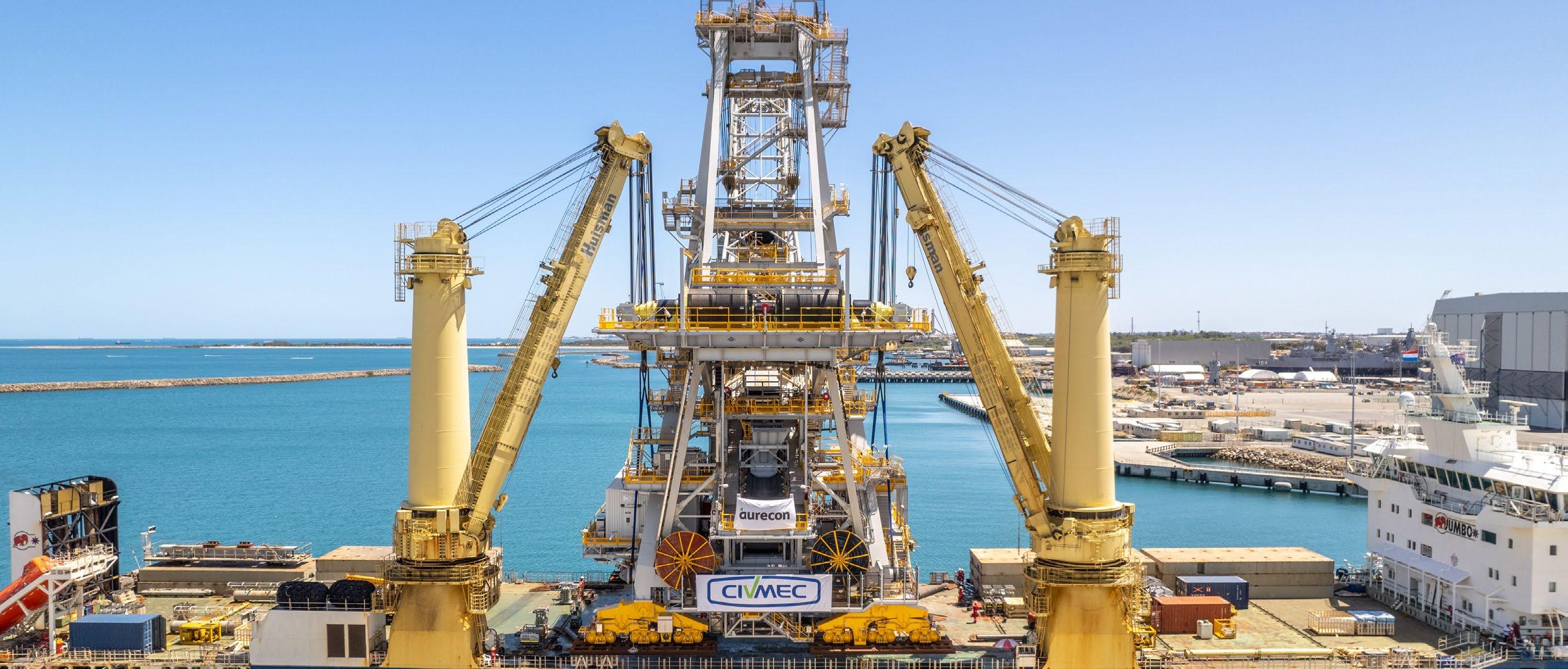
"Instead, we devised a way to fabricate the mast on the ground. We maintained the shape of the mast by using temporary supports and locking pins. At the very top where the sheaves are located, we had to weld in a sequence that meant the mast would shrink evenly and maintain the tight tolerance. We had both day shift and night shift surveyors who would check the way the mast was moving when we were welding."
 Glen Kovacevic (Project Manager, Civmec)
Glen Kovacevic (Project Manager, Civmec)
"This necessitated in-depth input and design from the engineers to minimise shrinkage and maintain the correct tolerances. We undertook extensive pre-weld and post-weld surveying, including employing a third-party surveyor. We used a lot of custom-built jigs and temporary welds so that they could be manipulated if necessary."
"Our innovative methodology paid off – when it came to assembly everything was within the correct tolerance and fit together perfectly. The hard work upfront paid off and as a result, the commissioning went really smoothly," said Glen.
Quality local fabrication
"While Civmec has extensive experience in building Balance machines, this was the first time that Civmec had built this style of shiploader. The feedback we have received from the end users – from the team working at Hay Point Coal terminal – has been fantastic. According to them, the machine is fabricated to a very high-quality standard."

"It's great that the client trusted us to fabricate the shiploader locally in Australia, and that we were able to produce a high-quality product on time and to budget," said Glen.
About Civmec
Civmec is a multi-disciplinary construction and engineering services provider to the energy, resources, infrastructure, marine and defence sectors. The company's vision is to grow sustainably, delivering mutually beneficial outcomes for all stakeholders.
Providing a full turnkey service, Civmec has the flexibility and expertise to improve methodologies, leveraging the synergies of their multi-disciplinary capability to provide clients with cost and schedule efficiencies.
Civmec's facilities, complemented by their large and experienced workforce and extensive equipment base, enable them to service projects of all sizes and complexities with superior technical, logistical and administrative support. Civmec has worked on some of the largest resources, energy, infrastructure, marine and defence projects undertaken in Australia.
Civmec delivers fabrication projects of all sizes and complexities, with well-equipped facilities and the backing of a highly experienced team. The company undertakes a wide variety of fabrication projects, from structural and platework packages, through to intricate structures requiring specialist welding of exotic materials, such as titanium, stainless steels, duplex steel and copper alloys.
With vast manufacturing facilities, Civmec can deliver platework for a multitude of purposes. Their processing equipment can be optimised for semi-automatic, automatic and user-controlled operability, ensuring consistent quality production and cost-efficient delivery.
Civmec has invested in equipment that can process various grades of steel plate and the company can build large structures in their various bays, the largest sized up to 187m x 420m at the assembly hall, which has an overhead lifting capacity of 400 tonnes.
PROJECT TEAM
Client: BHP Mitsubishi Alliance
Engineer: Aurecon
Steel Detailer: DBM Vircon
Fabricator: Civmec
Coatings Supplier: Civmec and International Paints
Steel Manufacturer: BlueScope
| STEEL AUSTRALIA | AUTUMN 2023 25
CLICK HERE TO LEARN MORE ABOUT CIVMEC AND THEIR CAPABILITIES >>>
INDUSTRY INSIGHTS
“ It's great that the client trusted us to fabricate the shiploader locally in Australia, and that we were able to produce a high-quality product on time and to budget."
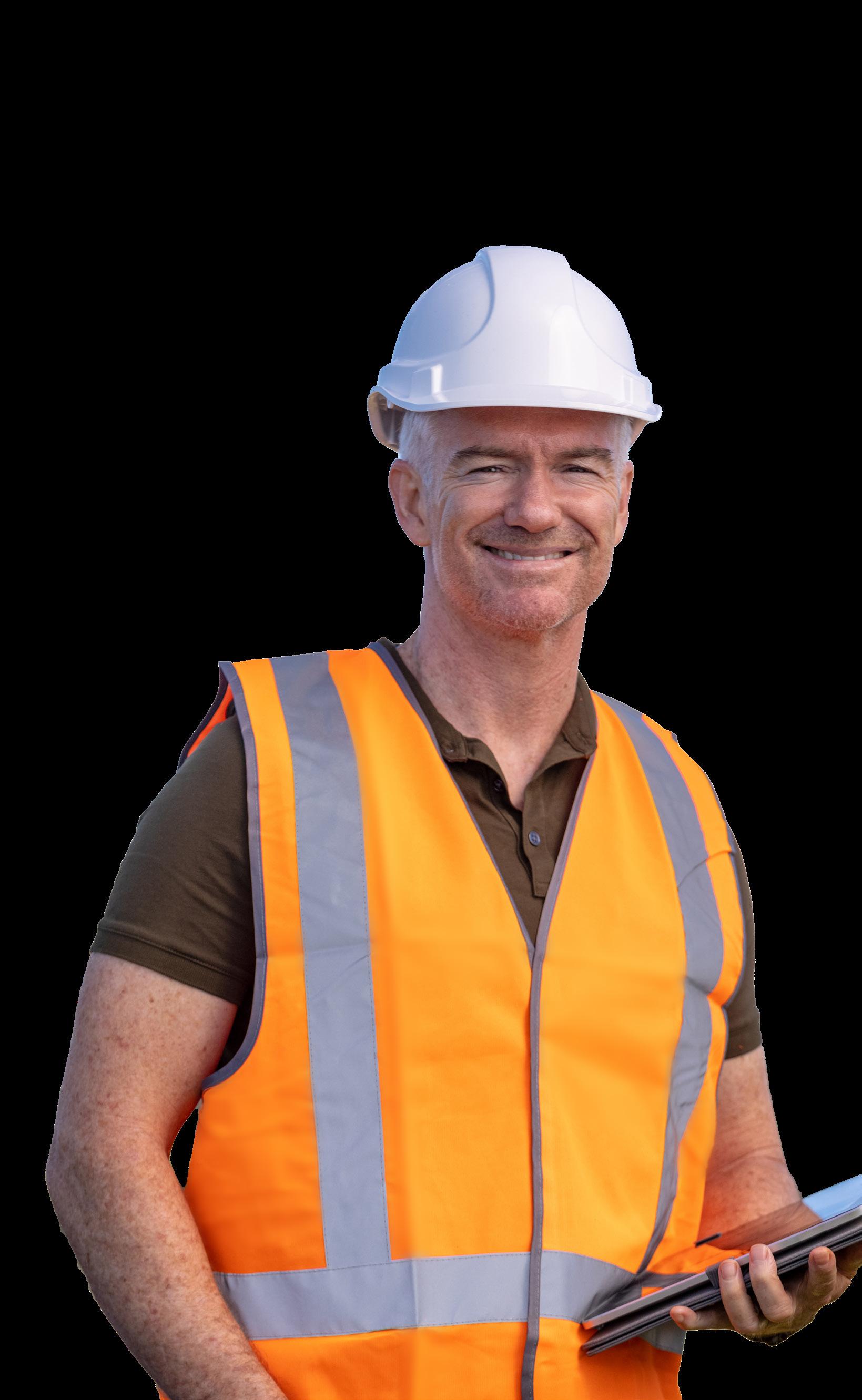
Finance available for new and used equipment Access to funds in as little as 24 hrs Competitive unsecured rates Flexible loans up to 3 years Scan here to visit banjoloans.com FINANCE FOR HOW BUSINESS REALLY WORKS Asset and equipment finance to keep manufacturing moving *Base rate is subject to change from time to time. Other fees, lending criteria, terms and conditions apply (including an establishment fee on each advance). Actual fixed fee (or interest expense) and repayments will vary based on individual circumstances. Fixed fee (or interest expense) accrues upfront and is paid in instalments. This product is conditional on the borrower providing security to Banjo (usually in the form of a director guarantees and security over the asset). Statements regarding timing in relation to applications, approvals and funding are only indicative. Typically, we do not lend to businesses in the property development or regulated utility industries. Copyright © 2021 Banjo® Loans. Banjo® and Banjo Score® are registered trade marks used under licence by Banjo Loans. All loans are provided by FundIT Ltd ACN 601 130 527 in its capacity as trustee of the Banjo Small Business Loan Fund ABN 32 713 685 984 (AFSL 468033). Moving business forward Speak with a Banjo credit decision maker to discuss your requirements Call 1300 22 65 65
ASSET AND EQUIPMENT FINANCE FOR GROWTH
By Guy Callaghan, CEO of Banjo Loans
If you’re one of the hundreds of steel fabricators, manufacturers or engineering companies that are supplying to the transport, construction and energy sectors and keeping Australia running, you’ll know that the steel industry is reasonably robust in the face of some economic challenges just now.
Nevertheless there are some pain points. For example, finding skilled labour, and many steel business owners are starting to feel the inflation headwinds coming. Customers are also increasingly looking for more sustainable product that has been accredited by the Green Building Council of Australia (GBCA). The latest manufacturing equipment, software solutions and quality management systems are often needed to satisfy these requirements.
As one of the more capital-intensive industries in Australia, steel production is fuelled by investment in plant, vehicles, and technology. If you’re a fabricator, you may need software for steel detailing or quality management. Or it could be hardware like vehicles, welding machines or beam lines.

Being able to acquire up-to-date, reliable equipment or software gives your business a strategic, competitive advantage in:
• responding quickly to market demands
• the ability to win a new customer, or a new project from an existing customer
• maximising your productivity
• reducing down time and ongoing repair and maintenance costs.
With purchase prices ranging from tens of thousands to well over $1 million, investing in new vehicles or plant and equipment is obviously a large capital outlay. However, buying equipment outright with your business’ cash reserves may have an adverse impact on cash flow and the ability to meet other competing business working capital requirements.
This is when asset and equipment finance is a smart option to acquire new equipment without hurting your working capital. One of the advantages is that
it allows your business to preserve working capital and pay for assets over a 12 to 60 month period. During this loan period, you could well experience an increase in business income generated by the asset, together with the tax benefits that come along with owning the asset.
In research carried out among small to medium enterprises (SMEs) recently, many business owners said that the slow process of getting finance from big banks is often an issue for them. Another challenge can be the high interest charged by industry suppliers offering finance.
Business lending has changed considerably in recent years. Today’s non-bank lenders are more flexible, responsive, and able to come to you at your business. They’re keen to understand you and your business and build a good working relationship.
Business owners need a quick turnaround to take advantage of growth
prospects, so it’s vital to shop around, and find a lender that can provide flexible loans to suit your business’ needs and help you grab that opportunity. A finance broker could also be an option to help you find the best deal for you.
As an example of this, Banjo was recently able to help a steel industry business buy equipment that meant they could seize a growth opportunity. Although the business had enough capital to purchase the equipment, they took out an Asset and Equipment finance loan with Banjo over a five-year period. The loan process took three days from go to whoa. The business avoided putting strain on their existing working capital and could then redirect these funds towards other critical operating expenses such as labour and fuel expense.
This article was supplied as part of a paid advertising package.
| STEEL AUSTRALIA | AUTUMN 2023 27 INDUSTRY INSIGHTS
CLICK HERE TO DOWNLOAD YOUR COPY OF THE FULL REPORT OR VISIT BANJOLOANS.COM >>>
SOREL AWARDS : GALAVNIZING EXCELLENCE
The AQUNA Sustainable Murray Cod Inland Aquaculture Project recently won the 2022 Sorel Award. Awarded by the Galvanizers Association of Australia, the Sorel Award highlights the high standards of design, fabrication, construction and corrosion protection achieved when hot dip galvanizing features as a key component of a project. The 2022 finalists included the Horseshoe Lagoon Pedestrian Bridge in Moama, the Arnold's Creek Shade Structure in Melton, and the Hope Vale Sound Stage in Cooktown.
The winner of the Sorel Award 2022 for Industry Innovation was announced at the Galvanizers Association of Australia’s Annual Conference late last year. The award was presented to Albury Galvanizing for the AQUNA Sustainable Murray Cod Inland Aquaculture Project.
All of the 2022 Sorel Award finalists are projects located outside of capital cities and some are located in corrosive locations. In each case the galvanized coating provided cost effective, attractive, and robust structures, along with the reduced maintenance characteristic of batch hot dip galvanized steel. This year all projects utilise both structural steel and hollow sections and all of them are of a modular construction providing the opportunity to replace any components damaged during service while also reducing transport and installation costs.
GALVANIZING PLAYS A VITAL ROLE IN WORLD FIRST AQUACULTURE PROJECT DESIGN
Based in the Riverina in New South Wales, AQUNA Sustainable Murray Cod is an inland aquaculture producer of Murray Cod, the largest freshwater fish found in Australia. AQUNA grows cod in open ponds (or dams) on the MurrayDarling Basin river system—the fish’s native environment.
AQUNA commissioned the Inland Aquaculture Project to help achieve their vision: to make sustainablyfarmed Murray cod the fine-dining fish of choice in Australasia and around the globe. The project consisted of the development of 10 round floating aquaculture systems, aeration platforms and winch trusses. In conjunction with steel fabricators, Commins Enterprises, Albury Galvanizing hot dip galvanized all steel sections for the project.
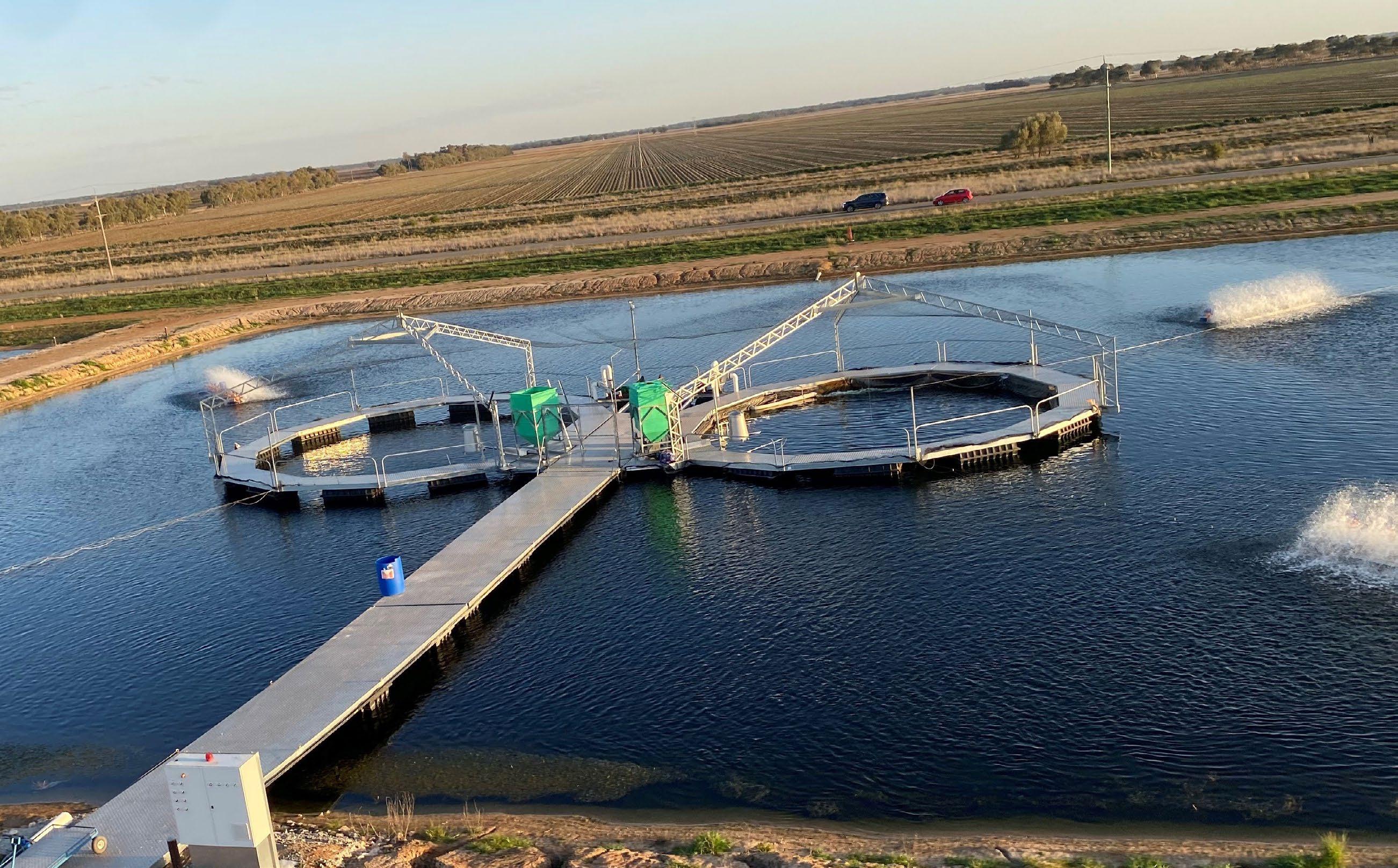
Galvanizing: the best choice
Previously, AQUNA had relied upon rectangular aquaculture systems with either paint coatings or pre-galvanized steel sections.
The choice of hot dip galvanizing for the new design offered a raft of benefits to AQUNA, from improved lifecycle cost and coating durability, through to a major reduction in maintenance. In addition, both construction and erection were much faster as a result of the modular design that galvanizing facilitated.
According to the general manager of Albury Galvanizing Brent Hallows, “Galvanizing was the best choice for the AQUNA Aquaculture Project. Primarily, the biggest benefit was a major reduction in ongoing maintenance for the client. Hot dip galvanizing corrosion protection of all surfaces—inside and
AQUNA Sustainable Murray Cod Inland Aquaculture Project.
out—of the steel sections significantly increased the lifecycle of the asset. The durability of the coating is now a lot stronger, and ongoing maintenance is eliminated.”
Minimising capital expenditure was a critical control point for AQUNA. By choosing galvanizing as the coating system for this project, AQUNA increased the life cycle of the asset three-fold compared to the previous system of pre-galvanized steel and paint.
By extending the life of the asset, AQUNA was able to integrate process improvements into the design itself. These process improvements have dramatically reduced the repetitive manual tasks that were required to operate the system. This has led to both labour efficiency gains and improved health and safety risks.
Overcoming design and transport challenges
A project of this scale does not come without its challenges. Due to the size of the modular components, Albury Galvanizing worked closely with Commins Enterprises and AQUNA to refine the design of the segmented platforms.
“The original venting and drainage design meant that the winch trusses could only be dipped in a certain way—there was no flexibility in the process we could use. This would have resulted in needing to double dip the winch trusses,” Hallows said. “So, we went back to the design with the fabricator and changed all the locations and added venting and drainage holes in the trusses. This allowed us to single dip, which gave a much better overall aesthetic appearance.”
Transport challenges were also encountered due to the size and shape of the components. Albury Galvanizing and Commins Enterprises developed a fabrication and load planning schedule, along with a packaging procedure, that best leveraged maximum use of freight capacity. This reduced overall construction time, as well as the risk of damage during loading and unloading.
“The biggest challenge associated with the project was transport and logistics due to the shapes and quantities of each segment. We had to devise a load plan to maximise the freight capacity and stay on the timeline target. The distance travelled necessitated a load plan that was designed to reduce damage throughout transport and handling,” Hallows said.
Huge market potential
This world first design for aquaculture systems was only possible through the use of hot dip galvanizing. As such, the project offers almost endless market potential—both locally and globally. With ever expanding global populations and increased environmental awareness, projects such as this are likely to be essential for future food supply and security.
So then, it comes as little surprise that AQUNA is already expanding, with the addition of 12 pondages. “This client is in an expansion phase at the moment. If they reach their expansion target, this would result in AQUNA supplying only 3 per cent of the domestic market—about 0.01 per
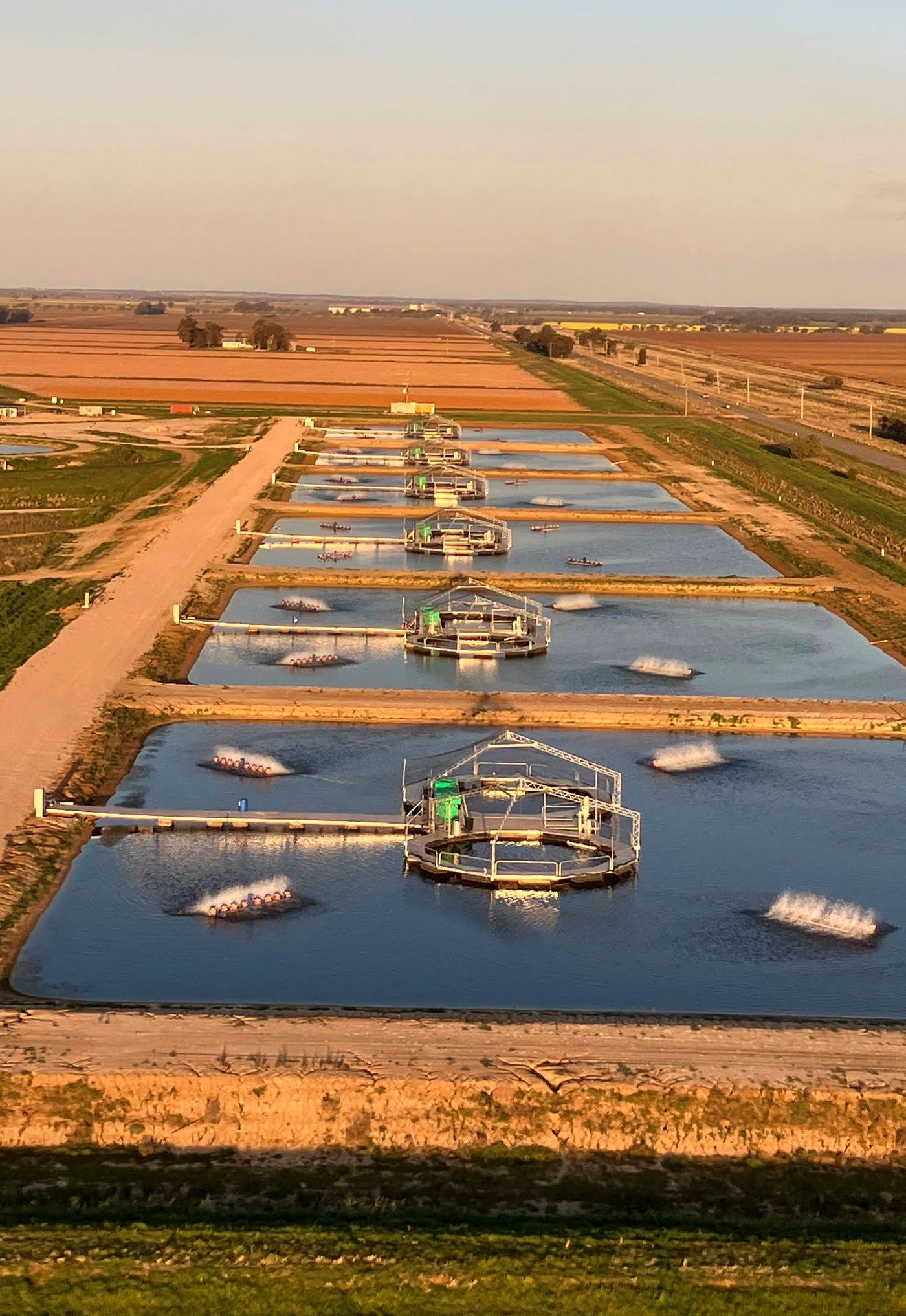
| STEEL AUSTRALIA | AUTUMN 2023 29 INDUSTRY INSIGHTS
“ Hot dip galvanizing corrosion protection of all surfaces—inside and out—of the steel sections significantly increased the lifecycle of the asset. The durability of the coating is now a lot stronger, and ongoing maintenance is eliminated."
AQUNA Sustainable Murray Cod Inland Aquaculture Project.
ABOUT ALBURY GALVANIZING
Albury Galvanizing has been providing professional hot dip galvanizing services for customers since 1995. The business is part of the J Furphy & Sons Group which operates galvanizing plants in Albury, Geelong and Shepparton, as well as a major engineering and vessels fabrication business also in Shepparton. Located in Jindera, New South Wales, Albury Galvanizing boasts a purposebuilt galvanizing plant situated on a Greenfield site. The plant was built specifically to provide hot dip galvanizing services across north east Victoria and southern to central western New South Wales. It is equipped with a galvanizing bath that is 9.5m long, 1.5m wide and 2.6m deep, as well as two double beam cranes, each with a capacity of 5 tonnes.
Albury Galvanizing provides a wide variety of services, assisting clients with all aspects of the galvanizing process, from quality, design and venting, through to dipping charts and delivery details. Their services extend to a range of sectors, including major infrastructure projects; silo parts; marine and farm equipment; lintels, beams and balustrades for residential and commercial projects; heavy industry; electrical transmission equipment; and telecommunications towers.
cent of the world market. So the market potential is huge, particularly because it is a sustainable business model and the end product is well-received. There is also additional market potential for further inland agriculture projects,” said Hallows.
Sustainability in action
Every year, AQUNA sets tangible targets to reduce their environmental impact—they strive to be global leaders in sustainability for the aquaculture industry. With sustainability at the core of AQUNA’s business, hot dip galvanizing was an obvious choice.
“The sustainability benefits in relation to hot dipping galvanizing are linked to the circular economy model. Being galvanized, the design of the system is modular," said Hallows.
"This means it has a very long life cycle; it can be pulled apart, relocated
PROJECT TEAM
Client: Murray Cod Australia Limited
Galvanizer: Albury Galvanizing Pty Ltd Steel Fabricator: Commins Enterprises


and reused. It can be pulled apart, regalvanized and then put back into service in 80 to 100 years’ time. Because the asset has been galvanized, it will not need to be replaced every 15 years or so, like other coating systems. It ensures far less maintenance is required,” Hallows said.
“If the client ever decides that they wanted to decommission the project, the steel and zinc can be recycled together to produce new galvanized steel. Galvanized steel can be reused, repurposed, remanufactured or recycled.”
“The project itself also affords a range of sustainability benefits. The aquaculture system utilises 100 per cent recycled water. For example, when the water quality diminishes to a level that necessitates pumping out for the health of the fish, the water is used for crop irrigation.”
“The environmental sustainability benefits and social benefits of a project like this are huge, as is the market potential. To be involved in a project that is so environmentally sustainable, and producing a world class fish product 400km from the nearest ocean, was pretty special,” Hallows said.
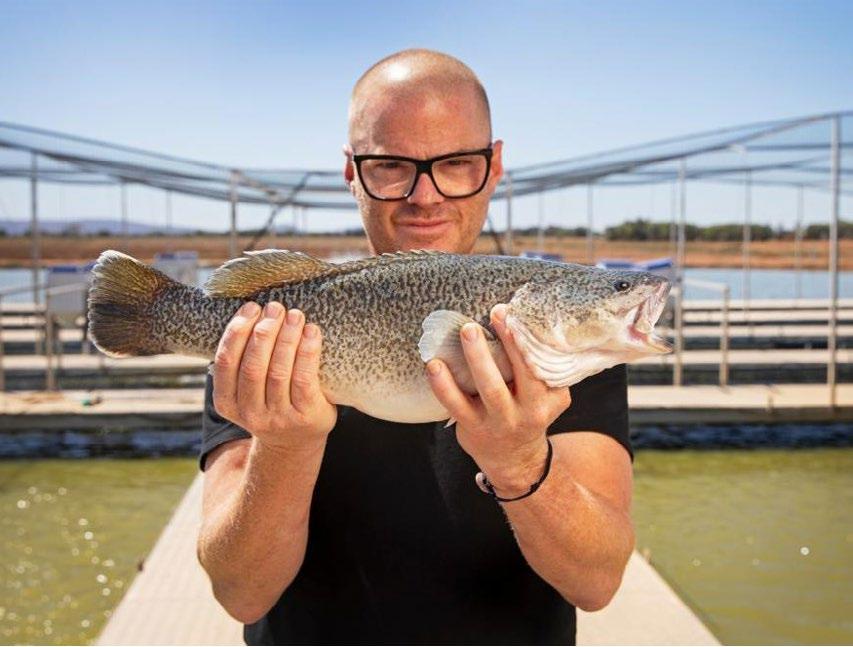 CLICK HERE TO LEARN MORE ABOUT ALBURY GALVANIZING AND THEIR CAPABILITIES >>>
Kettle dip at Albury Galvanizing.
Galvanized steel, ready for transportation.
Heston Blumenthal, a key advocate of AQUANA Sustainable Murray Cod.
CLICK HERE TO LEARN MORE ABOUT ALBURY GALVANIZING AND THEIR CAPABILITIES >>>
Kettle dip at Albury Galvanizing.
Galvanized steel, ready for transportation.
Heston Blumenthal, a key advocate of AQUANA Sustainable Murray Cod.
GALVANIZING THE CIVIC HUB OF HOPE VALE
Hope Vale township is situated 46km north west of Cooktown and some 370km north of Cairns. Covering 110,000 hectares, Hope Vale is located in a valley surrounded by tropical native bushland, mountain ranges, pristine coast lines and diverse flora and fauna. Hope Vale is home to a population of 1,500 people, comprised of 13 Aboriginal clan groups who mostly speak Guugu Yimithirr and other related languages, as well as English.
The Hope Vale Aboriginal Shire Council is committed to sensitive, planned, sustainable and culturally appropriate development. With the township of Hope Vale growing, development of the civic heart and central hub of the town is essential.
As such, in early 2022, the Hope Vale Aboriginal Shire Council called for tenders to construct a 3,200m2 sound stage in the town’s central park. The sound stage is more than a sheltered area for gathering—it will become a place for celebrations, events, school concerts, sports and recreation. It will become an icon for the town, a signature image for tourism and a source of civic pride.
Myriad Design explored several concepts with the Council. The Council selected a curved form to mirror that of a sting ray, representing the coastal connection for the community. Floating like wings overhead, curved roof panels step upwards away from the stage providing shelter for over 300 people.
The best possible protection
Cairns Steel Fabricators undertook detailing and fabrication of the structure, with RPG providing rolling services, and APG Group galvanizing the structure.


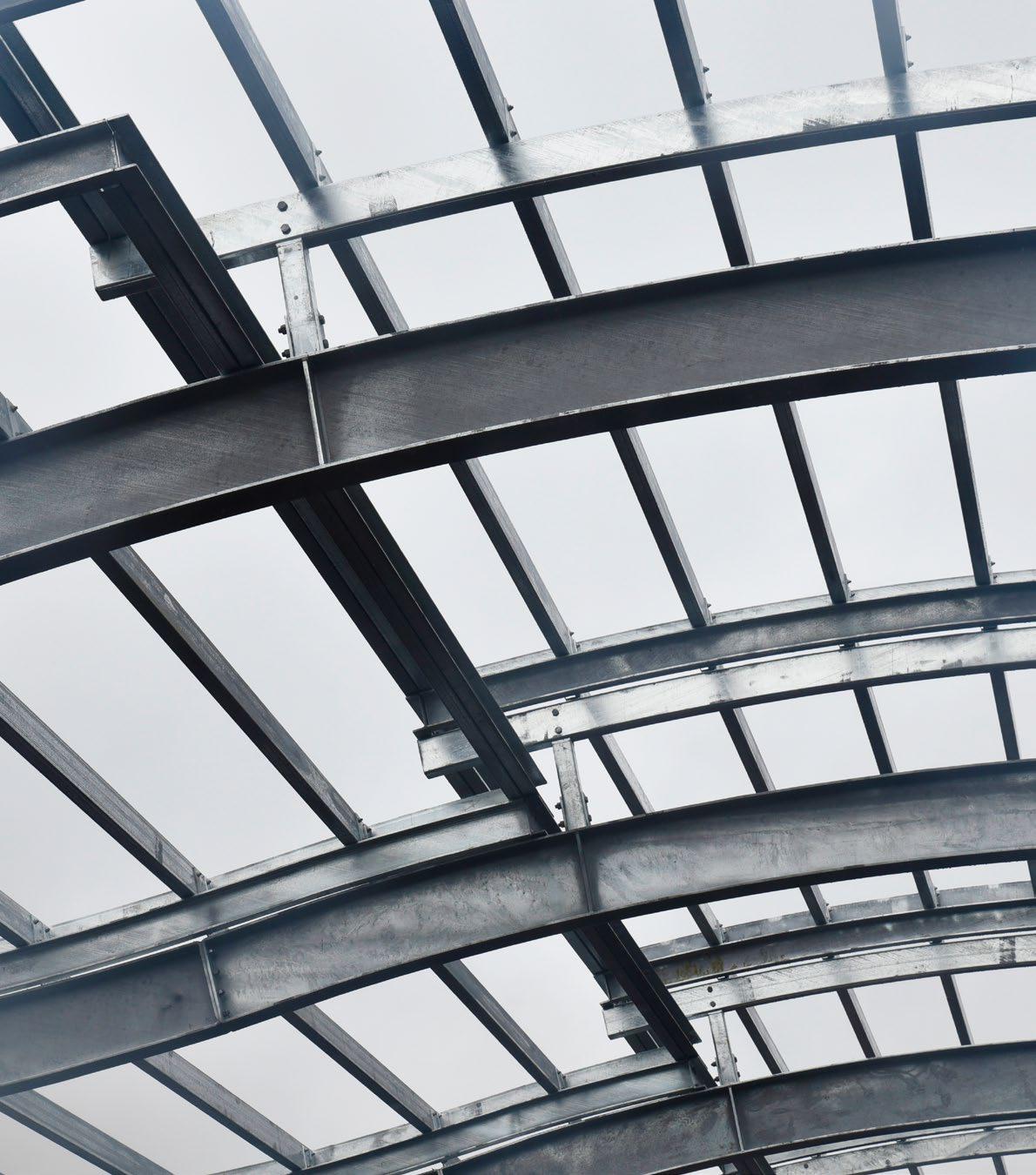
With more than 55 years of expertise, APG Group is North Queensland’s largest hot dip galvanizing organisation. APG has one plant in Townsville and two depots in Cairns and Mackay. These strategic locations enable APG to service the needs of customers from Rockhampton and Gladstone, up to Queensland’s northern tip, as well as inland to Mt Isa.
In total, APG galvanized just over 33 tonnes of steel for the sound stage. This consisted of single dipping items up to 10m in length using their 12.5m galvanizing bath.
Extensive research has shown that the corrosivity of the atmosphere is very much related to the proximity of the coast and the frequency of on-shore prevailing winds. Given the location of the sound stage, galvanizing was the best possible protective measure available.
According to APG Group's sales officer Sharna McKeown, “The area around the Hope Vale sound stage is subject to high salt water and winds. This makes it quite a harsh environment for steel. Galvanizing was the best possible solution to protect the steel from this environment.”
The trouble with transportation
While a challenge, the safe transportation of the steel
| STEEL AUSTRALIA | AUTUMN 2023 31
INDUSTRY INSIGHTS
was achieved thanks to the durability of galvanizing.
“Hope Vale is a remote community. The steel had to be transported over 750km to the site, some of which was on dirt roads. Galvanizing was the best way to protect the steel throughout the logistics and transportation process,” McKeown said.
“While the galvanized steel had to be transported over 750km, the process really was business as usual for APG Group. A lot of our steel is transported long distances prior to installation. We know exactly how to load a truck, and make sure that everything is packed correctly and strapped down in line with all the transport guidelines.”
Economic benefits for the Hope Vale community
It is well-documented that galvanizing offers an array of economic benefits. Using galvanized steel in a small community such as Hope Vale will ensure the local community can enjoy
a structure with a much-extended lifespan, particularly compared to other applications such as paint. In addition, maintenance and repair costs for the Council are expected to be significantly reduced. “The use of galvanizing on the structure will ensure that the community at Hope Vale enjoys the sound stage for an extended period of time, with much less maintenance, particularly compared to other coatings like paint. The community and local council won’t need to undertake anywhere near as much maintenance,” McKeown said.
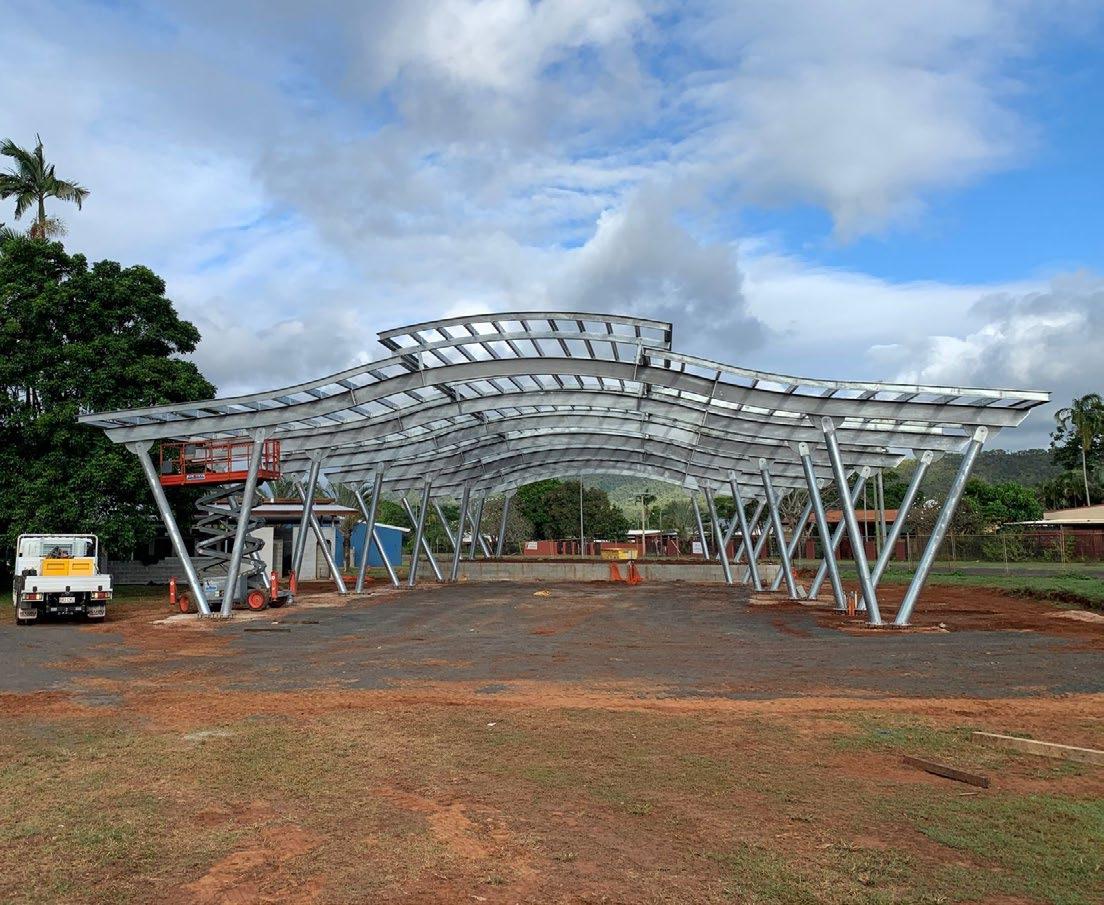
Environmental and social responsibility
Any development—whether small or large—needs to be considered from an environmental sustainability stand point. As society progresses, it is important that we aim to meet the needs of present generations without jeopardising those of future generations. The selection of materials for projects such as the Hope Vale sound stage can play a major role.
Hope Vale is a remote community that not only celebrates Aboriginal culture, but prides itself on protecting the diverse natural environment. This made the use of galvanizing an obvious choice. Compared to other processes like paint, galvanizing helps ensure that fewer natural resources are consumed, fewer emissions are produced and less money is spent over the lifecycle of a project.
“It was really great to be involved in a project like this that is designed to help develop a small town. APG Group was pleased to be able to help the community get a longer life out of the structure,” McKeown said.

PROJECT TEAM
Client: Hope Vale Aboriginal Shire Council
Galvanizer: Australian Professional
Galvanizing
Fabricators: Cairns Steel Fabricators
Building Designers: Myriad Design
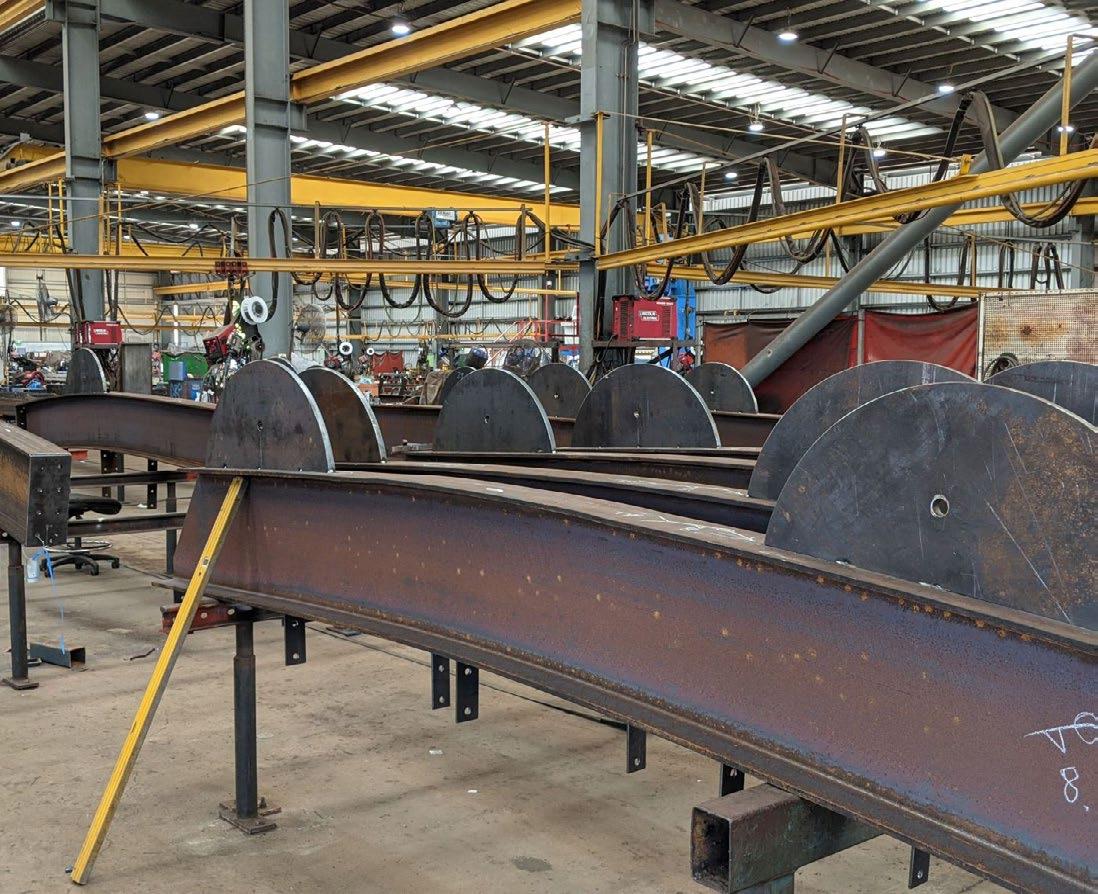
CLICK HERE TO LEARN MORE ABOUT AUSTRALIAN PROFESSIONAL GALVANIZING AND THEIR CAPABILITIES >>>
REIMAGING THE FUTURE OF A LOCAL COMMUNITY WITH GALVANIZING
The 'Reimagining Arnolds Creek' project was a transformative 5km creek line revitalisation in Melton, 50km north-west of Melbourne. The project was designed to create a contemporary space for the local community, and improve both biodiversity and waterway health.

Prior to implementation of the project, local neighborhoods were divided by the existing Arnolds Creek concrete drainage channel—an unsightly, dry and under-utilised parcel of land with little shade or amenity.
The old drainage channel was transformed with vegetation and high-quality landscaping, as well as community amenities like benches and tables. The project included the planting of approximately 200,000 plants and trees, as well as the construction of walking tracks to better connect neighbourhoods to nearby schools, shops and community services.
The Arnolds Creek Shade Structure sits at the heart of the project. This custom galvanized steel arbour is a visually striking 'skeleton'. The structure marks the joining of two local creeks connecting the man-made elements to nature.
Galserv was engaged by park designers Fleetwood Urban (working in conjunction with REALstudios) to construct and deliver the galvanized steel arbour. Galserv hot-dip galvanized approximately 10 tonnes of steel to create the giant skeleton-like structure. The design featured 30 tall, long steel arches spanning a footprint of approximately 25m. Each arch included several components varying slightly in size and bend.
While individually the pieces appear unremarkable, their meticulous design variation across each arch was critical to creating the 'living form' for the project.
Use of hot dip galvanizing
The project demanded a long-design life and needed to provide robust resistance to human and environmental wear. Hot dip galvanizing was chosen not only for its visual appearance but its reliability and durability. When compared to paint, it was calculated that hot dip galvanizing would last decades before requiring substantial maintenance.
These factors appealed to project stakeholders in two key ways: the initial construction using hot dip galvanized steel over other materials presented best value; and the overall cost of asset maintenance for the life of the structure was far less than painted finishes.
According to Galserv's account
manager Adam Chessell, “Galvanizing was chosen for the Arnold’s Creek Shade Structure for the high quality durability it provided, at the lowest cost, for the environment in which it is located. As the structure is installed in a public park, easy repair and maintenance in the wake of graffiti or other damage was important. Galvanizing satisfies this criteria.”
Complex in concept and execution
The shade structure was highly complex in concept and execution. The structure was designed and modelled three-dimensionally so that its final form could be considered from multiple perspectives, light levels and environmental conditions to ensure the intended performative qualities were achieved.
Hot-dip galvanizing was a deliberate choice to enhance the connective design with its surroundings and achieve a cohesive blended look. The structure needed to appear like a 'giant skeleton' of individual elements

| STEEL AUSTRALIA | AUTUMN 2023 33
Arnold's Creek Shade Structure.
INDUSTRY INSIGHTS
emerging from the earth that appears to change shape when viewed from within, around or at a distance. Yet, in its design it also needed to look identical and whole so that each part was indistinguishable from the next. As a result, the end design included many components that appeared the same, but actually varied slightly in shape and size. It was critical these components, especially those joining to create a continuous arch, came together seamlessly on-site in both construction and appearance.
The meticulous considerations of the design and planning of the structure flowed through to the hot dip galvanizing process. The brief from the client, Fleetwood Urban, was clear: a continuous and seamless finish had to be achieved when the components were assembled. Central to the design of the structure was a series of hollow pipes of various lengths and bends. Steel sections like these present a challenge at the galvanizing kettle. A poorly engineered design can trap pockets of air, preventing a complete coating inside and out.
All these factors required Galserv to work closely with Fleetwood Urban early, and consistently, throughout the project, to ensure all technical, logistical and quality aspects were successful.
“We collaborated closely with Fleetwood Urban—experts in play, access and shade structures—on this project. Fleetwood Urban’s designers are very creative, bringing the vision of the architect into real life. With this creativity, it means that very few of the structures they design include standard pieces and products. All the pieces are custom and varied. There is no standard height, size or design. Without stock standard dimensions of
steel, the handling of the pieces during galvanizing becomes more complex, as does achieving consistent quality,” Chessel said.
“To overcome this challenge, we galvanized the pieces individually— rather than in the usual batches—to ensure the best possible quality. While this type of process is more costly and time consuming, it delivers a much better aesthetic.”
“We ensured all the material we received was grit blasted first, before galvanizing, to give it a more consistent finish. We also sandblasted the circular hollow sections before galvanizing. Then as soon as the galvanizing process was complete, we got it offsite as quickly as possible to avoid double handling,” Chessell said.
Market development potential
The shade structure, and the use of hotdip galvanizing, was a considered and well-designed focal point for design life and appearance. The project set a new standard in the approach to creating green spaces in existing areas with significant community engagement and deep consideration for the environment.
PROJECT TEAM
“Fleetwood Urban is looking to replicate this project across Victoria and Australia—the idea is to revitalise dead community spaces so that the local population has a usable, functional space. This project demonstrates that galvanizing is key to ensuring the longevity of these types of structures,” Chessell said.

“This project proves that the package of work doesn’t have to be huge to garner interest in galvanizing, or demonstrate the benefits that galvanizing has to offer. Often, galvanized steel is part of a building or a structure, and it can’t really be seen or appreciated because it’s hidden. The Arnold’s Creek Shade Structure put galvanizing on display in a piece of public artwork.”
“The structure really stands out. It looks like a skeleton—or like the bones of a dinosaur, or the ribcage of a huge whale. At different times of the day, it casts different shadows and plays with the light. Viewed from afar, the structure is more like a piece of art than an arbour. It was a great project to work on alongside Fleetwood Urban.”
Clients: Melbourne Water, Melton City Council, Western Water and Department of Environment, Land, Water and Planning

Hot Dip Galvanizer: Galserv® (NEPEAN™ Building & Infrastructure)
Shade Structure: Fleetwood Urban
Architect: REALMstudios
Project Consultants: Alluvium Consulting and Mosaic Insights
Environmental Engineering: E2DesignLab
CLICK HERE TO LEARN MORE ABOUT GALSERV® AND THEIR CAPABILITIES >>>
Arnold's Creek Shade Structure.
HORSESHOE LAGOON BRIDGE ILLUMINATES THE BENEFITS OF GALVANIZING

Located near the Moama Wharf, the Horseshoe Lagoon Bridge was an old timber bridge that spanned approximately 115m over the Murray River. Over the years, the timber bridge had suffered ongoing weather damage. As a result, an engineering inspection classified the bridge as unsafe and unable to meet weight load requirements. In addition, the safety and accessibility of the stairs leading to the bridge needed improvement, as did the access to the riverfront, and the wharf facilities for paddle steamers.
With tourism on the rise and the popularity of the region increasing, the Murray River Council decided to decommission the old timber bridge. It was then replaced with an entirely new structure fabricated from over 135 tonnes of hot dip galvanized structural and tubular steel.
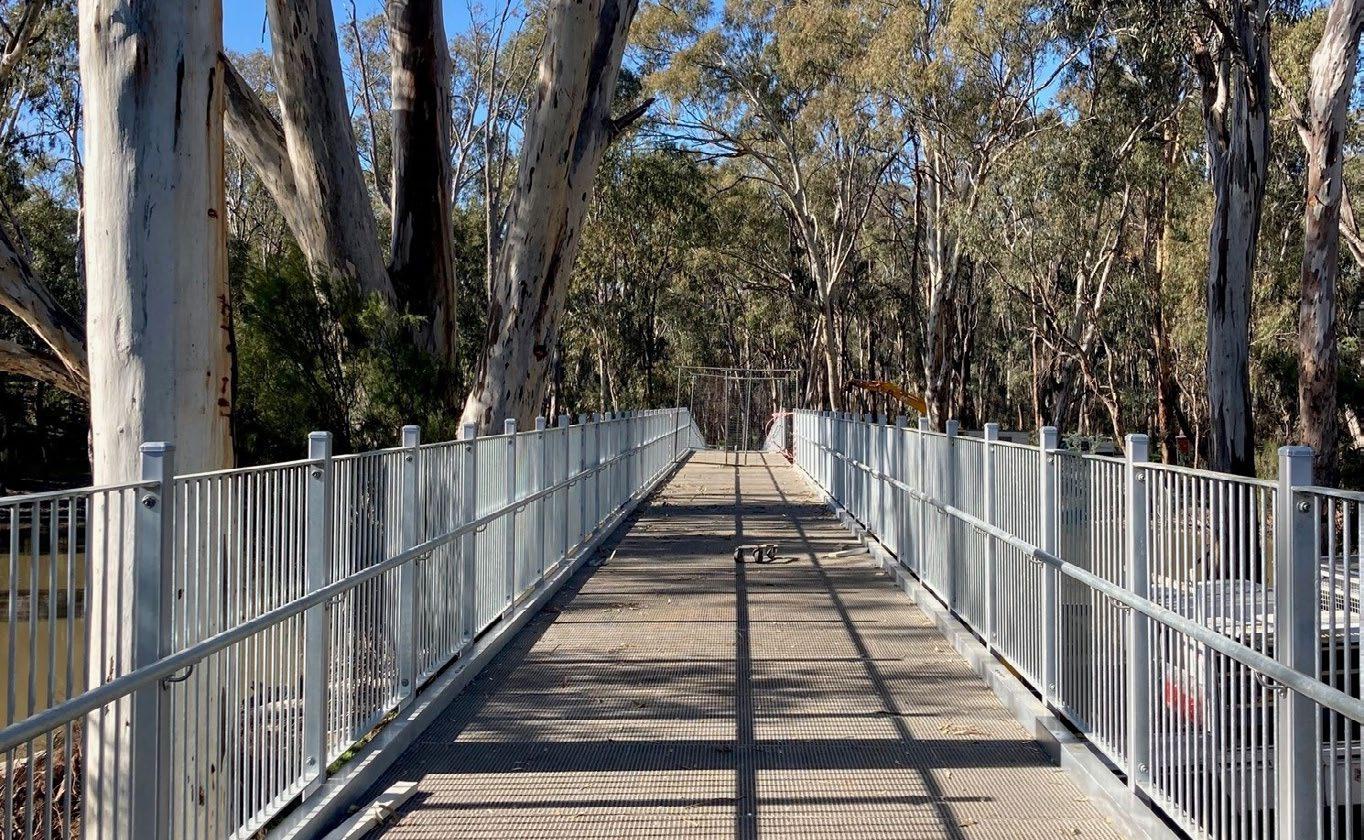
Valmont® Coatings provided all galvanizing needed to deliver the new bridge. Based in Melbourne and with over 35 coating facilities in seven countries, Valmont is one of the worlds most respected providers of hot dip galvanizing.
The role of galvanizing
In the early design phase, the bridge was initially specified with a paint finished coating. However, as the project progressed, the design was converted to Hot Dip Galvanizing through the hard work of the fabricator with consultation with Valmont®. The conversion was quite easily passed as it would lead to the most suitable anticorrosive coating for its environment.
At the early stages of designing the
bridge, it was initially specified as a paint finished coating. However, as the project progressed, it became clear that galvanizing was a much better option.
According to Valmont® Coatings sales manager, Marco Bazzano, “The bridge was initially specified as paint. Luckily, Valmont® was involved in the early design stages of the bridge. When the bridge was initially specified as paint, Bendigo Engineering got in touch with us, to ask our opinion. Our team went out to the site for an inspection and determined straight away that galvanizing would be better both from a durability and an aesthetic perspective.”
“The bridge will be subject to general wear and tear, as well as extreme weather conditions. With galvanized steel, once it is installed and erected, you can just walk away and not worry about it. If a section is damaged, it won’t rust, and there won’t be paint peeling off the edges.”
“The years to first maintenance was one of the main reasons the Murray River Council opted for galvanizing. If the bridge had been painted, it would have required yearly maintenance, particularly due to its location—it is prone to damage from wind and trees. Galvanizing was always going to be the best choice.”
In the end, hot dip galvanizing was used across every part of the bridge, including: the 12m 356OD pipes as the supporting pillars; the main walkway structure in the form of straight structural steel with bolted connections; and all other components such as balustrades, handrails and fittings. All the members were pre-assembled in the fabricators’ workshop in Bendigo, loaded onto a truck and transported to Moama in sections.
A tight timeframe
The bridge fabrication schedule had very strict timeframes and
| STEEL AUSTRALIA | AUTUMN 2023 35
INDUSTRY INSIGHTS
Horseshoe Lagoon Bridge light show.
deadlines; it had to be commissioned in time for the grand opening of the Moama Lights on 31 July 2022.
The ongoing, industry-wide supply and logistical challenges related to steel availability and delivery delays persisted. In addition to these steel supply issues, one of the biggest scheduling challenges was coordinating the sandblasting of the large pipes to remove protective black lacquer prior to galvanizing.
“All the columns on the bridge had to be sandblasted, and the window of time allowed for this was tight. The turnaround from fabrication, to sandblasting, and then galvanizing was all completed on a very tight deadline,” Bazzano said.
“The transportation of the steel from Bendigo to Moama also proved challenging due to a lack of availability of trucks and drivers. Galvanizing proved a better option than paint coatings during handling and transportation. If the steel had been painted, it would have required special handling to ensure it wasn’t marked. This would have slowed down an already tight timeframe.All these timeframe and transportation challenges were easily overcome with good communication between all the project stakeholders and detailed planning and organization,” Bazzano said.
Market potential for infrastructure projects
Galvanizing was the perfect solution for the Horseshoe Lagoon Pedestrian Bridge. This project demonstrates that not only is galvanizing is the most suitable anti-corrosive coating for infrastructure, it is also economical during construction and maintenance,
fast to erect, and provides better damage resistance compared to paint. It should encourage Councils to specify a galvanized solution when replacing timber assets that have reached the end of their design life.
“This project has demonstrated the broad spectrum of benefits offered by galvanizing—not only to the Murray River Council, but to other local councils. The construction of another bridge is planned for the other side of horseshoe; it’s a nobrainer to specify galvanizing for this as well,” Bazzano said.



Galvanizing on display
The end result is spectacular. The pedestrian bridge is the centrepiece of the Moama Lights, an immersive lightshow that takes place along the Murray River. The bridge and its quality galvanized metal is on display throughout the show.
“The bridge features in the Moama Lights show and looks fantastic. When it is all lit up at night-time, it is really something special. The lights even change colour as you walk along the bridge. The Valmont® team was really happy to be involved in the whole project. We’ve been overwhelmed with the positive feedback we’ve received as result, particularly due to the light show. During the day, it just looks like a galvanized bridge. At night, it looks like the Eiffel Tower light show,” Bazzano said.
PROJECT TEAM
Developer and owner: Murray River Council
Architect: AW Maritime
Main contractor: Bendigo Engineering Services
Hot dip galvanizer: Valmont Coatings (Melbourne)
 Newly assembled Horseshoe Lagoon Bridge. CLICK HERE TO LEARN MORE ABOUT
Newly assembled Horseshoe Lagoon Bridge. CLICK HERE TO LEARN MORE ABOUT
VALMONT® >>>
AN UPDATE FROM THE STEEL RESEARCH HUB
The ARC Research Hub for Australian Steel Innovation (Steel Research Hub) is a five year, $28 million research program designed to support the transition of Australia’s steel manufacturing industry to a more sustainable, competitive, and resilient position based on the creation of new, higher value-added products and more advanced manufacturing processes. A globally competitive domestic steel manufacturing industry is a strategic asset for Australia’s nationbuilding, economic growth and employment. steel Australia brings you the latest news from the Hub.
The majority of projects across the Steel Research Hub's four programs have commenced, with some already producing some great outcomes. The hub expects to have the remaining projects up and running before the end of the year.
The hub recently welcomed two new members to its research management committee. Mark Bubicich will be taking over from John Tsalapatis on behalf of Liberty Primary Steel, as industry program leader for the hub's process integration and sustainability program. David Pinson will also join the committee on behalf of BlueScope, replacing Sheng Chew.
In exciting news, the hub's academics are engaging with the next generation of technologists and researchers. Associate professor Yue Zhao, chief investigator for the hub’s advanced corrosion performance and operational efficiency program, will be working on a research activity with Flynn Sullivan— a Year 12 student from the Illawarra Grammar School. Yue will mentor Flynn and help him undertake an advanced science elective, based on a surface engineering research project.
First annual symposium
The Steel Research Hub held its first annual symposium in February 2023 at the University of Wollongong (UOW). Over 80 people attended, including representatives from the hub's partner universities and industries, as well as UOW research personnel.
As this was the first symposium held under the current hub, the theme of the event was collaboration, engagement and cohesiveness.
The first day of the symposium provided an overview of the hub, as well as key topics such as intellectual property and commercialisation. Each program team gave a presentation, detailing their activities and the expected impacts and highlights of their program. A panel session with researchers from
the previous hub was convened, which provided insights into lessons learnt, commencing research, career advancement, and tips for success. Guest speaker Hannah Gee from Nue21 kicked off proceedings on the second day, delivering a presentation on innovation and how to be solutions oriented. Dr Paul Zulli (Hub Director), then provided detailed information on key aspects of the hub’s strategic plan, covering issues such as publications, mentoring and workshops. Program teams spent the remainder of the event collaborating on individual projects.
Senior professor Huijun Li named top researcher for metallurgy
One of the hub’s chief investigators, senior professor Huijun Li was recently identified as Australia’s best researcher in the field of metallurgy by The Australian's Research 2023 magazine.
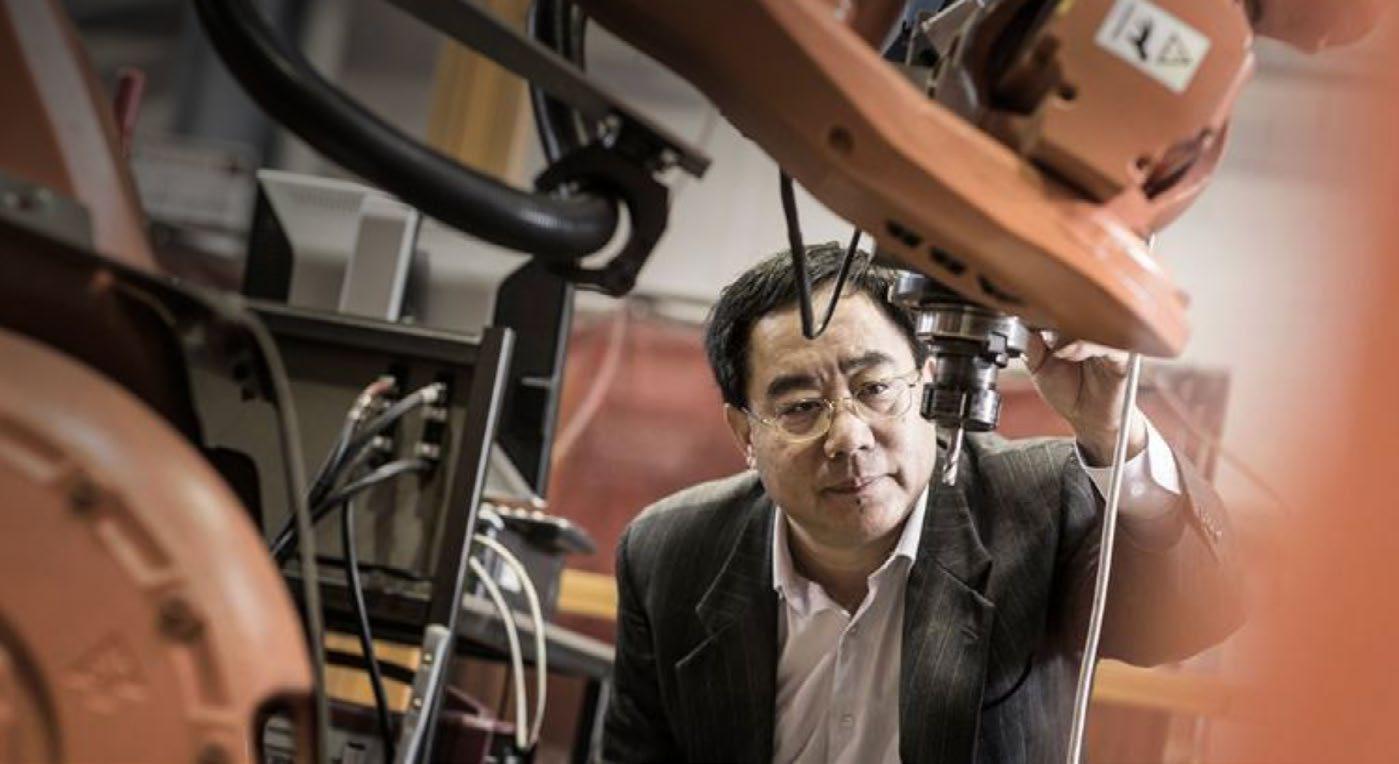
Senior professor Li has over 26 years’ research experience in materials science and engineering. He has published seven book chapters and more than 500 papers over his career in the field of welding metallurgy, additive manufacturing, alloy development, surface engineering, nuclear materials,
and microstructure characterisation. Senior professor Li serves as chief investigator on one of the hub's PhD led projects: Addictive manufacturing of welded overlay. This project is being undertaken by PhD candidate Durga Tandon in a collaboration between industry partner Bisalloy Steel (Dr Dake Yu and Dr Willy Peng) and UOW (including emeritus professor John Norrish and professor Zengxi Pan).
Part of the hub’s product innovation and technology program, the project is investigating automated additive wire arc manufacturing, to create multilayer hard-facing specialty steels with improved performance. For steel consumers, the benefit of this research is a product with improved performance, while also reducing maintenance, repair, and operational costs via prolonged service life.
The hub congratulates senior professor Li on his leading contribution to metallurgy research in Australia. The hub is proud to be working with some of the industry's preeminent academics and researchers.
| STEEL AUSTRALIA | AUTUMN 2023 37 INDUSTRY INSIGHTS
CLICK HERE TO LEARN MORE ABOUT THE STEEL RESEARCH HUB AND ITS PROJECTS >>>
Senior professor Huijun Li.
FEATURE: SKILLS AND EMPLOYMENT IN STEEL
Australian businesses—including those throughout the steel supply chain—are facing the tightest labour market since the 1970s. With skills shortages impacting everything from productivity, through to economic growth, businesses are implementing a raft of innovative recruitment, retention, upskilling and training programs. The ASI has also implemented several programs, as has the Federal Government.
According to the most recent data from the Australian Bureau of Statistics (ABS), there were 444,000 job vacancies in November 2022 – equivalent to 3.2 per cent of all jobs being currently unfilled. 28 per cent of businesses report current vacancies.
Staff shortages are bad, and are getting worse. According to the Ai Group's recent Skills Survey of Australian CEOs:
• 90 per cent of businesses expect to be affected by staffing shortages in 2023
• 36 per cent report that skills shortages will inhibit their business growth
• 26 per cent say that labour shortages will inhibit growth
In fact, staffing shortages were one of the three top challenges—the other two being inflation and supply chain disruptions—identified by business leaders for 2023.
This record high demand for skilled labour is being exacerbated by the flow-on effects of COVID-19, such as international border closures curtailing skilled immigration, as well as an economic recovery that hinges on largescale infrastructure projects.
The five-year pipeline of major federallyfunded infrastructure projects is valued at $237 billion. On top of this, countless skilled workers will be needed to build and install the wind and transmission towers, solar farms and other power generation assets needed to achieve the Federal Government’s 43 per cent emissions reductions target by 2030 and net zero by 2050.
Plus, there are countless projects in defence, state government funded projects, and private developments— all of which require skilled workers throughout the steel supply chain. In addition, with renewed focus on local manufacturing, and an ever growing focus on technology and innovation in general, the need for skilled labour is expected to grow.
Skill shortages in steel ABS data reveals that the Australian steel supply chain, from basic iron and steel production though to downstream users such as fabricators, employed nearly 110,000 Australians in 20172018 and generated annual revenue in the order of $29 billion. Despite the size and strength of the industry, the latest Federal Government Jobs and
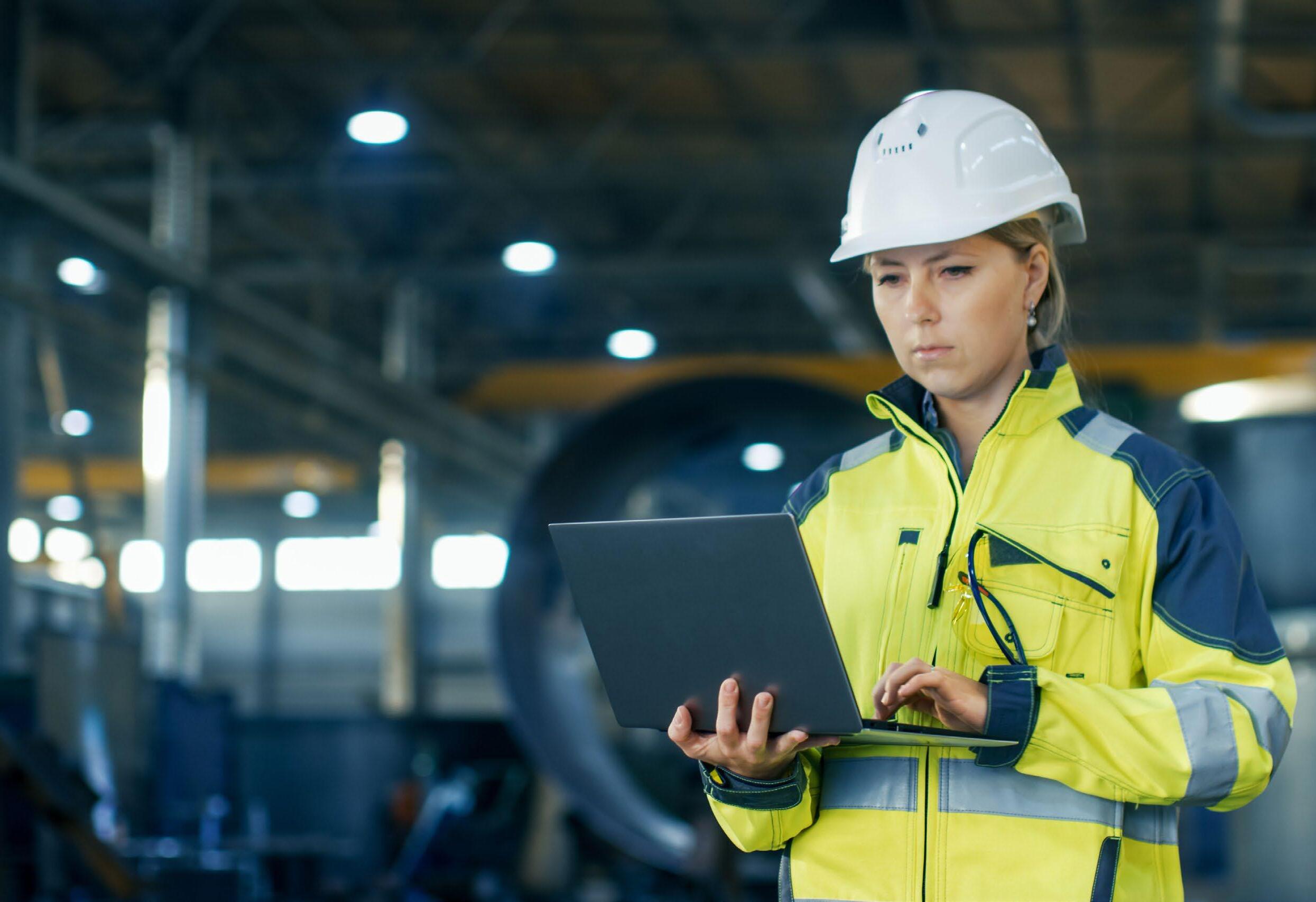
Skills Australia survey revealed skill shortages throughout the steel supply chain. Shortages were most prevalent within the technicians and trades workers occupation group, with almost half (47 per cent) of occupations in deficit, including sheet metal trades workers, metal fabricators, welders, fitter and turners, production and plant engineers, riggers, steel fixers and steel erectors. In response, the Federal Government has announced a range of apprenticeship incentives for employers and apprentices alike (see page 51).
Shortages in professional occupations (both steel and non-steel) also rose from 19 per cent to 35 per cent. In the steel industry, construction project managers, metallurgical and materials technicians, and engineers are in short supply.
Just 8.9 per cent of all Australian university graduates are engineers. This makes Australia one of the lowest producers of engineers in the OECD. This is compounded by an extremely low proportion of females in the industry, at around 11 per cent. And, the situation is forecast to worsen.
The difficulty is that, even before the COVID-19 pandemic and associated
international border closures, approximately 60 per cent of all working engineers in Australia were born overseas. Australia does not graduate enough engineers to meet our needs. And now, post-COVID, the global war for talent has become more fierce.
Over the next five years, the demand in engineering skills is predicted to outpace our population growth by 1.63 times. It is for this reason, that the ASI compiled resources on business sponsorship visas and procedures (see page 50).
Programs that encourage an interest in STEM skills from an early age, and attract high school students and university graduates into the steel industry—like that of the GFG Alliance— are playing an essential role in creating a pipeline of skills supply (see page 45).
Attracting and retaining skilled talent
It is little surprise then, that staff training is the top priority investment for businesses in 2023. Business process improvement, which helps utilise the existing skills base more effectively, came in a close second. And, according
to the Ai Group survey, 47 per cent of businesses reported that they had already increased their investment in staff training in 2022, the highest reported business investment in the tenyear history of the Ai Group's survey.
39 per cent of businesses are now willing to employ people with similar skill sets and further train them to fit their role—much like DBM Vircon (see page 48). With only 8 per cent reporting that they don’t expect to be affected by staff shortages in 2023, businesses instead need to ensure they can get the most from the workforce skills base that they already have or can realistically hire.
There are a range of ways businesses are looking into investing in training their staff. Using TAFE or a private RTO was the top result (27 per cent), with in-house training a close second (24 per cent).
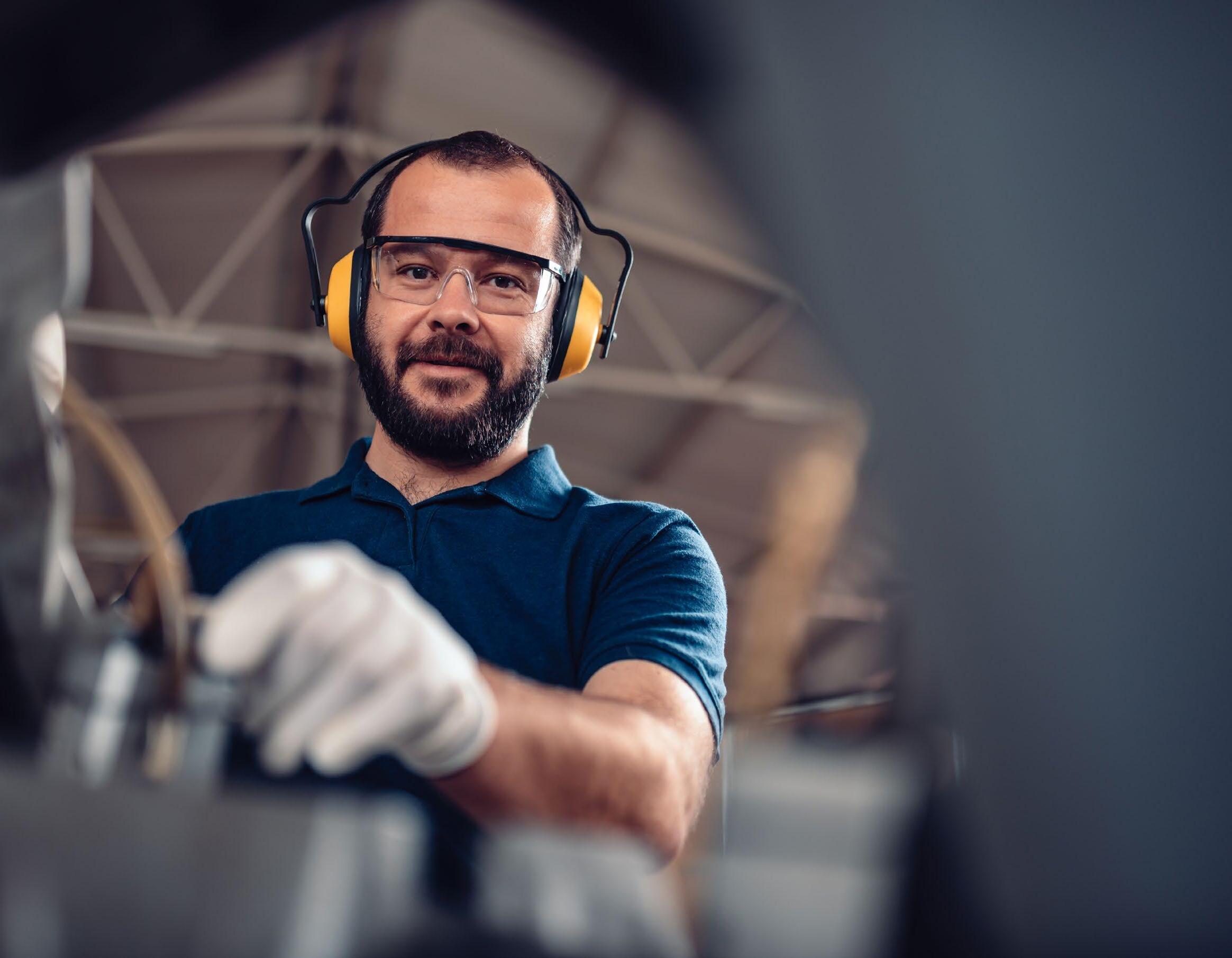
Some businesses—such as Fabinox and Precision Metal Group—have already established their own in-house training and upskilling programs (see page 46). While others are leveraging industry training, such as that provided by the ASI (see page 53).
Retaining skilled staff is also more important than ever. Employee benefit programs, learning and development, flexible working and wellbeing initiatives are top of the list, much like those of BlueScope (see page 44) and DBM Vircon (see page 48).
Diversity and inclusion are also crucial factors for attracting and retaining a skilled workforce. Organisations that embrace diversity and promote inclusion create a positive work culture that attracts and retains top talent. The benefits of having a diverse workforce go beyond just a better work environment; it can also lead to increased innovation, better decision-making, and improved financial performance.
Given all these benefits, it is little wonder that many of ASI's members—including Icon Metal, Protective Fencing Australia, and Structural Challenge—are firmly focused on fostering a diverse, inclusive workplace culture (see page 40).
| STEEL AUSTRALIA | AUTUMN 2023 39 FEATURE: SKILLS AND EMPLOYMENT
“
Staffing shortages were one of the three top challenges— the other two being inflation and supply chain disruptions —identified by business leaders for 2023. This record high demand for skilled labour is being exacerbated by the flow-on effects of COVID-19, such as international border closures curtailing skilled immigration, as well as an economic recovery that hinges on large-scale infrastructure projects."
DIVERSITY AND INCLUSION IN ATTRACTION AND RETENTION
Diversity and inclusion are crucial factors for attracting and retaining a skilled workforce. Organisations that embrace diversity and promote inclusion create a positive work culture that attracts and retains top talent. The benefits of having a diverse workforce go beyond just a better work environment; it can also lead to increased innovation, better decision-making, and improved financial performance.
A focus on diversity and inclusion enables organisations to tap into a wider pool of talent. In Australia, the workforce is becoming increasingly diverse, with workers from different ethnic backgrounds, genders, and age groups. According to the latest data from the Australian Bureau of Statistics, 30 per cent of the Australian population was born overseas, and 49 per cent of the population had at least one parent born overseas1. By having a diverse workforce that represents the broader community, organisations can access a wider range of skills, ideas, and perspectives, which can lead to improved business outcomes.
Furthermore, promoting diversity and inclusion in the workplace can also lead to higher employee satisfaction and retention rates. According to a recent report by Deloitte, employees
who feel included in their workplace are three times more likely to feel engaged and empowered to do their best work. In addition, when employees feel that their company values and respects their differences, they are more likely to remain with that company long-term.
Diverse, inclusive workforces can lead to better decision-making. According to a study by McKinsey & Company, companies with diverse executive teams are 33 per cent more likely to have better financial performance than companies without diverse teams2 Companies with inclusive cultures are:
• twice as likely to meet or exceed financial targets
• three times as likely to be highperforming
• six times more likely to be innovative and agile
• eight times more likely to achieve better business outcomes3
Diverse teams bring a variety of perspectives and experiences to the decision-making process, leading to more well-rounded and informed decisions. Given all these benefits, it is little wonder that many of ASI's members are firmly focused on fostering a diverse, inclusive workplace culture.
ICON METAL
Based in Western Sydney, Icon Metal specialises in architectural and structural steel fabrication and installation. The company offers a full range of construction services, from design and project management, to fabrication and installation. Their mission is to enhance the built environment, while nurturing their extraordinary people and delivering a quality product to their clients.

According to Icon Metal's chief executive officer, Stephen Pribula, "From the beginning, Icon Metal had a diverse, inclusive workforce. We were established in 1996, and started out with five employees. As the company grew, so did our workforce. By the time we had a team of 20 people, our workforce comprised six to eight different nationalities. Today, we have a team of over 60 people, which includes 20 different nationalities."
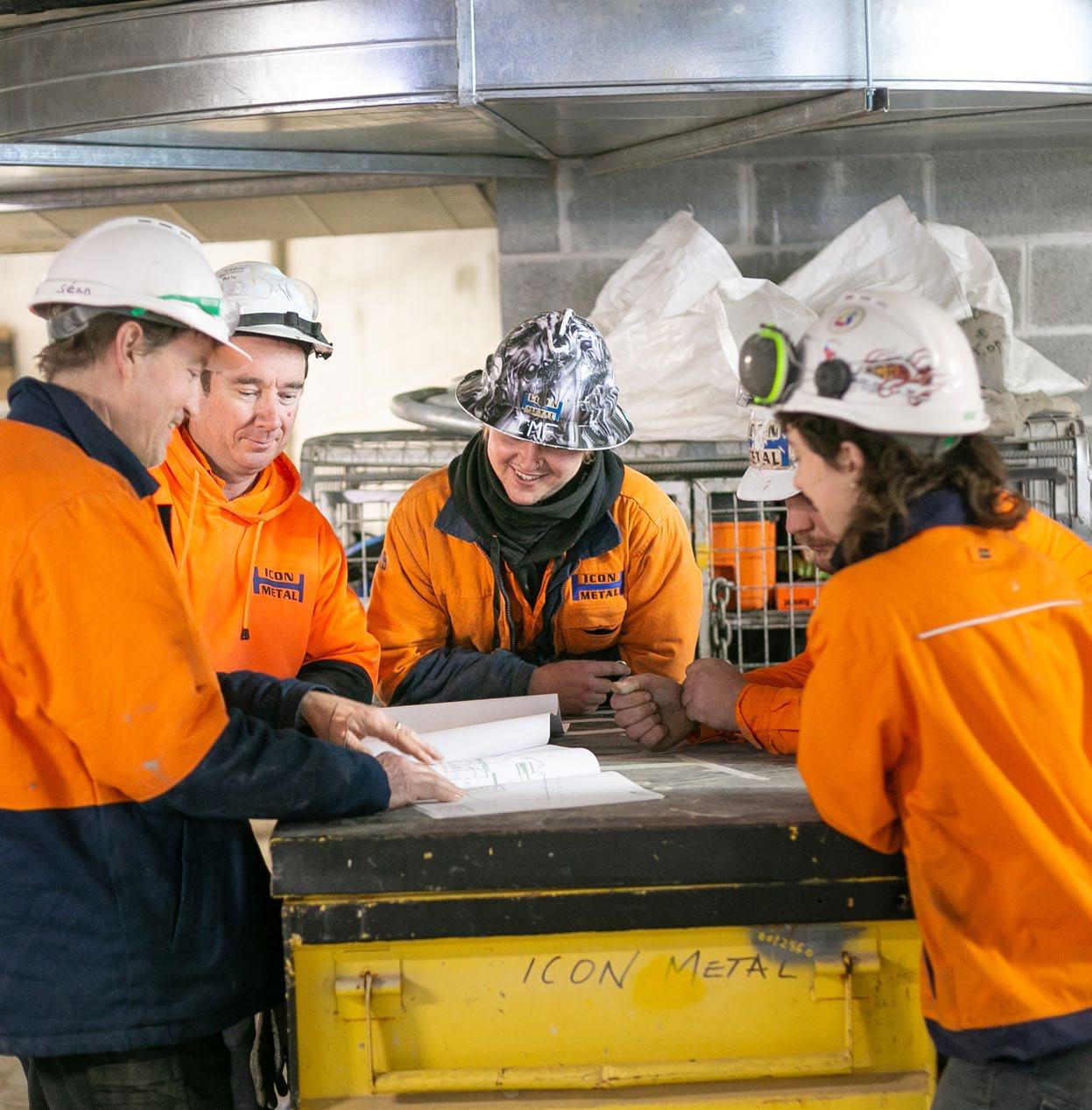
"We knew our diversity was an asset. So, we made the decision to grow and expand upon this. First, we formalised our inclusive workforce culture through policies and procedures—we wanted to officially document our approach."
A considerable amount of research and planning went into the development of these policies and procedures. The
Icon Metal welder works on structural steel for a major NSW Government infrastructure project.
Members of the Icon Metal team.
Icon Metal team reviewed applicable legislation, including the Human Rights Act 1998 and the Anti-Discrimination Act 1977, as well as a raft of other material.
"We settled on policies and procedures that made sense for our business. We knew these documents needed to be something we could live by—not just a box ticking exercise. You have to commit to, manage, monitor and review these documents. So they cannot be too cumbersome," Pribula said.
"All our policies and procedures are focused on informing employees of their rights, rather than telling them about their obligations. We include them in our induction packs and educate all our staff on our values: no one at Icon Metal is discriminated against based on their on age, marital status, race, religion, family responsibilities, pregnancy, political opinions or anything else. Our entire team understands what we believe as a leadership team and as a company."
Icon Metal's management team also ensures that all staff understand, and have access to, a clear conflict resolution process if grievances do arise.
Gender diversity
One area in which Icon Metal is always looking to improve is gender diversity. "As a major sub-contractor in Sydney, we see every day that women are more likely to work for tier one contractors, rather than sub-contractors like Icon

Metal. It is still a challenge to get women into workshops and trades. That got us wondering why this is, and how can we make it a more attractive option."
In fact, just 12 per cent of Australia's construction workforce is women, meaning the industry is missing out on employing half the working population— and this is at a time when a massive 105,000 additional construction workers are needed to deliver Australia's project pipeline.
"Our workforce currently has a female participation rate of 20 per cent. We are working to increase this to 25 per cent. Like most organisations in the construction and manufacturing sectors, our female staff are employed predominantly in areas like human resources, compliance and business development. We have one female on-site, but none on the factory floor. To help combat this, we have focused on making our workplace as flexible as possible."
"When we established our leadership group, we made sure that three out of the six roles were women. These women bring a different perspective—a perspective that I not only want, but need in my business," Pribula said.
Icon Metal is a Silver member of the National Association of Women in Construction (NAWIC), and encourage their female staff to take advantage of the benefits this can offer, from seminars and site visits to mentoring.
A focus on First Nations
In May 2021, Icon Metal had their first Reflect Reconciliation Action Plan endorsed by Reconciliation Australia. This was a long-held ambition for the company.
"We're placing a greater emphasis on Indigenous participation. We work with a couple of different employment agencies to attract First Nations people in the business, and currently employ two First Nations people," Pribula said.
This integrates with Icon's strong stance on mental health programs. Icon Metal is a stigma-free company, where it is OK to not be OK, and where the culture of silence that surrounds mental ill health is challenged. Through their partnership with workplace consultants Mental Health Movement, Icon Metal's staff have access to training, workshops and support.
For Icon Metal, their focus on an inclusive workforce has delivered only positive outcomes. "Our team really understands our focus on a diverse, inclusive culture. They see how this works in practice, and it gives them another purpose. It also helps ensure that they are committed to the business as a whole, for the long-term. Our focus on diversity and inclusion has definitely helped us to attract and retain the right sort of people," Pribula said.
| STEEL AUSTRALIA | AUTUMN 2023 41 FEATURE: SKILLS AND EMPLOYMENT
Quality control checks by Icon Metal.
PROTECTIVE FENCING AUSTRALIA
A family-owned manufacturing business, Protecting Fencing is Australia's trusted fencing partner. The company has been proudly manufacturing in Australia since 1973, using the highest quality locallysourced raw materials and the best machinery available.

Samantha Swain, the director of Protective Fencing and a trailblazing female leader in the construction and manufacturing industries, firmly believes that diversity and inclusion are crucial for success in any business. Drawing on her own experiences of feeling like a minority in the industry, she advocates for greater respect and appreciation of people from different ethnicities, genders, religions, and abilities. Her vision is to create a workplace culture that values and embraces diversity, where everyone feels included and empowered to contribute their unique perspectives and talents.
"We need to move towards the idea that no one person is at a disadvantage. People might have unique strengths and challenges, but increased abilities elsewhere. As industry leaders, we need to collaborate with individuals, and their abilities, to transfer their skills into the areas where they can be most valuable," Swain said.
Protective Fencing is committed to creating a workplace culture that champions diversity and inclusion. While recognising that larger tier one contractors have been successful in this area, Protective Fencing is determined to be just as progressive in its approach, despite being an SME. The company has developed a holistic strategy that is entirely focused on promoting diversity and inclusion, with the aim of fostering an environment where every team member feels valued, respected, and empowered to contribute their unique perspectives and talents.
"The first step we took was a review of our mission, values and behaviours. Our goal was to ensure that these elements reflected our inclusive work culture. With this in mind, as a team, we identified six core values for success. These are: tenacity, quality, integrity, sustainability, respect and accountability," Swain said.
“We then elaborated on each of these values and defined them with corresponding behaviours to give them more clarity and meaning in our context. Integrity, respect and accountability all directly relate to owning the way you behave and respecting other people’s diverse backgrounds."
"These six values and their
corresponding behaviours are promoted and reinforced to our team in everything we do—not just in yearly performance reviews, regular toolbox meetings, or in posters around the workshop, but in our everyday conversations within the business," Swain said. "Our company's values and corresponding behaviours not only empower our staff to drive our success, but also help us retain top talent. In addition, they serve as a clear indicator of whether someone is a good fit for our team in terms of our values and culture."
Practical implementation
Protective Fencing's successful implementation of its new mission, values, and behaviors is exemplified by a recent recruitment effort for a machine operator.
As Swain explained, "Initially, a 'traditional' job advertisement yielded a few male applicants, but none of them met the job requirements. However, when the company shifted its focus to promoting its inclusive and diverse work culture, along with benefits like proximity to home and teamwork, the response was remarkable. The second job advertisement attracted 20 applicants, of which over a quarter were female. After careful consideration, Protective Fencing hired a man and a woman who continue to work for the company today.”
"When you start promoting a diverse work culture, you improve the reach of your talent pool."
"Recruitment, retention and onboarding strategies need to change. The focus must be on the reason why people
would want to work with you—what makes your company a great place to work. The employment landscape has evolved, so companies must evolve with it. Job seekers have more options now than ever before. Society has moved away from the idea that it is the company interviewing a candidate— interviews are a two-way street. People want to work somewhere where they can wake up in the morning feeling motivated and enthusiastic about their day," Swain said.
Another important factor is offering workplace flexibility. For instance, it is important to have policies in place for parental leave. "Any parent—regardless of gender—should be equally able to care for their child. Having a management team that respects the shared responsibility of parents is important. Managers should not be asking fathers why they are taking time off to care for a child. Having a policy in place that recognises shared parenting arrangements is essential."
"Historically, this hasn’t been my experience. My husband and I both work full-time, have challenging jobs and share parenting equally. Fathers are just as entitled to parental care as mothers; parental responsibilities should be able to be shared equally."
"We are proud of what we have achieved so far, but we are even more excited about what the future holds for Protective Fencing as we continue to build a diverse and inclusive team that is focused on delivering the highest quality products and services for our customers."
Members of the Protective Fencing team.
STRUCTURAL CHALLENGE
Based in Melbourne, Structural Challenge is a client-focused, serviceoriented structural steel fabricator. With services extending right through to design, detailing and erection, Structural Challenge works across the commercial, health, education and infrastructure sectors.
According to their managing director, Maria Mavrikos, diversity and inclusiveness have always been an important company value for Structural Challenge.
"As a female who started in the industry 30 years ago—when there were no females working in fabrication—diversity has always been a priority for me. I am Greek-Cypriot and was a refugee when I first arrived in Australia. So I am passionate about helping people from disadvantaged backgrounds start their career in steel."
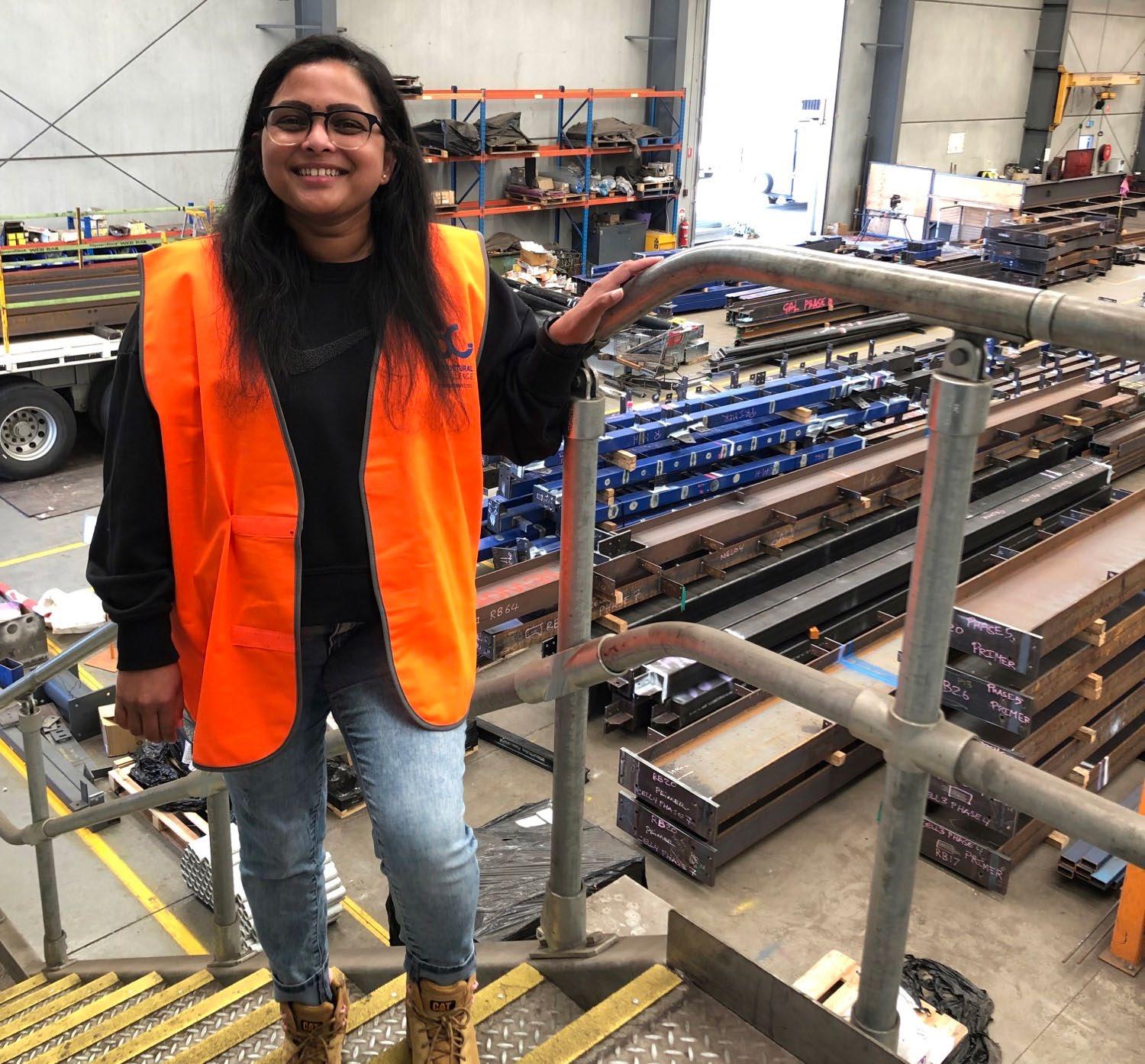
"As Structural Challenge has grown as a business, we have more resources to be able to put the right programs, policies and procedures in place, and actively promote diversity. All our policies are focused on ensuring equitable treatment, regardless of gender, nationality or ability," Mavrikos said.
"We have about 17 different nationalities that work here, so we do a lot in terms of celebrating multi-cultural initiatives."
Female workforce participation
Structural Challenge is also focused on increasing its female site engineers and tradespeople in the factory.
"Increasing gender diversity in our workforce has been quite a conscious action that we've taken over the last two years. For the first time in my 30 years in the industry, we have two female boilermakers, one female welder and one female labourer."
Structural Challenge has implemented several key programs that have helped facilitate greater workforce diversity. "We partner with Swinburne University and a couple of local schools, and host open days for the students. We encourage female students to come along, and create a comfortable environment for them. We emphasise that Structural Challenge is a female run business with a number of female employees," Mavrikos said.
"We have our female employees talk to the female students about the career paths and opportunities that are available. We emphasise that students have a whole range of options open to them: there is engineering, project management, detailing, site coordination, and more. Through these open days, we have had a number of girls do internships with us, and then go on to graduate programs."
"We take in three cohorts of interns
to change. The focus must be on the reason why people would want to work with you—what makes your company a great place to work. Society has moved away from the idea that it is the company interviewing a candidate—interviews are a two way street these days. People want to wake up in the morning, wanting to go to work and have a great day."
every year for a 12 week program and ensure that there are always females in each cohort."
"As an industry, we need to work more closely with high schools to promote opportunities in steel to kids at a young age—we can't wait for students to finish university. We need to plant the seed when they're in years nine and ten, undertaking work experience," Mavrikos said.
As a result of their programs, Structural Challenge boasts a female senior project manager, which is rare in the industry. Their senior project coordinator is also female.
"I’ve just started up a networking group called Steel Chicks, which enables females in the industry to get together, talk, mingle and support each other. I am also involved in other groups like Empowering Women in Trades. Everyone in the steel industry should support these types of groups, to encourage more women into the industry," Mavrikos said.
SOURCES
1 https://www.abs.gov.au/media-centre/media-releases/30-australias-population-born-overseas
2 https://www.mckinsey.com/capabilities/ people-and-organizational-performance/our-insights/delivering-through-diversity
3 https://www2.deloitte.com/us/en/insights/ deloitte-review/issue-22/diversity-and-inclusion-at-work-eight-powerful-truths.html
| STEEL AUSTRALIA | AUTUMN 2023 43 FEATURE: SKILLS AND EMPLOYMENT
“ Staff attraction, retention and onboarding campaigns need
Hari Jyothi Pandeti, project coordinator at Structural Challenge.
LIFE AT BLUESCOPE: CREATING OPPORTUNITY. CREATING STRENGTH.
BlueScope is
BlueScope is dedicated to supporting its people, keeping them safe, rewarding successes, and helping individuals grow. From learning and development opportunities to a range of programs and benefits that support and strengthen each and every one at different times. The company offers work-life flexibility through its B-flex program and makes sure an inclusive work environment welcomes people of all backgrounds.
Learning and development
BlueScope believes that learning is a right, not a privilege. The company invests continuously in development, offering opportunities to expand, diversify and strengthen their employees’ experience.

Krystal Storey began with BlueScope Distribution in 2013 as a key account manager. Her aim was to become a sales manager or location manager with responsibility for making sure a business segment worked successfully. Today, Storey is the Branch Manager at Albury which is one of the largest regional sites in the country.
As Storey looked back over her BlueScope time, she explained, “All the way through, I have been offered different projects or targets to keep me motivated and I have been able to take on more responsibility to allow me to mature in the business."
“For my long-term career progression, one of the best parts of what the company has offered me has been the vast array of training and personal development opportunities. I have been able to be a part of many different project teams and professional
development platforms. These have included a Leadership Essentials training program and Acceleration P&L program."
A more flexible future with B-flex
The workplace of the future is a more flexible one, and something BlueScope has been working on for a while. At the heart of B-flex is the belief that all roles have some degree of flexibility, some more than others.
For some of BlueScope's employees, it’s about compressing their hours, creating a four-day week, a nine-day fortnight or even simply a monthly rostered day off (RDO). Others have come up with ways of sharing roles: for example, two supervisors in the Western Port mill share a position month on, month off. As one stated, “I’ve got a lot still to offer the company in terms of experience and knowledge and this gives me the best of both worlds”.
One of the new job-share working arrangements even involves a fatherand-daughter duo, with the dad transitioning towards retirement and his daughter balancing work with the enjoyment and demands of having a young family. “It’s perfect. Dad and I get to work the hours that fit in with the lives each of us want to have.”
The greatest appeal of B-flex has been the improvement in lifestyle balance. Not surprisingly, workers report improved mental health, lifestyle
and job satisfaction. At the same time, management has found that a happier, more flexible workforce has also led to things like better productivity, less absenteeism, and improved safety.
Social impact and inclusion
BlueScope integrates social impact and inclusion into everything they do: community partnerships and networks; human rights; comfort to speak up, feeling safe at work; and building leadership capability. BlueScope's inclusion and diversity goal is for an organisation where all people who work for or with them—regardless of how they identify themselves—feel valued and included at work.
Health and wellbeing
BlueScope employees have access to an extensive health and wellbeing program. It provides a wealth of offerings such as counselling, financial and legal services, as well as access to a wellbeing platform with resources and self-help tools focused on fitness, nutrition, and mental health.
BlueScope also offers a range of extra employee benefits like additional leave entitlements, education and assistance with further studies, and their Real Deals program. This program gives employees a wide range of special offers on products and services from strategic partners, like health insurance, accommodation, flights, car hire, IT products and even new cars.
CLICK HERE TO LEARN MORE ABOUT LIFE AT BLUESCOPE >>>
an Australian-born, global success story, spanning 18 countries, with a team of over 15,000 people. The company is driven by innovation and is proud that the technologies in its products and brands, like COLORBOND® steel, inspire and protect everything from hospitals and bridges to stadiums and homes.
GFG ALLIANCE: SHORING UP A PIPELINE OF SKILLED TALENT
Pipelines Program
Since establishing its Pipelines career development program in 2019, GFG Alliance has employed more than 200 apprentices, graduates, vacation students and trainees across its LIBERTY Primary Steel Whyalla Steelworks and SIMEC Mining Iron Ore operation.

Executive general manager human resources Mark Wakelin said the Pipeline Program’s influx of new people and fresh skills was complementing GFG’s Whyalla transformation plans while providing career opportunities in South Australia.
“As the business strategically plans for new technologies we must also invest in our people, equipping them with new skills and developing new talent,” Wakelin said. "Our fantastic Pipelines Program is introducing that new talent to our businesses and providing the opportunities for them to develop those skills with GFG while playing a key role in an exciting future.”
GFG Alliance started the Pipelines Program with the redevelopment of the Whyalla Mining and Primary Steel operations’ apprenticeship program while the graduate and vacation student programs were also revitalised after a ten-year hiatus.
Head of Organisational Development, Bianca Standing said the Pipeline Program had now employed 101 apprentices, 32 vacation students, 60 graduates and 24 trainees in Whyalla since its launch in 2020.
“Our apprentice program is not only focussed on their technical trade skill, but also provides our apprentices with
professional development to assist with the transition for many of them from school to working life,” Standing said.
“Our graduate program is providing amazing employment opportunities for university students who have finished their degree or post graduate studies and are now commencing their professional careers, applying their theoretical study into an operational environment."
"The graduate program is a key talent pipeline for our business ensuring we continue to develop the capability we need to support our transformation journey."
“We are not only seeing an influx of fresh faces and new ideas, we are also seeing our future leaders joining the company,” Standing said.
GFG Alliance has started preparations for the 2023-2024 Pipelines Program intake of vacation students, apprentices and graduates with a call for expressions of interest.
Vacation student program
The GFG Alliance Vacation Student Program continues to build momentum with 18 fresh faces introduced to the company’s Australian operations this summer. Fourteen university students participated in vacation placements at
Whyalla Mining and Primary Steel. Another three students gained experience at the LIBERTY Bell Bay Manganese Smelter in Tasmania and one student at the Tahmoor Coal Operations in New South Wales.
The vacation students were in their penultimate year of university study ranging across engineering disciplines. During their threemonth vacation program, they were assigned to a relevant area of the business to apply their theoretical knowledge, gain experience in an operational setting and work on projects.
Standing said the vacation students’ arrival at the business was exciting and energised the workforce as the program demonstrates the business’s commitment to rebuilding talent pipelines and subsequently building future capability. The vacation program is a key feeder to GFG’s Pipelines Program.
“Seeing these students coming in gives the business a real lift,” Standing said. “The Vacation Student Program generates real excitement in the workplace as we see the potential progression into positions within the Graduate Program for these bright students.”
| STEEL AUSTRALIA | AUTUMN 2023 45 FEATURE: SKILLS AND EMPLOYMENT
CLICK HERE TO LEARN MORE ABOUT THE GFG ALLIANCE IN WHYALLA
>>>
The GFG Alliance employs 35,000 people across 30 countries. With such a large, diverse workforce, attracting the right people with the right skills is essential. The GFG Alliance has some key programs designed to appeal to apprentices and graduates.
INDUSTRY TRAINING INITIATIVES HELP COMBAT WELDER SHORTAGES
Australia's welding industry is facing a looming skills crisis. With record levels of spending on infrastructure, construction playing a huge role in the post-COVID economic recovery, and countless renewable energy projects on the horizon, welders are more in demand than ever. Industry is working to combat these skill deficiencies with their own unique training and student outreach programs.
Australia will have a shortfall of 70,000 welders by 2030. The skills crisis is not unique to Australia; the US fabrication industry will face a shortage of 500,000 welders by 2030, and by 2050 Japan will need around 250,000 welders.
The Federal Government recently added an extra 39 occupations to the Australian Apprenticeships Priority List. The list has grown to encompass 111 occupations, as Australia continues to struggle with skills shortages across a range of different sectors—particularly welding and fabrication. Several occupations related to welding and fabrication were added to the Priority List, including Welder, Pressure Welder, Fitter, Metal Fabricator, Metal Machinist, Metal Casting Trades Worker, Sheetmetal Trades Worker, and Blacksmith. In fact, 11 per cent of the occupations included in the Priority List are now related to welding.
It is little wonder that Australia is facing a looming welder shortage. The five-year pipeline of major federally-funded infrastructure projects is valued at $237 billion. On top of this, countless skilled welders will be needed to build and install the wind and transmission towers, solar farms and other power generation assets needed to achieve the Federal Government’s 43 per cent emissions reductions target by 2030 and net zero by 2050. Plus, there are countless projects in defence, state government funded projects, and private developments—all of which require welders.
Given this looming shortage, some of ASI's members are working on innovative training programs to upskill the next generation of welders.
The Fabinox welding academy

Fabinox is a Sydney-based company that provides
full service fabrication and installation of structural steel, architectural steel and process piping. Fabinox has invested in world-class facilities, operating across three separate workshops—totalling over 5,000m2 of floorspace—in Riverstone.

Fabinox boasts a wide portfolio of major clients and projects. In the oil and gas sector, Fabinox has completed work for Quenos, ExxonMobil and KBR. In the construction industry, Fabinox boasts high-profile clients such as Multiplex, Lendlease, Lang O’Rourke, Built and Mirvac. When it comes to water treatment, just some of their clients include Veolia, Downer, UGL, Hunter Water and Icon Water.
With a list of clients that features some of the most highprofile firms in Australia, it comes as no surprise that Fabinox has been involved in some of Australia’s most recognisable projects, from the Barangaroo development, the T1 International Airport and Hawkesbury Race Tower in Sydney, through to current work at Crown Casino in Sydney.
Struggling to attract new recruits, Fabinox recently established its own welding academy. The Fabinox Welding Academy is comprised of theory rooms, as well as 13 welding bays, which are each fitted with individual fume extraction and the latest high-tech welding machines. Fabinox has also acquired some of the most modern and up-to-date virtual reality welding simulators, to enhance student learning.
According to David Lortan (the owner and general manager of Fabinox), “Building a Registered Training Organisation places a great demand on a company and requires industry expertise outside of mainstream management lines, which can be a costly and time consuming exercise. Despite this, we decided to purchase an RTO to sit within the Fabinox company umbrella to provide a holistic learning and development solution for both our current staff and future clients.”
CLICK HERE TO LEARN MORE ABOUT THE FABINOX WELDING ACADEMY >>>
The Fabinox welding academy offers a Certificate III - Metal Fabrication (Welding and Fabrication), as well as a range of non-accredited courses that cover TIG (GTAW), MIG (GMAW) and Stick (MMAW) welding. In addition, Fabinox has developed a flexible, student focused pathway that allows students to obtain AS 1796 welding tickets 1 to 9 anytime, anywhere in the country. Welding tickets 1 to 9 of AS 1796 cover the welding craft skills for all common welding processes such as MMAW, GTAW, GMAW, FCAW, OAW and SAW. Fabinox Welding Academy is able to facilitate welder testing on site and provide welder coaching. The welding theory is dealt with in the same manner as the above welding supervisor exams.
Precision Metal Group trains iSTEM high school students
Similarly, another ASI member, Precision Metal Group (PMG) began partnering with Parramatta Marist High School to develop a metals and welding training program in 2020. The shared vision is to have more and more students exposed to the industry, and certified as armoured vehicle welders before they graduate from Parramatta Marist. This will provide students with career pathways that are supported by a skill set in demand by the Australian Defence Force.

To begin, Year 10 iSTEM students rotate through fortnightly two hour welding core skills workshops, while selfnominated students undertake intensive welding training at PMG’s facility in Wetherill Park.
PMG chief executive, Jason Elias said students, including those preparing to enter university, who are keen to try a trade will be trained in welding, drafting, automation and areas of engineering needed in the industry.
“We aim to expose our students to Australian as well as international manufacturing standards so that they are ready where there is current skills and talents shortage,” Elias said.
“We need talents for defence industry manufacturing, in building infrastructure which is taking off everywhere, in automation, and coding and that is why we need to get our students into early training and taking on apprenticeships that will become part of their future solid career path.”
Elias said they teach engineering technology so students get the idea that “it is no longer the old, dungeon style dirty welding but the new technology is clean and safe. There is a huge need for quality trained tradesmen for industries with special requirements.”
“Given a huge demand for manufacturing since the pandemic, we have to innovate and be creative to fill the gaps and meet shortfalls in the market,” Elias said. “Having specialist welders will enable Australia to produce our own welded materials without having to rely on imports, and even produce our own materials for export.”
Jason Elias established Precision Metal Group in 2000 in Yennora, Western Sydney after his highly successful boilermaker apprenticeship—he was named Apprentice of the Year three years in a row. After eight successful years as a sole trader, Elias formed a company and moving into bigger premises at Wetherill Park. Ten years on, PMG boasts a team of over 40 employees, delivers innovative, quality work, and is involved with some of Australia’s biggest companies and projects.
Working across sectors such as defence, infrastructure, construction, oil and gas, rail, mining and manufacturing, PMG has been involved in high-profile projects like Rheinmetall’s Boxer Land 400 parts and seats for major rail supplier Probatec.
| STEEL AUSTRALIA | AUTUMN 2023 47
CLICK HERE TO LEARN MORE ABOUT PRECISION METAL GROUP AND THEIR CAPABILITIES >>>
FEATURE: SKILLS AND EMPLOYMENT
“
We need talents for defence industry manufacturing, in building infrastructure which is taking off everywhere, in automation, and coding and that is why we need to get our students into early training and taking on apprenticeships that will become part of their future solid career path.”
PMG chief executive, Jason Elias, talks to students from Parramatta Marist High School.
ATTRACTING & RETAINING TOP TALENT IS ALL IN THE DETAILS AT DBM VIRCON
With operations in eight countries and a team of over 950 highly trained professionals, DBM Vircon is one of the most comprehensive and sophisticated 3D modeling, detailing and digital engineering companies in the world. Despite the depth and breadth of their expertise, and work on some amazing projects, DBM Vircon is facing skills shortages—just like much of the steel supply chain.
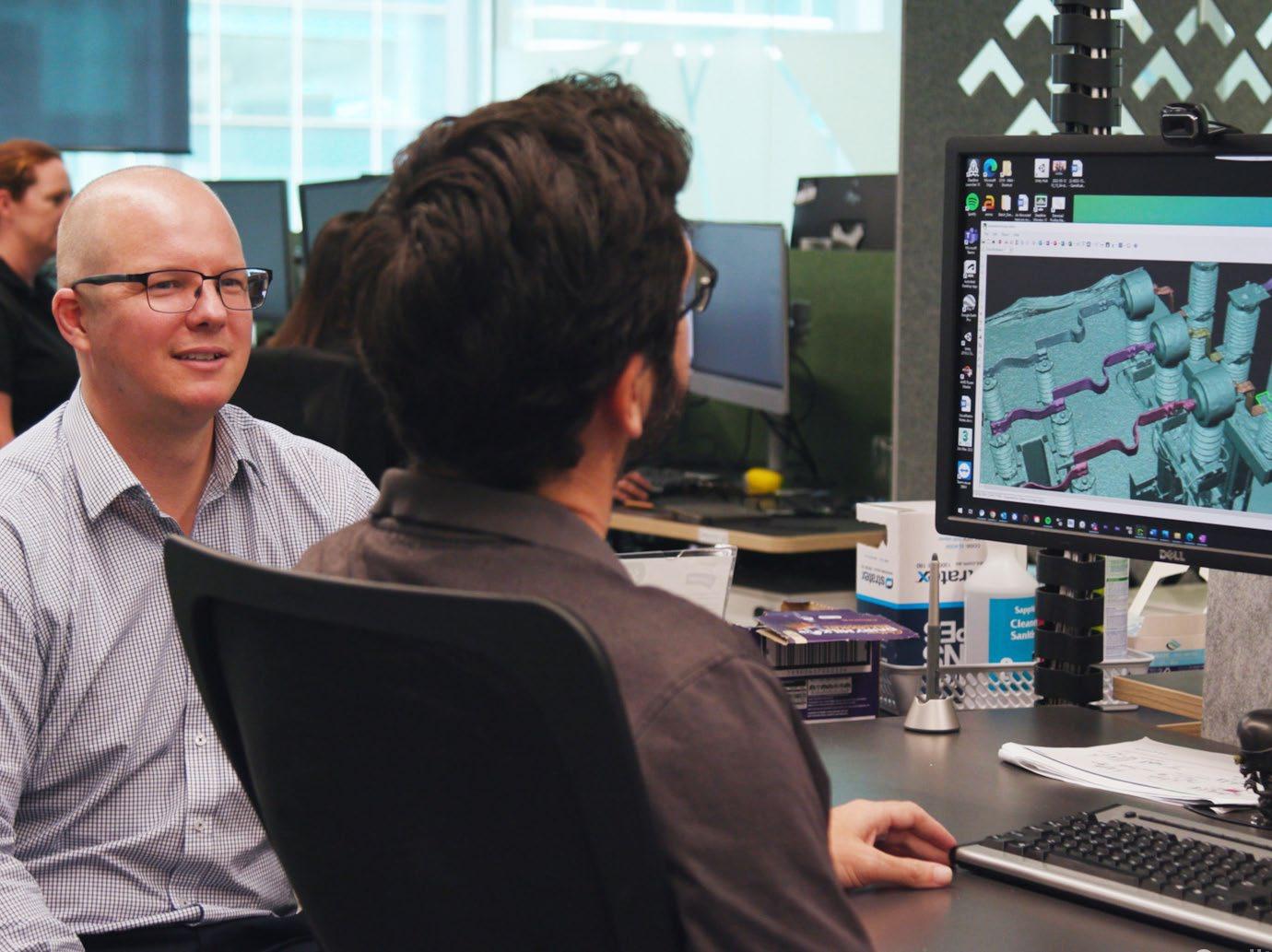
As DBM Vircon's global general manager of people, performance and culture Emily Bates described, "We've always had a tough market in which to recruit because steel detailing is quite niche. However, post-COVID, it is even more difficult. While we are still finding talent, it is taking longer to fill roles and we are paying above market rates where it’s required to secure the candidate."
The changing nature of steel detailing, and a shift towards digital delivery for large-scale construction, infrastructure and mining projects is also impacting downstream skills and recruitment.
According to DBM Vircon's chief executive officer, Mark Campbell, "The traditional steel detailing skillset was focused solely on detailing and delivery of shop drawings. We now find ourselves operating across a much broader remit, working not only for steel fabricators,
but for general contractors, engineering houses, and asset owners. This has expanded the skillsets we rely upon to encompass 3D modelling, animation and digital engineering using advanced software. So, while the pool of talent becomes broader, that same talent also has a broader choice of roles."
Attracting top talent
Faced with such a competitive market, DBM Vircon has responded with a raft of strategies designed to help attract top talent. For instance, they offer generous referral bonuses to their existing team members who recommend talent for vacancies.
The company has also diversified its approach to recruitment, looking for people in divergent industries with transferrable skills. For instance, video game programmers often possess the same skills, and use similar software and systems, as a digital engineer.
An emphasis on company culture also plays a key role. "Traditionally, our recruitment strategies were quite passive. Now, we have to be a lot more proactive. We regularly highlight and showcase what it is like to work at DBM Vircon, and why our people stay with us for so long. We proactively promote the culture we've built, including factors like the chance to work on fantastic highprofile projects globally, to be mobile
and work in numerous offices right around the world," Campbell said.
"We have developed an employee value proposition that is as holistic as possible—one that attracts new employees and then gives them a compelling reason to stay. We make sure all our employees are valued and understood, and have the opportunity to build a fulfilling career with us."
"We have a great culture, strengthened by team building opportunities, as well as more informal things like morning teas, or ping pong competitions. We work hard to create a place where people want to come to work, like their colleagues, and enjoy what they do," Campbell said.
Flexible workplace arrangements are a standard practice. "DBM Vircon is a really family friendly company to join. We have family days, with parents encouraged to bring their kids along. Three members of our executive management team are mums with young children. We recognise that work—while important—is just one small part of people's lives," Bates said.
The next generation of steel detailers DBM Vircon fosters strong relationships with TAFEs and universities to target the next generation of steel detailers. Although, the path from tertiary education to employment is not straightforward for steel detailing. In New South Wales and Western Australia, TAFEs offer a construction modelling course. However, this is not the case in Queensland. In the sunshine state, budding steel detailers usually undertake an engineering diploma that includes a subject or two focused on steel detailing. The problem is, graduates then often go into engineering, rather than detailing.
According to DBM Vircon's global general manager of industrial David Dawson, "TAFEs can be segmented in terms of their alignment with industry needs. The steel industry is quite niche within itself, and then steel detailing is even more niche within that. It makes it difficult to align TAFE course content with our day-to-day operations. There needs to be alignment on both sides of the equation—industry needs to work with TAFEs and vice versa."
"The steel industry is becoming more and more progressive, and embracing new technology. From steel detailing through to fabrication and erection, technology is now embedded in all aspects of the industry. Both industry and TAFEs need to demonstrate this— steel is no longer the industry of the boilermaker working in a dark workshop. It is a professional environment that leverages innovative, cutting edge technology to build some of the world's most impressive pieces of infrastructure," Dawson said.
While not a simple dilemma to solve, DBM Vircon does have one solution to this misalignment between TAFE and industry. "We're hoping that, in the future, we could partner with other organisations and industry bodies to devise a solution. For example, in Vancouver, we have partnered with a specialist college to create the equivalent of a Certificate III in CAD detailing. It would be fantastic if the Australian industry came together to create something similar," Bates said.
DBM Vircon also facilitates a formal four-year cadet program. Established in 1964, the structured, on-the-job training and development program encompasses many or all aspects of design, 3D modelling, detailing and sometimes even digital engineering. It goes above and beyond standard professional development to include one-on-one mentoring and in-depth career guidance.
There is also a role for government to play. While there are government incentives for apprenticeships, there is room for government support for professional service roles, like steel detailing.
"There is definitely a gap in government support between traditional blue collar

roles, and professional service roles like steel detailing. Post-COVID there is a real challenge in terms of mobility of skillsets across international borders. With a booming mining sector, huge investment in infrastructure along the east coast, and a variety of projects underway for the 2032 Brisbane Olympics, the government needs to find a way to attract people into Australia, including through expedited visa programs," Campbell said.
"The steel industry needs to come together to lobby governments to fund internships and provide incentives for cadets and trainees to attract young people into steel," Bates said.
Retaining a talented team
A vital part of DBM Vircon's staff retention strategy is continuous learning and development. All of DBM Vircon's managers undertake an advanced leadership program. The underlying principles of this program align with DBM Vircon's core values.
"We invest in the leadership capabilities of our managers, so that they have the ability to engage and provide direction to staff. Our continuous learning and development program helps ensure that our people can grow and achieve their career aspirations," Campbell said.
DBM Vircon also has a formal Excellence Development and Accreditation (EDA) program. The EDA encourages team members to complete a range of activities to hone their existing skills, extend their knowledge, and keep-upto-date with technical innovations. These activities include things like mentoring, internal and external training courses, conferences, and more informal learning, like reading recommended materials or listening to recommended podcasts.
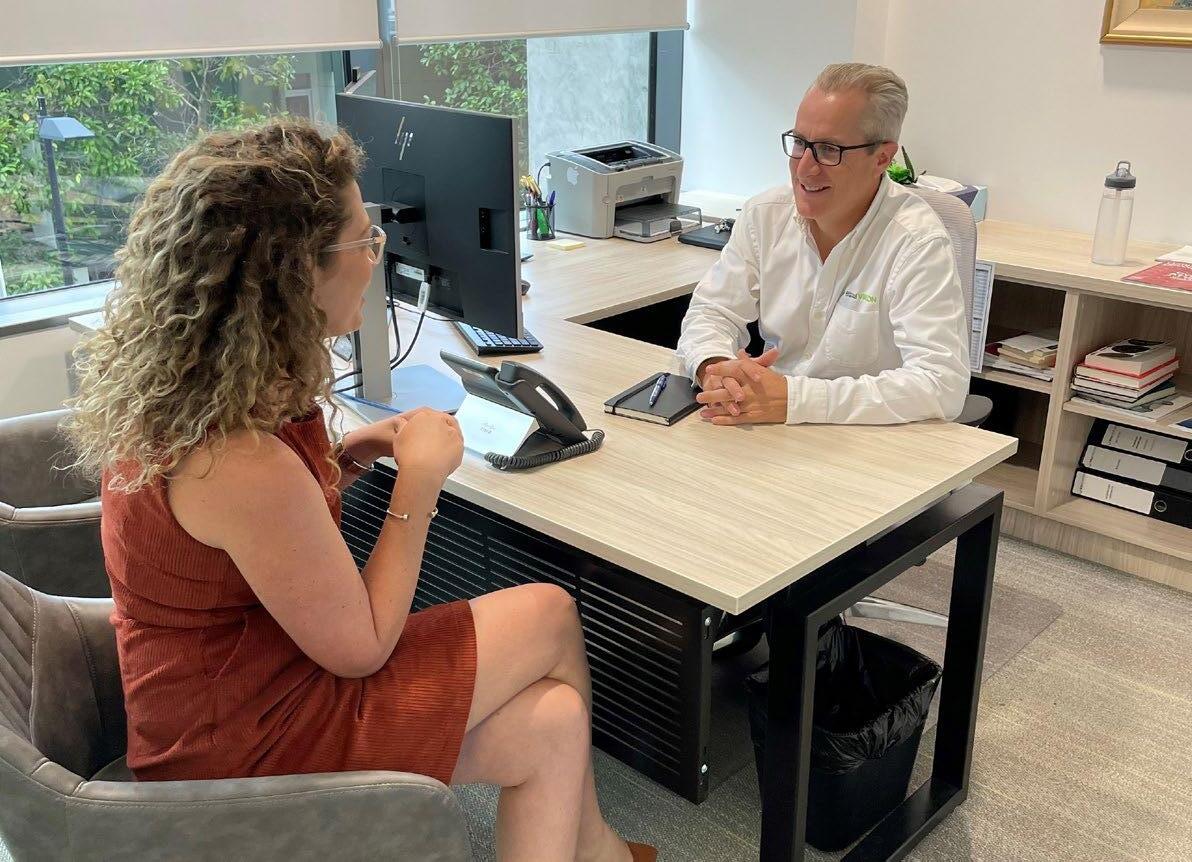
| STEEL AUSTRALIA | AUTUMN 2023 49 FEATURE: SKILLS AND EMPLOYMENT
“ We have developed an employee value proposition that is as holistic as possible— one that attracts new employees and then gives them a compelling reason to stay. We make sure all our employees are valued and understood, and have the opportunity to build a fulfilling career with us."
IMAGES
Far Left: L to R: Russell Bell (Operations Manager - Digital Engineering) and Ben Troughton (Creative LeadVisualisation).
Above (Left): L to R: Christine Jefferies (Global General Manager Marketing and Communications) and Mark Campbell (CEO).
CLICK
>>>
Above (Right): Jack Tams started with DBM Vircon as a cadet in steel detailing and is now a digital project coordinator.
HERE TO LEARN MORE ABOUT DBM VIRCON AND THEIR CAPABILITIES
BUSINESS SPONSORSHIP VISAS AND PROCEDURES
Australia’s skills shortage is having a significant impact on the steel and construction industries. One reason for this skills shortage is the travel restrictions implemented in the wake of the COVID-19 pandemic, which limited the number of overseas workers immigrating to Australia. With Australia’s borders now re-opened, businesses can take advantage of various business sponsorship visas, detailed below. ASI has also developed a resource pack to help members.
Skills shortages persist
The steel industry is experiencing a shortage of skilled workers in various areas, including welding, fabrication and maintenance. To help address this shortage, the Federal Government has implemented several measures, including incentives for apprenticeships and training programs to upskill existing workers. However, it may take some time for these measures to have a significant impact on the industry. In the meantime, sponsoring skilled workers may help alleviate the shortages.
Sponsoring a worker: the process
A variety of safeguards exist within employer sponsored visas that are designed to put job opportunities for Australian workers first. These ensure that overseas workers complement, but do not displace Australian workers. These safeguards include:
• requiring market salaries to be paid to sponsored workers
• mandating a minimum salary of $53,900
• limiting the occupations that are eligible for employer sponsorship to only those determined to be in demand by the Department of Education, Skills and Employment
• employers must contribute to the skilling australians fund
• requiring overseas workers to hold relevant Australian registration, licences and certificates
• skills, English language, age, and work experience requirements for overseas workers
Who can become a sponsor
Any legally established and operating business can apply to be a sponsor. A business or organisation can be approved for different types of sponsorships – for example, they may hold both a standard business sponsorship as well as a labour agreement at the same time. The support you must provide the visa holder and your other obligations depend on:
• your responsibilities as an employer
• the type of visa you and the worker choose
Who you can sponsor
You might be able to sponsor a skilled worker to come to Australia if you can’t find an Australian citizen or permanent
resident with the skills and experience needed for the job. You can sponsor workers temporarily or permanently. You can sponsor someone who is a skilled worker:

• living overseas who wishes to travel and work in Australia, or
• already in Australia on another type of visa which does not currently allow them to work, or
• already living and working on another visa in Australia
You can also take over the sponsorship of people holding a temporary work skilled visa (subclass 457) or a temporary skill shortage visa (subclass 482).
With limited exceptions, the job you sponsor the overseas worker to do must be on the skilled occupations list. If the job is not on the list, you might be able to negotiate a labour agreement. For high-skill niche roles that can’t be filled through existing visa programs you could access the global talent scheme.
Where to go for help
The Federal Government’s Department of Home Affairs is responsible for immigration in Australia. There is a dedicated resource in each state to help businesses navigate the process of sponsoring a skilled worker. Business Industry Regional Officers (BIROs) are available to answer individual questions and provide further information. Their contact details are below.
Australian Capital Territory BIRO.ACT@homeaffairs.gov.au
New South Wales BIRO.NSW@homeaffairs.gov.au
Queensland & Northern Territory BIRO.QLD.NT@homeaffairs.gov.au
South Australia BIRO.SA@homeaffairs.gov.au
Victoria & Tasmania BIRO.VIC.TAS@homeaffairs.gov.au
Western Australia BIRO.WA@homeaffairs.gov.au
CLICK HERE O DOWNLOAD ASI's BUSINESS SPONSORSHIP VISAS RESOURCE >>>
THE AUSTRALIAN APPRENTICESHIPS INCENTIVE SYSTEM
Apprenticeships play a critical role in supporting access to secure, well-paid jobs. They create a pipeline of skills and talent in the Australian workforce, helping businesses meet their current and future skills needs, and realise the opportunities of a recovering economy. With the roll-out of the Australian apprenticeships incentive system, there has never been a better time to take on—or become—an apprentice.
What is the Australian apprenticeships incentive system?
Commencing on 1 July 2022, the aim of the Australian apprenticeships incentive system is to get apprentices working in secure jobs that are in demand, filling skill shortages now and into the future. It is designed to encourage employers to take on Australian apprentices by assisting with the costs associated.
Incentives for employers
As an employer of an Australian apprentice, you may be eligible for financial support from the Federal Government to help offset the cost of taking on an apprentice. There are three key incentives, as outlined below.
Priority wage subsidy: this is a wage subsidy for employers of new or recommencing Australian apprentices undertaking a Certificate III or above qualification towards an occupation listed on the Australian apprenticeships priority list. Employers can claim 10 per cent of a wage paid to each Australian apprentice for the first and second 12-month period (up to $1,500 per quarter) and 5 per cent of the wages paid to the Australian apprentice for the third 12-month period (up to $750 per quarter). Employers can claim up to $15,000 per annum under the wage subsidy.
Hiring incentive: this is designed to support Australian apprentices undertaking a Certificate II or above qualification
that is not listed on the Australian apprenticeships priority List. A payment of $1,750 for a full-time apprentice and $875 for part-time apprentice is paid in two installments at six and 12 months after commencement, up to a maximum value of $3,500 per annum.
Disability Australian apprentice wage support: this provides additional assistance to employers who employ an Australian apprentice with disability in a Certificate II or above qualification. Employers may be eligible for a payment of $104.30 per week for a full-time apprentice. Part-time apprentices are paid on a pro-rata scale.

Incentives for apprentices
There are also three key incentives for apprentices: the training support payment, the new energy apprentice support payment, and living away from home allowance.
Australian apprentice training support payment: this is direct financial assistance for apprentices undertaking a Certificate III or above qualification for occupations listed on the Australian apprenticeship priority list. For new full-time apprentices, a direct payment of up to $1,250 is made every six months for the first two years of their apprenticeship.
New energy apprentice support payment: this is direct financial assistance for Australian apprentices undertaking a Certificate III or above qualification for occupations listed on the Australian apprenticeship priority list and identified as being related to clean energy. A direct payment of up to $2,000 is made at six, 12, 24 and 36 months, and at completion of the apprenticeship.
Living away from home allowance: if apprentices have to move away from the home of their parent or guardian for the first time to commence or remain in an apprenticeship or are homeless, they may be eligible for the living away from home allowance. For the first 12 months, this is a payment of up to $77.17 per week, with the weekly payment amounts decreasing throughout the apprenticeship.
| STEEL AUSTRALIA | AUTUMN 2023 51 FEATURE: SKILLS AND EMPLOYMENT
MORE
THE APPRENTICESHIPS INCENTIVE SYSTEM >>>
CLICK HERE TO LEARN
ABOUT
ASI' s SKILLS AND EMPLOYMENT RESOURCES
The Australian Steel Institute (ASI) believes that education is our best opportunity to support a highly effective and efficient supply chain—from engineers, architects, fabricators, right through to students and academics. It is also one of the most effective ways to overcome the skilled labour shortages being experienced right across Australia. The ASI is working on several new initiatives for steel detailers and rollformers, and has recently released an accredited training course for shed builders, as well as a series of 'Induction to Steel' training courses.
In response to member feedback, the ASI is facilitating industry-led training and certification programs designed to develop much-needed skills and expertise in various aspects of steel manufacturing, assembly and installation. A selection of the training initiatives we are working on is outlined below.
Steel detailers training
With the support of the Australian Construction Modellers Association (ACMA), the ASI recently held the webcast seminar Introduction to Steel Detailing and Construction Modelling, which was prepared and presented by Paul McLeod of Tekcon Services.
The content of the seminar is soon due to be made available as part of an ASI eLearning course. With a severe shortage of experienced steel detailers currently occurring in Australia, the eLearning course will provide those interested in steel detailing and construction modelling
with an introduction to the background, processes, procedures and software involved in this key part of the building industry supply chain. Part one of the course will be offered to view free of charge on the ASI website.

ACMA is also planning to develop more comprehensive training material which will follow the contents of the Australian Steel Detailers Handbook
Roll former training
As an essential manufacturing process used to transform sheet steel into profiled shapes, roll forming is an important segment within the Australian steel industry. ASI worked with its roll former members to develop training modules for the nationally recognised Certificate II in Engineering – Roll Forming. It was developed to help ensure participants can effectively perform operational tasks to a nationally recognised standard.
The Certificate II has 14 modules, which each require approximately one hour of classroom style learning with a teacher and two hours on a factory floor to observe and confirm competence. The first pilot of the Certificate II—held at Kangan Institute in Victoria—has concluded. It proved to be very successful, with learning materials, and student engagement all receiving positive feedback.
Two pilot classes were run with TAFE NSW in 2022, and will be followed by another class in 2023. Carey Training in South Australia and the Northern Territory ran a successful pilot class in 2022. Whilst in Queensland, the Outsource Institute of Technology (OIT) is preparing to run their first class.
For any enquiries relating to the Certificate II in Engineering – Roll Forming training, please contact David Varcoe at davidv@steel.org.au
ALL-NEW 'INDUCTION TO STEEL' TRAINING COURSES
Need to get new or existing employees up to speed on steel, but not sure where to start? The ASI's Induction to Steel online training courses are the answer.
Designed to provide an overview of the industry and the employee’s role in steel, these simple, easy-to-use courses cater for everyone from factory floor and administration employees to detailers, and engineering graduates. It is designed to provide an overview of the steel industry, giving context to an employee’s role, responsibilities, and interaction with other members of the steel supply chain.
There are three options available in our series of ‘Induction to Steel’ courses: Basics, Fundamentals and Fundamentals Extended. Simply pick the option that best suits you or your employee’s needs to discover more about the Australian steel supply chain.
The 90-minute Basics course is a standalone module and provides a
general overview of the industry for shopfloor and administration staff.
The four-hour Fundamentals course covers everything in more detail and are for staff in technical, engineering and design roles to provide a more detailed view of the steel industry. Fundamentals is a pre-requisite to the six and a quarter hours Fundamentals Extended course, which is the most in-depth and technical of the three.
This module is designed for technical, engineering and design roles; with more advanced technical explanations and includes additional technical topics.
Our new courses are already receiving excellent feedback: “The course is an excellent initiative by ASI and a much needed resource for the steel supply chain. We found it to be comprehensive and with the three different levels of course there is something for every company employee”. (Southern Steel, New South Wales).
Depending on the modules completed, staff will:
• Understand how steel is made, from preparation of raw materials through reduction and refining to shaping into the final steel product
• Understand the different types of steel products and their uses
• Be aware of the range of postprocessing available to create the structural steel products we utilise every day
• Appreciate and identify the quality needed to ensure our products are fit-for-purpose and risk minimised
• Understand the steel supply chain and where they fit into it.
CLICK HERE TO LEARN MORE ABOUT THE INDUCTION TO STEEL COURSES >>>
ACCREDITED TRAINING COURSE FOR SHED BUILDERS
ShedSafe ® recently released a shed builder training course, which aims to improve safety and build capacity within Australia's booming shed industry. It heralds an exciting and recognised career pathway for new and existing shed builders.
The release of the ASI's shed builder training course comes at a critical time as demand for commercial and home improvement projects continues to grow.
Developed by ShedSafe® in conjunction with the Australian Steel Institute (ASI) and Masters in Building Training (MIBT), the 18 unit, online, self-paced course complements the practical onsite experience. The course provides for new entrants who wish to gain a qualification over a two year period.
It covers all aspects of building safe and compliant prefabricated metalframed homes and structures, including sheds, garages, decks, patios and carports. On completion of the course, shed builders gain accredited skills and
a recognised qualification. The course is open to shed builders in New South Wales and Queensland, with plans for rollout to shed builders in other Australian states and territories over time.
The statement of attainment (SoA) achieved via the course is required for licensing by New South Wales Fair Trading for anyone involved in the erection of pre-fabricated metalframed home additions and structures comprising decks, patios, gazebos, awnings, porches, verandahs, pergolas, screened or glass enclosures, modular rooms, carports, garages, workshops, sheds and other similar additions and structures, including any residential building work incidental to the erection of such additions or structures.
The course is designed to suit those considering a career in shed building; securing a recognised qualification; and a new service offering. It is also aimed at the development of new and existing employees. Experienced shed builders can apply for recognition of prior learning to accelerate their qualification.
Industry support
The course has already received industry support, particularly from Stramit— one of Australia's leading manufacturers and suppliers of roll formed steel building products.
According to Stramit's general manager of sales Tony Jankulovski, “We need more highly trained professionals to support the shed industry. The ShedSafe training program is comprehensive. It covers all aspects of shed building, from planning, measuring and interpreting plans to construction, customer service, safety and financial management. It’s the complete training package. It offers builders and customers complete peace of mind."
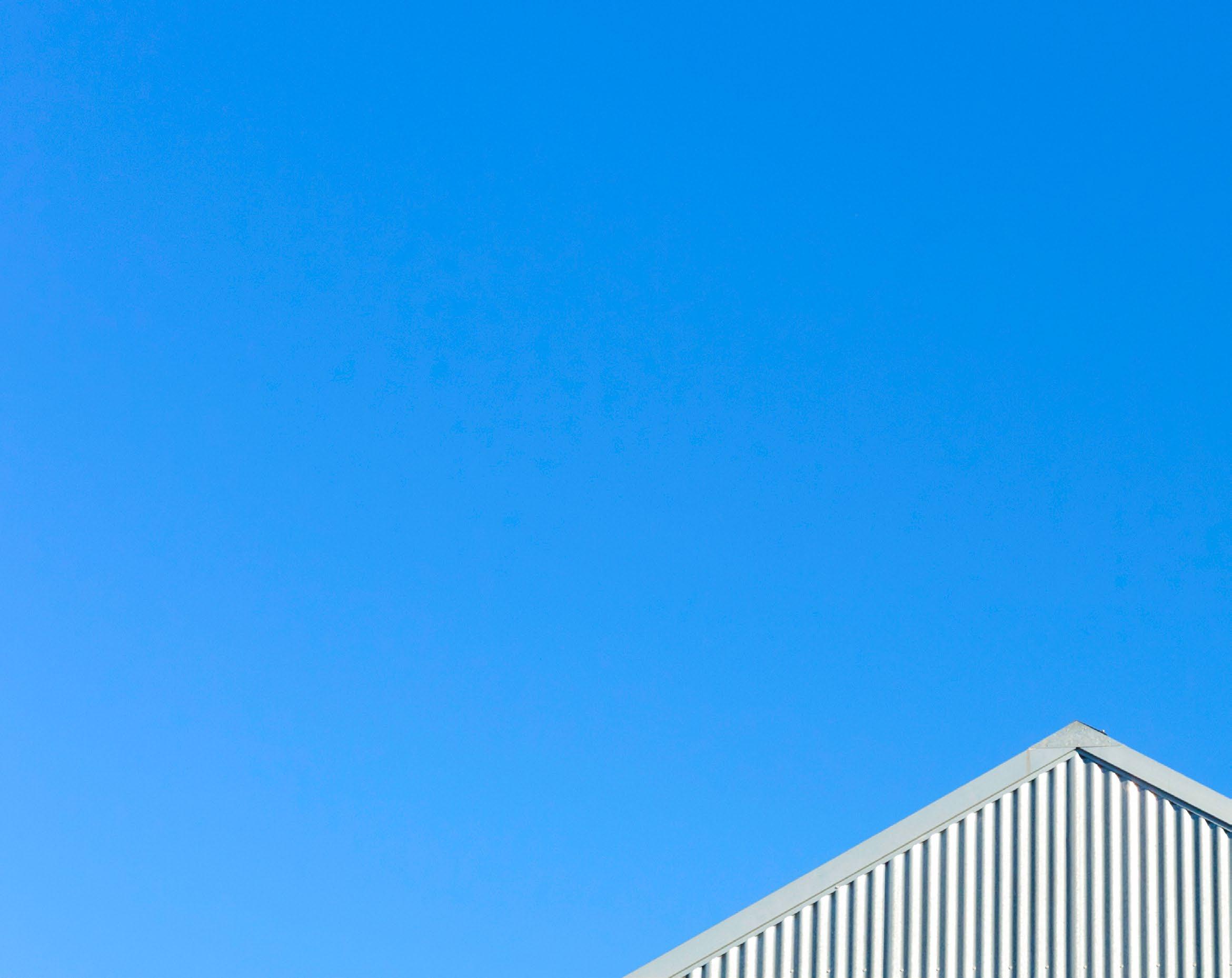
| STEEL AUSTRALIA | AUTUMN 2023 53 FEATURE: SKILLS AND EMPLOYMENT
CLICK HERE TO LEARN MORE ABOUT THE SHED BUILDERS COURSE >>>
NEW ASI MEMBERS
The Australian Steel Institute would like to welcome several new members who have joined over the last quarter. Just some of the benefits of ASI membership include: advocacy at the local, state and federal levels to advance the cause of Australian steel; member discounts on technical presentations, seminars, networking events and our Convention; regular industry news, as well as steel Australia magazine and Steel Construction journal; discounts on ASI publications and eLearning courses; technical advisory services, delivered by industry experts; opportunities to participate in specialist committees and groups, and so much more.
ASSOCIATE MEMBERS
CR Kennedy
T: 03 9823 1533
W: survey.crkennedy.com.au
A: 300 Lorimer Street, Port Melbourne Victoria
Ferrier Industrial
T: +64 2142 5206
W: ferrier-industrial-limited.business.site
A: 257 Princes Highway, Unanderra New South Wales
Freightquip
T: 03 9344 1370
W: freightquip.com
A: Unit 32, 1 International Drive Westmeadows, Victoria
MANUFACTURER MEMBERS
Maxispan
T: 1800 286 416
E: info@maxispan.com.au
W: maxispan.com.au
A: 26 Briens Road, Northfield South Australia
PROFESSIONAL MEMBERS
Kehoe Myers Consulting Engineers
T: 07 4632 8100
E: kmce@kehoemyers.com.au
W: kehoemyers.com.au
A: 124 Russell Street, Toowoomba Queensland
Tonkin
T: 08 8273 3100
E: adelaide@tonkin.com.au
W: tonkin.com.au
A: Level 2, 170 Frome Street, Adelaide South Australia
FABRICATOR MEMBERS
M2P Engineering
T: 07 3213 4600
E: admin@m2p.com.au
W: m2pengineering.com.au
A: 7/268 Evans Road, Salisbury Queensland
Mascot Steel
T: 02 9313 1313
E: sales@mascotsteel.com.au
W: mascotsteel.com.au
A: 25 Aylesbury Street, Botany New South Wales
Precise Way
T: 02 9197 0990
E: info@preciseway.com.au
W: preciseway.com.au
A: 27/13 Swaffham Road, Minto New South Wales
PSF Steel
T: (07) 5522 1717
E: mail@psfsteel.com.au
W: psfsteel.com.au
A: 2/5 Cahill Court, Burleigh Heads
Queensland
Steelcorp
T: 1300 668 133
E: info@steelcorp.com.au
W: steelcorp.com.au
A: 17 Buckler Road, North Wangaratta Victoria
UPDATED WIND CODE MODULES NOW AVAILABLE
Engineers will benefit from a new four-part course updating them on latest wind-loading standards for steel buildings.
The Australian Steel Institute (ASI) e-learning course covers key changes to AS/NZS 1170.2:2021 Wind actions and AS 4055:2021 Wind loads for housing. The National Construction Code (NCC) 2022 references both standards.
The course consists of on-demand pre-recorded presentations (video, audio and slides) guidance for engineers involved in the design of building projects that are subject to wind loads.
It covers the correct application of both standards to the design of steel structures, how the standards differ and how to correctly apply them to optimise the design of steel structures.

CLICK HERE TO PURCHASE THE COURSE >>>

CLICK HERE TO LEARN MORE ABOUT AUSTRALIAN STEEL INSTITUTE MEMBERSHIP AND JOIN TODAY >>>
ASI LIBRARY & BOOKSHOP UPDATE
Updated version of An Engineer’s Guide to Fabricating Steel Structures now available
ASI is pleased to confirm that the updated versions of An Engineer's Guide to Fabricating Steel StructuresVolumes 1 and 2 are now available.
The two volumes of the Engineers Guide to Fabricating Steel Structures form an important reference for engineers, detailers, constructors and other stakeholders who need to understand fabrication processes and the choices that need to be made in both designing and procuring steel structures.
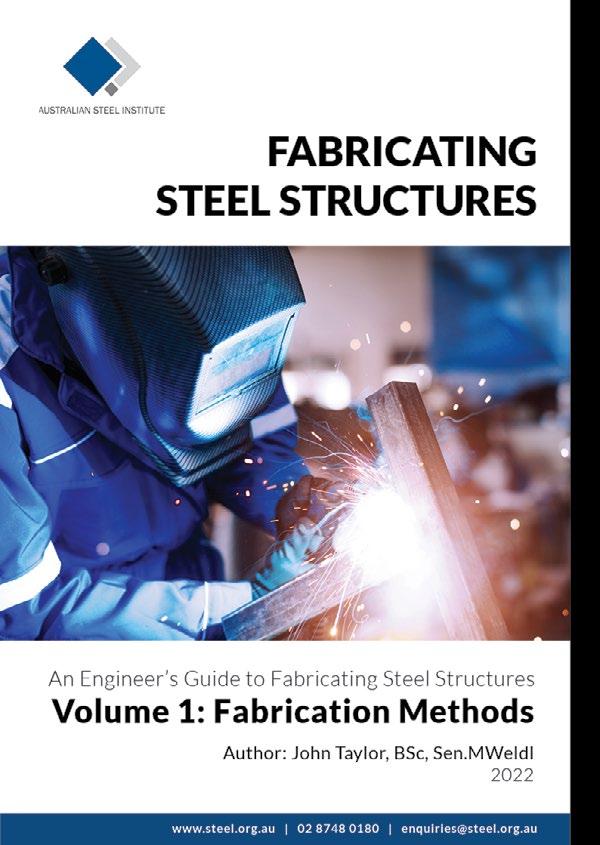
These new editions have been extensively updated with current references, fabrication techniques and alignment with contemporary Australian Standards.
Importantly, the context of the recently published AS/NZS 5131:2016
Structural steelwork – Fabrication and erection has been extensively incorporated, making these documents a most useful reference to those wishing to understand the processes behind the requirements in AS/NZS 5131.
Volume 1 Fabrication Methods provides the important background information on a range of different fabrication methods, which is a
handy reference for those required to understand fabrication to the extent necessary to undertake workshop or site inspection of fabricated steel structures. The steel material properties and procurement aspects are also extensively covered.
Volume 2 Successful Fabricated Steel Structures considers the design context and how decisions made by the designer can influence the properties and behaviour of the final steel structure.
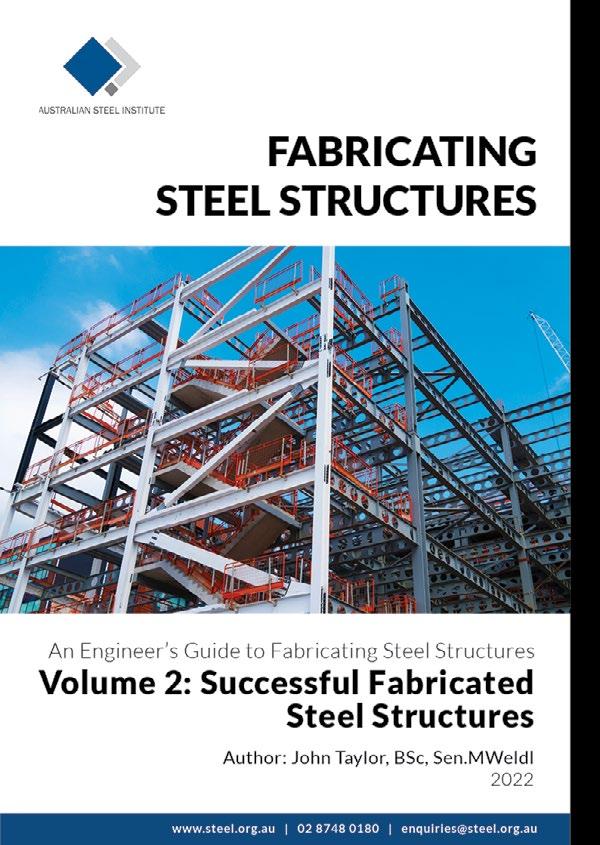
Welded connection detailing, fatigue, steel members and connections, residual stress and distortion, inspection and testing and management of fabrication quality are all covered, providing a solid grounding for all stakeholders.
These publications are available in hardcopy or as eBooks.
FURTHER INFORMATION
For further information, contact bookshop@steel.org.au.
UPCOMING ASI EVENTS
The ASI has several exciting events on the horizon, with subject matter ranging from steel detailing and construction modelling through to the design of steel bridges and portal frame buildings. Bookings will be available on our website as soon as dates are confirmed. Visit steel.org.au for further information.
| STEEL AUSTRALIA | AUTUMN 2023 55 INSIDE THE ASI
PURCHASE
Event Title Event Format Location Design of Cold-formed Steel Structures to AS/NZS 4600 Webcast Seminar Online Site Inspection of Structural Steelwork Webcast Seminar Online Paint Coatings for Steelwork Face to face Presentations Brisbane, Sydney, Melbourne, Adelaide, Perth Cold-Formed Steel from a Design and Fabrication Perspective Face to face Seminar Brisbane
HERE TO LEARN MORE ABOUT UPCOMING ASI EVENTS >>>
TO
ANY OF THE ASI'S BOOKS, SIMPLY CLICK HERE >>>
CLICK

ASI Members: Are You Taking Advantage of Your Member Benefits? 1 5 2 6 Advocacy at the local, state and federal levels to advance the cause of Australian steel Member discounts on technical presentations, seminars, networking events and conventions Member discounts on ASI bookshop publications and eLearning packages Superior technical advisory services, delivered by experienced industry experts 3 7 Regular industry news & steel Australia magazine and Steel Construction journal Opportunities to participate in specialist committees and groups to address steel industry issues 4 8 For corporate members, promotion in the ASI Directory and use of the ASI logo Countless other benefits from joining and networking with a community of likeminded companies & people www.steel.org.au | +61 2 8748 0180 | enquiries@steel.org.au














 Mark Cain Chief Executive Australian Steel Institute
Mark Cain Chief Executive Australian Steel Institute




























 Glen Kovacevic (Project Manager, Civmec)
Glen Kovacevic (Project Manager, Civmec)







 CLICK HERE TO LEARN MORE ABOUT ALBURY GALVANIZING AND THEIR CAPABILITIES >>>
Kettle dip at Albury Galvanizing.
Galvanized steel, ready for transportation.
Heston Blumenthal, a key advocate of AQUANA Sustainable Murray Cod.
CLICK HERE TO LEARN MORE ABOUT ALBURY GALVANIZING AND THEIR CAPABILITIES >>>
Kettle dip at Albury Galvanizing.
Galvanized steel, ready for transportation.
Heston Blumenthal, a key advocate of AQUANA Sustainable Murray Cod.















 Newly assembled Horseshoe Lagoon Bridge. CLICK HERE TO LEARN MORE ABOUT
Newly assembled Horseshoe Lagoon Bridge. CLICK HERE TO LEARN MORE ABOUT
























